Mark & Miles Nolting in Zambia & Zimbabwe
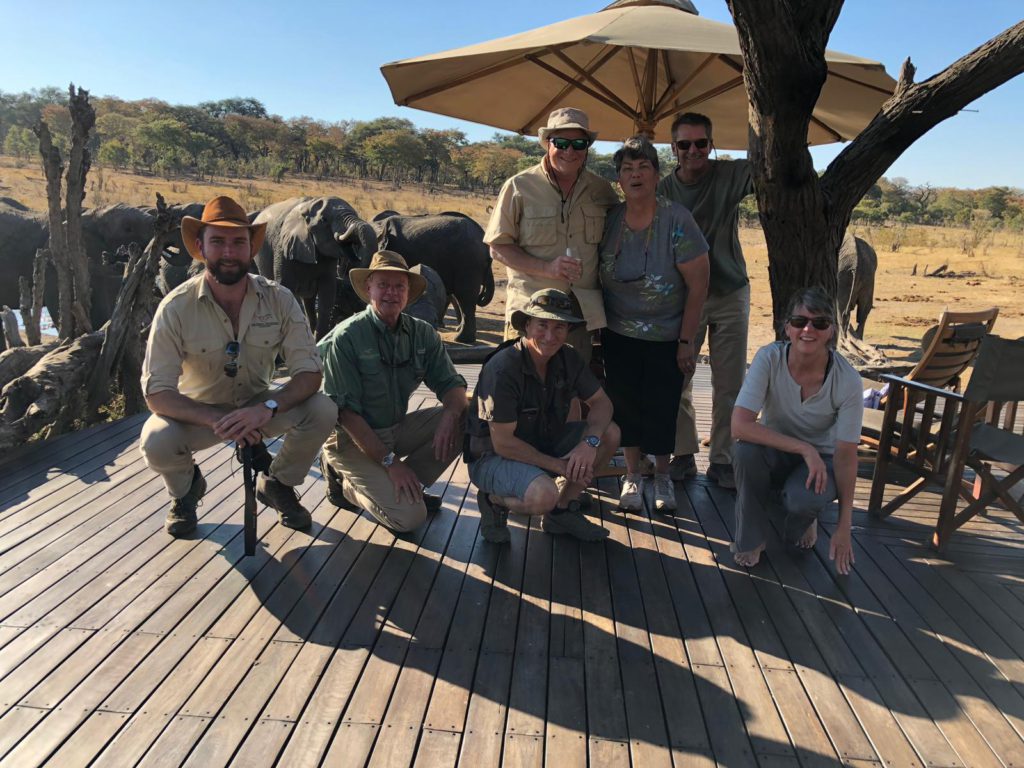
Pre-Departure
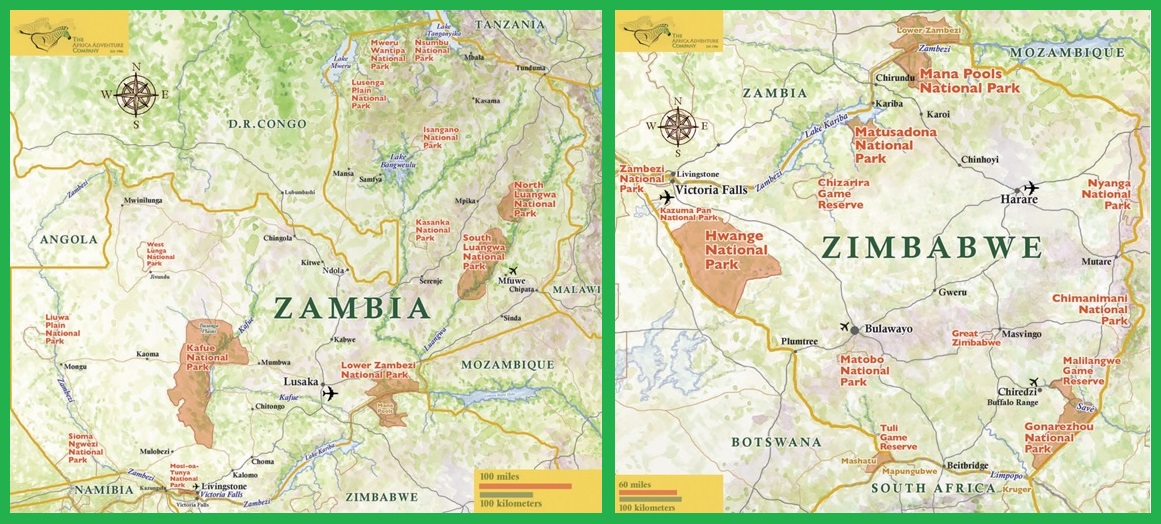
It’s not too often a guest gets this kind of an opportunity for such an immersive walking & canoeing safari experience. Zimbabwe & Zambia were chosen because they are prime destinations for these kinds of safaris. This ultimate reason for this is the quality of the countries’ private guides, two of whom Mark and Miles experienced first-hand!
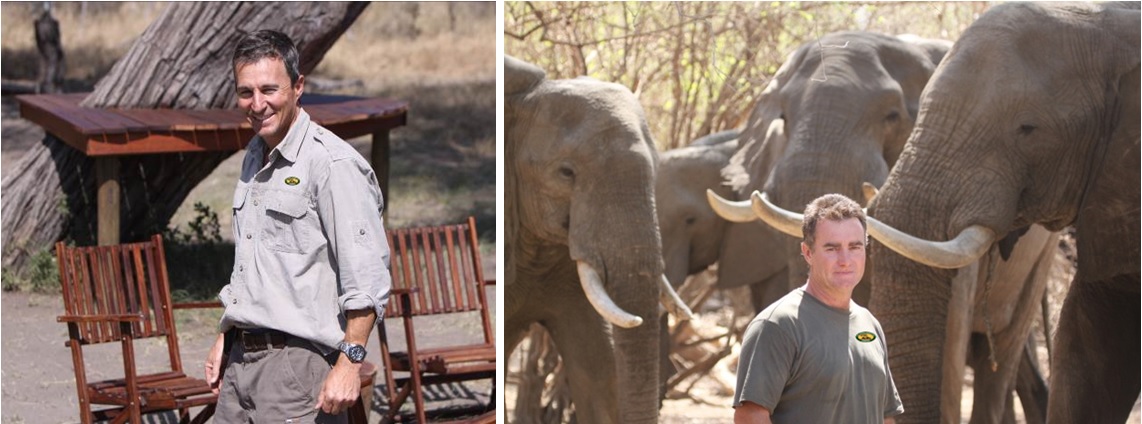
Nic Polenakis is the featured specialist guide while the group is in Hwange National Park. He was featured in National Geographic Traveler Magazine as one of the World’s Top 10 Tour Guides; quite the accolade! From the comfort of his own camp, Somalisa Acacia, The group will surely be transfixed by his expansive knowledge, but also his contagious passion.
When the group proceeds to Mana Pools National Park, the specialist guide Nick Murray will take the reins. Nick Murray owns & operates Vundu & Little Vundu Camps in Mana Pools National Park. These two camps are ideally situated for what Nick does best: walking & canoeing safaris. The group eagerly anticipated seeing some Elephants, Wild Dogs, and who knows what else!
The trip also promised an incredible chance to witness elephant collarings in Mana Pools. What Miles and Mark did not expect, however, was the degree that they were able to participate in the process and the amount of collarings that occurred while they were there!
Here is their finalized itinerary:
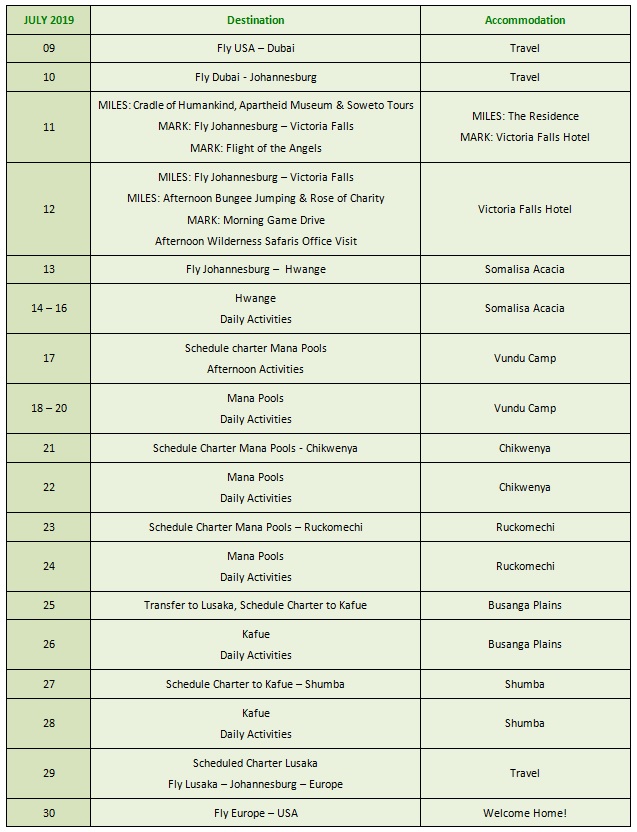
July 11th-12th: Johannesburg & Victoria Falls
For the first day of their adventure, Mark and Miles split up. Mark went directly to Victoria Falls, while Miles remained in Johannesburg.

Before beginning a full-day of touring, Miles was able to have an early check-in at his charming boutique hotel, The Residence.
Only a 20 minute drive from the airport, it proved to be a perfect hotel for a day’s worth of sightseeing. For those who want an atypical luxury hotel, you will admire the hotel’s and residential-like design and eclectic aesthetic. He particularly enjoyed the Madiba Suite where he slept, especially its very cool Nelson Mandela motif.
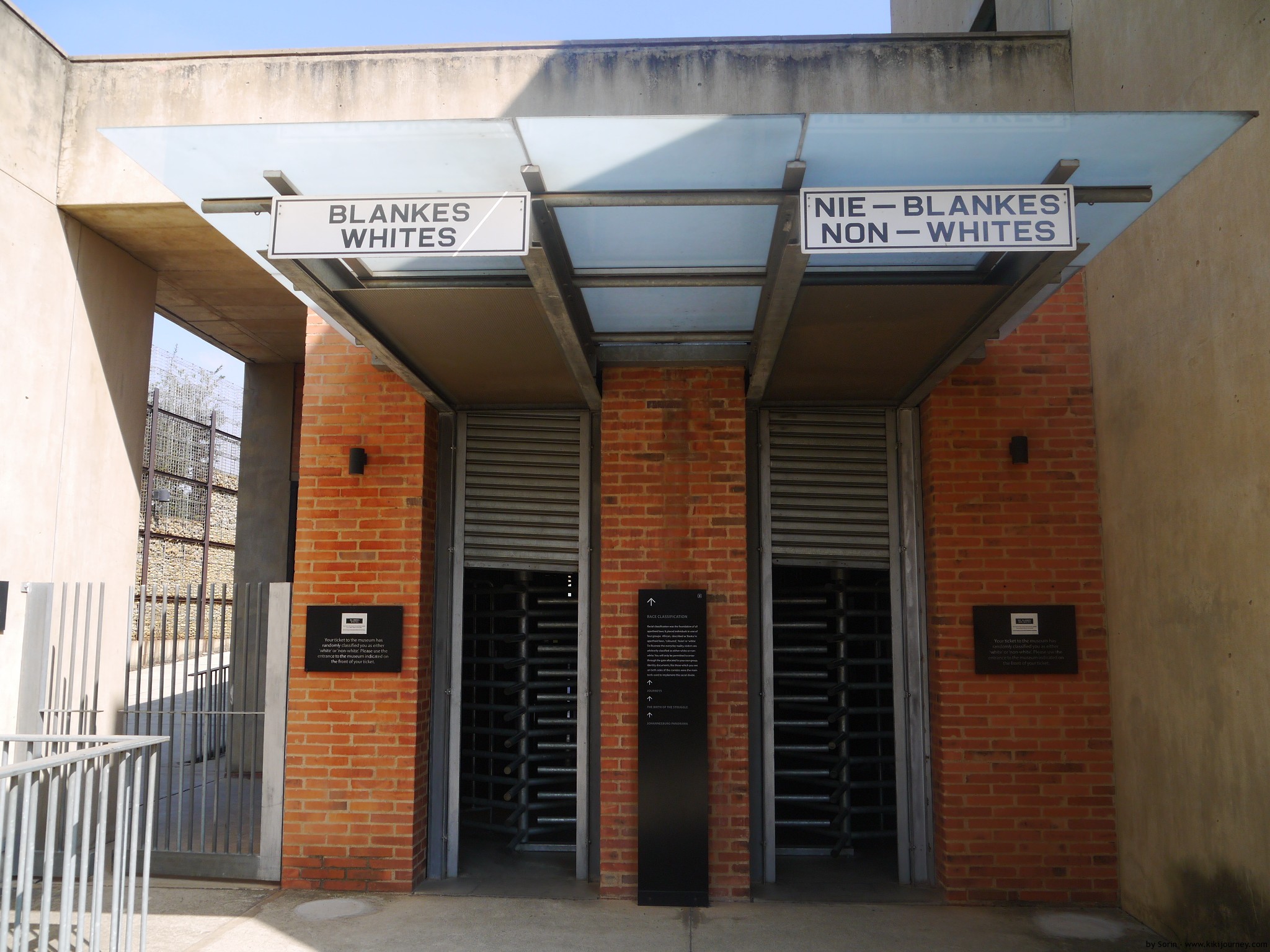
Miles’ day of touring was divided into three parts: the Cradle of Mankind and the Sterkfontein Caves, then the Soweto Township, finishing with a tour of the Apartheid Museum.
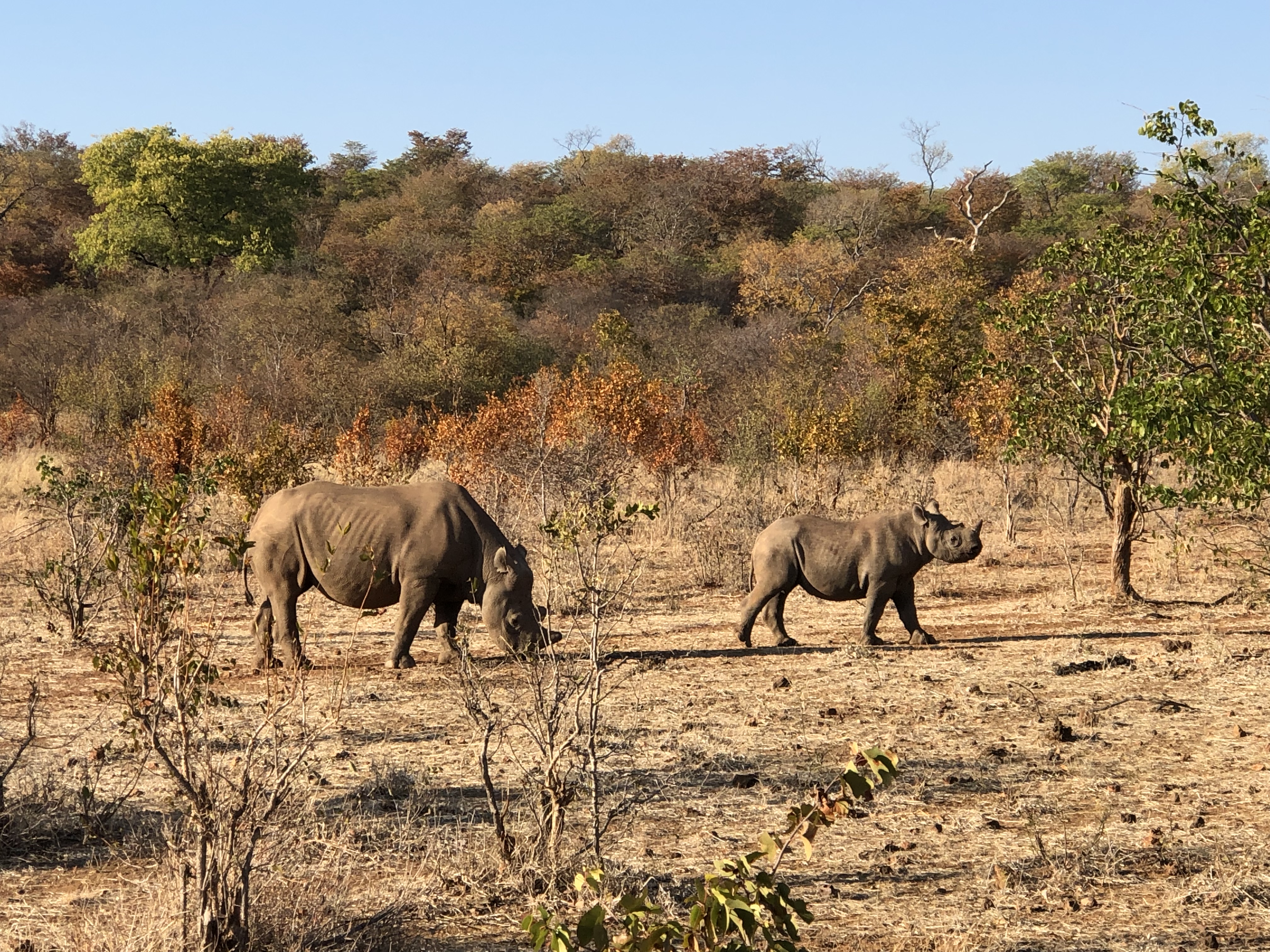
The following day, Mark crossed over to Zambia early in the morning to visit Mosi oa Tunya National Park. He was greatly looking forward to approaching white rhino on foot – the experience did not disappoint!
Miles then flew into Victoria Falls later that morning. His plan for the afternoon was to bungee jump at the Victoria Falls Bridge – thrilling, to say the least! Here’s some video footage:
Before dinner, they met up to visit the Wilderness Safaris office. Many of the staff members have been there for over 20 years and have been indispensable partners for AAC.
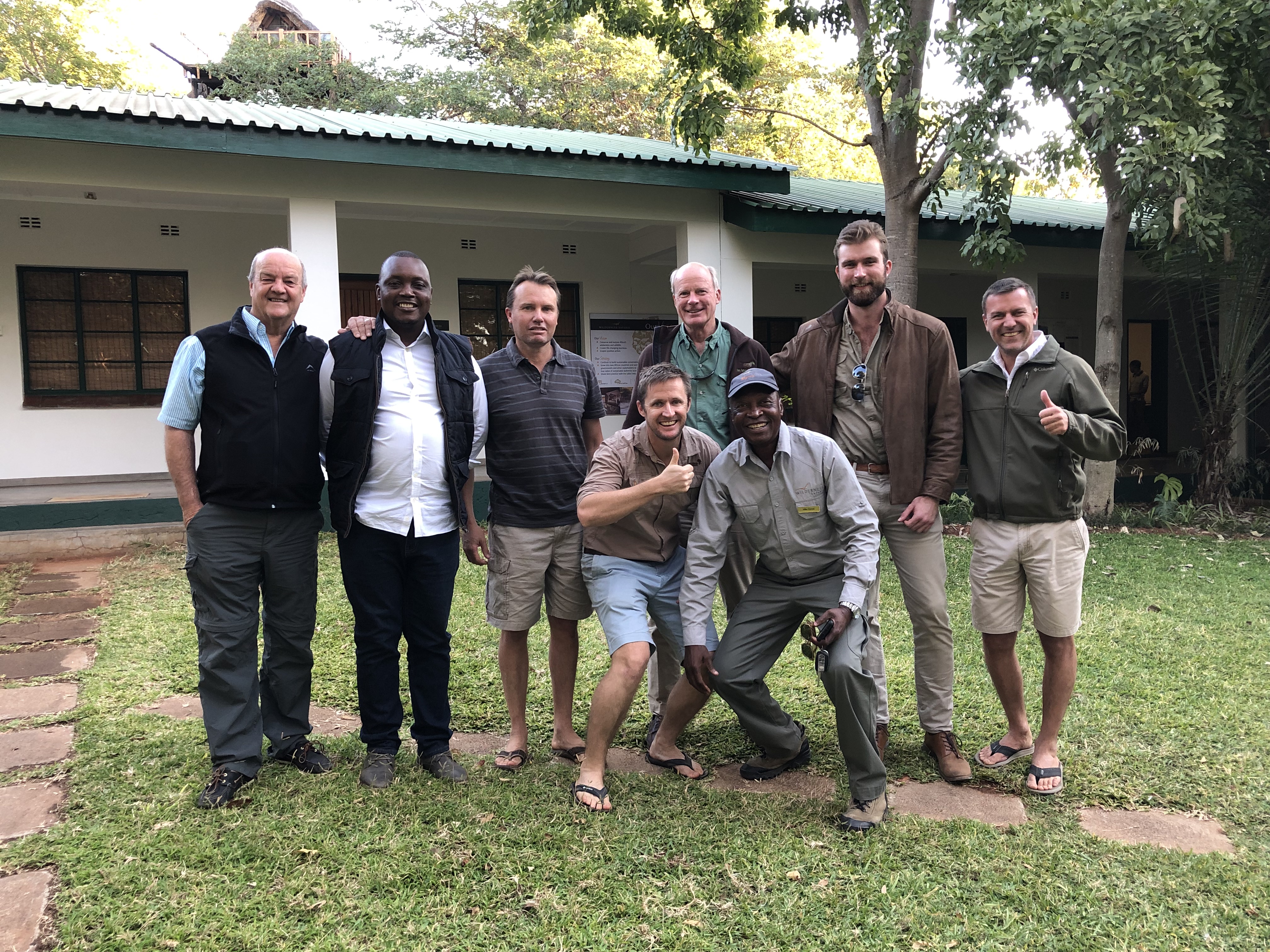
For dinner, Mark and Miles dined at the Victoria Falls Hotel’s patio. The Victoria Falls Hotel is one of those places that exudes a timeless quality. Even if you aren’t staying at the hotel itself, we highly recommend visiting for a drink, meal, or perhaps high tea!
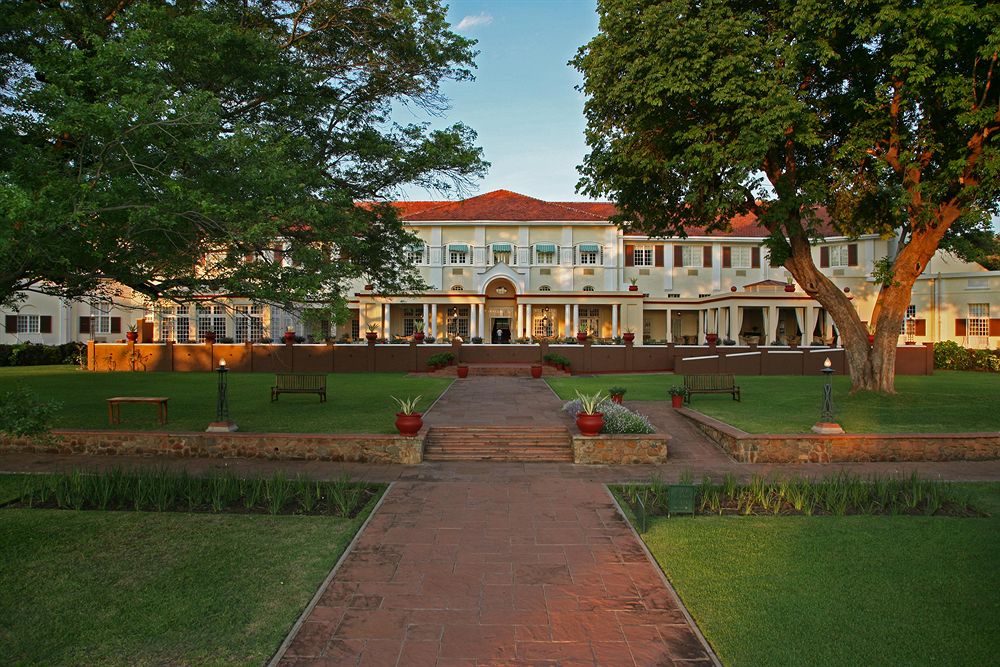
The following morning, they woke up very early in order to go on the Flight of the Angels. An aerial view from a helicopter is a perfect way to complement seeing Victoria Falls from the ground!
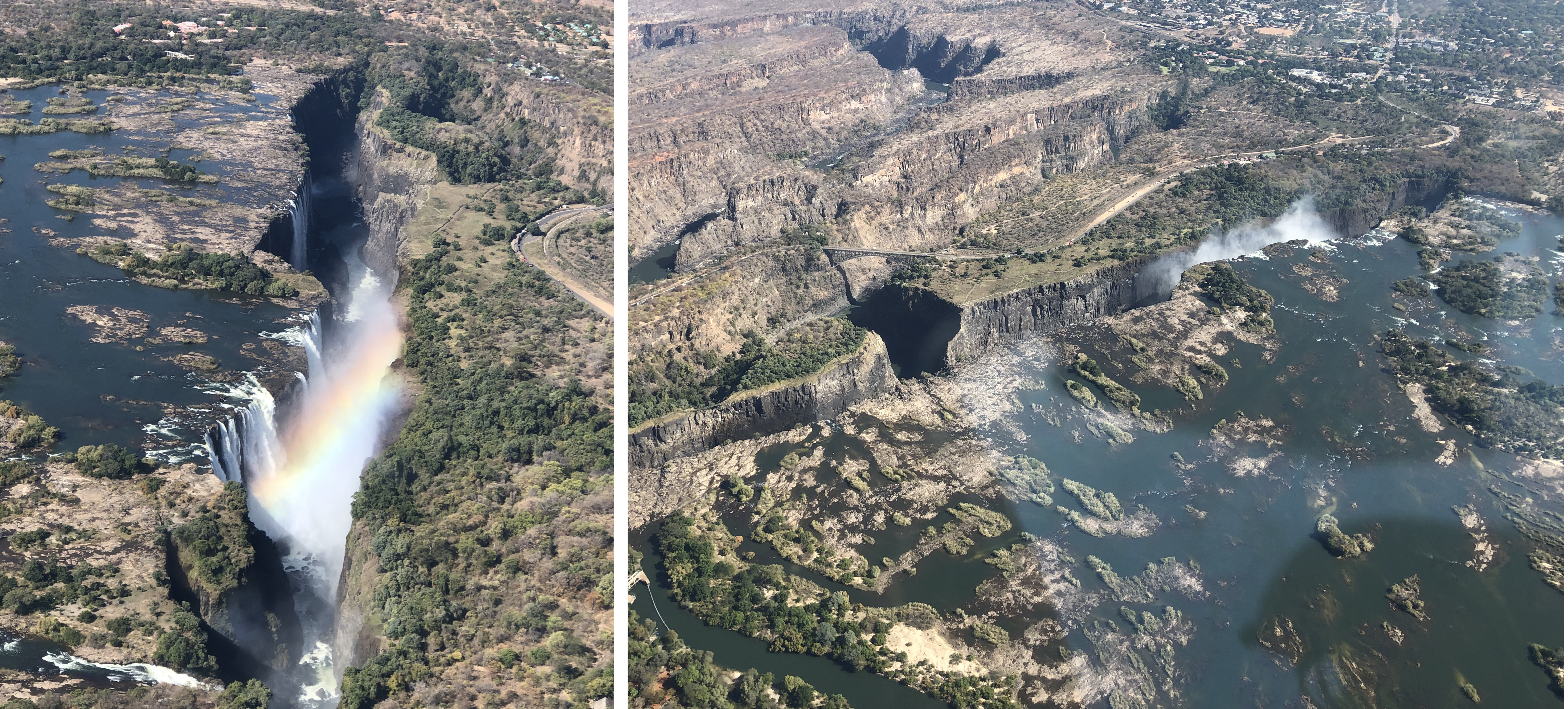
Before checking out of the Victoria Falls Hotel, they had a chance to grab breakfast with two of AAC’s favorite private guides – Nic Polenkais and Dave Carsons. The former was to accompany Miles and Mark as their private guide for the next leg of their trip – Hwange National Park!
July 13th-16th: Somalisa Acacia – Hwange
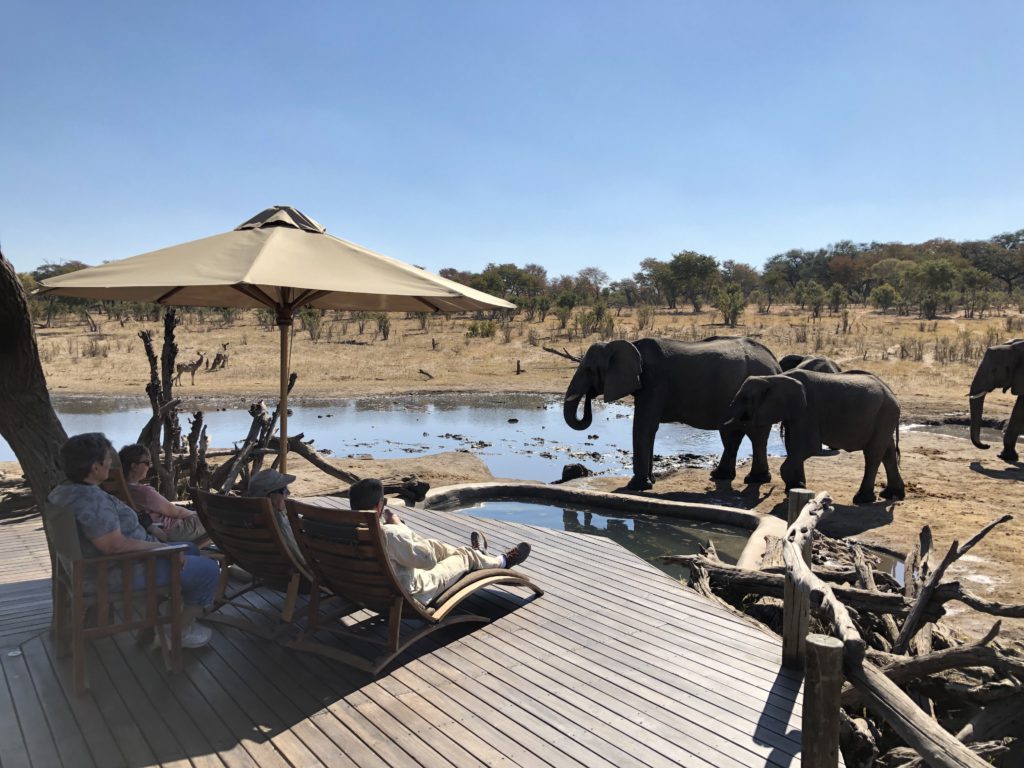
July 13th: Somalisa Acacia – Hwange
The following morning, Mark, Miles and Nic met the 4 guests accompanying them on the Eyes on Elephant group safari at the Victoria Falls airport. After an hour-long charter flight to Hwange National Park, the wildlife sightings began immediately – several hundred meters from the airstrip was a large her of elephants enjoying the sweet water pumping from one of Hwange’s many waterholes!
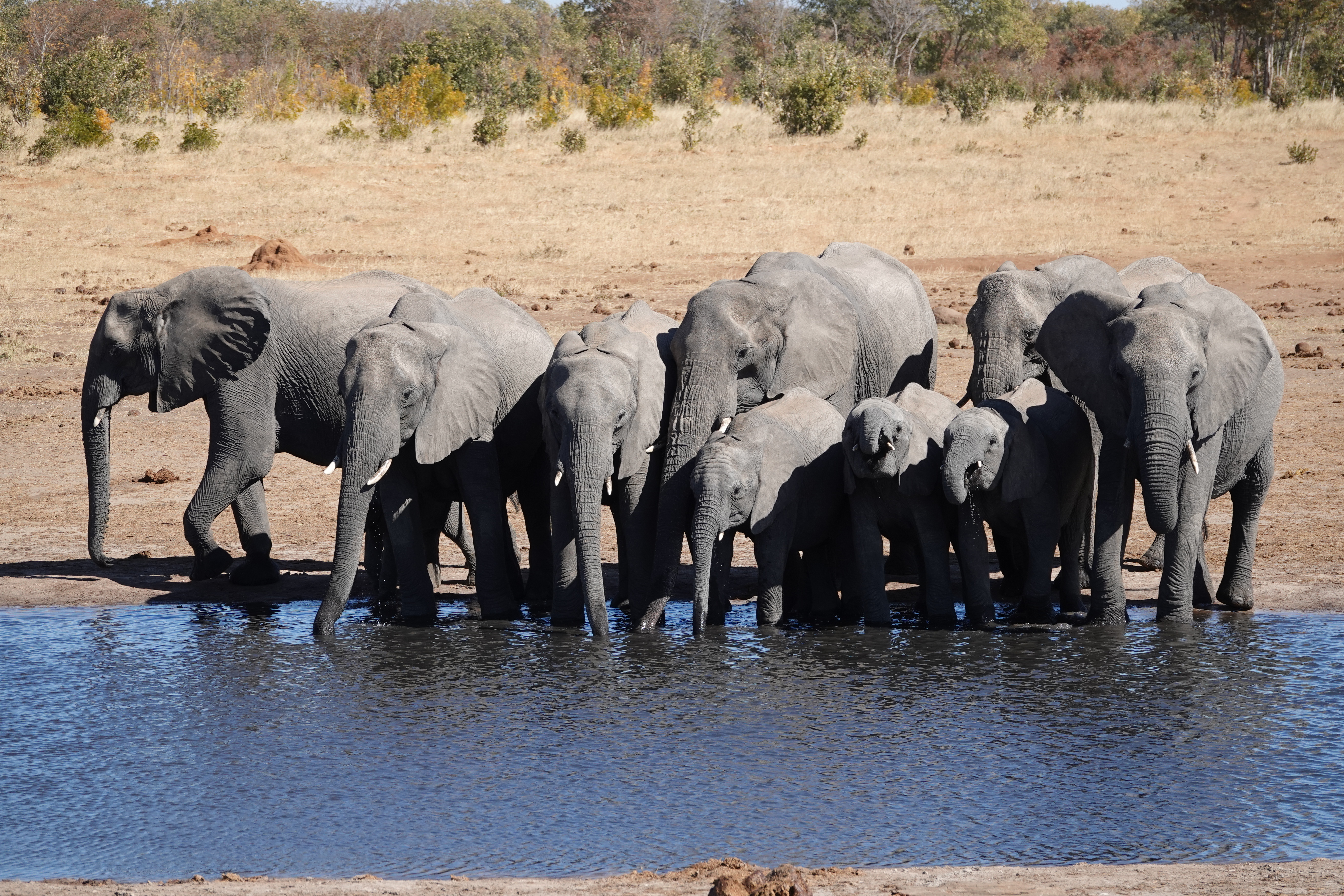

We then arrived at Somalisa Acacia for lunch. Somalisa Acacia is an exclusive-use camp, meaning guests can reserve the entire 4-tent camp for their group. This is especially ideal for multi-generational families, as 1 of the 4 tents is a 2-bedroom family suite. For groups who do not mind non-exclusive use, the 7-tent Somalisa Camp is located next door. The architecture and decor are very similar at both camps, each featuring a lovely dining area and pool for those particularly hot days. And yes, as you saw in the picture above, you can get that close to elephants!
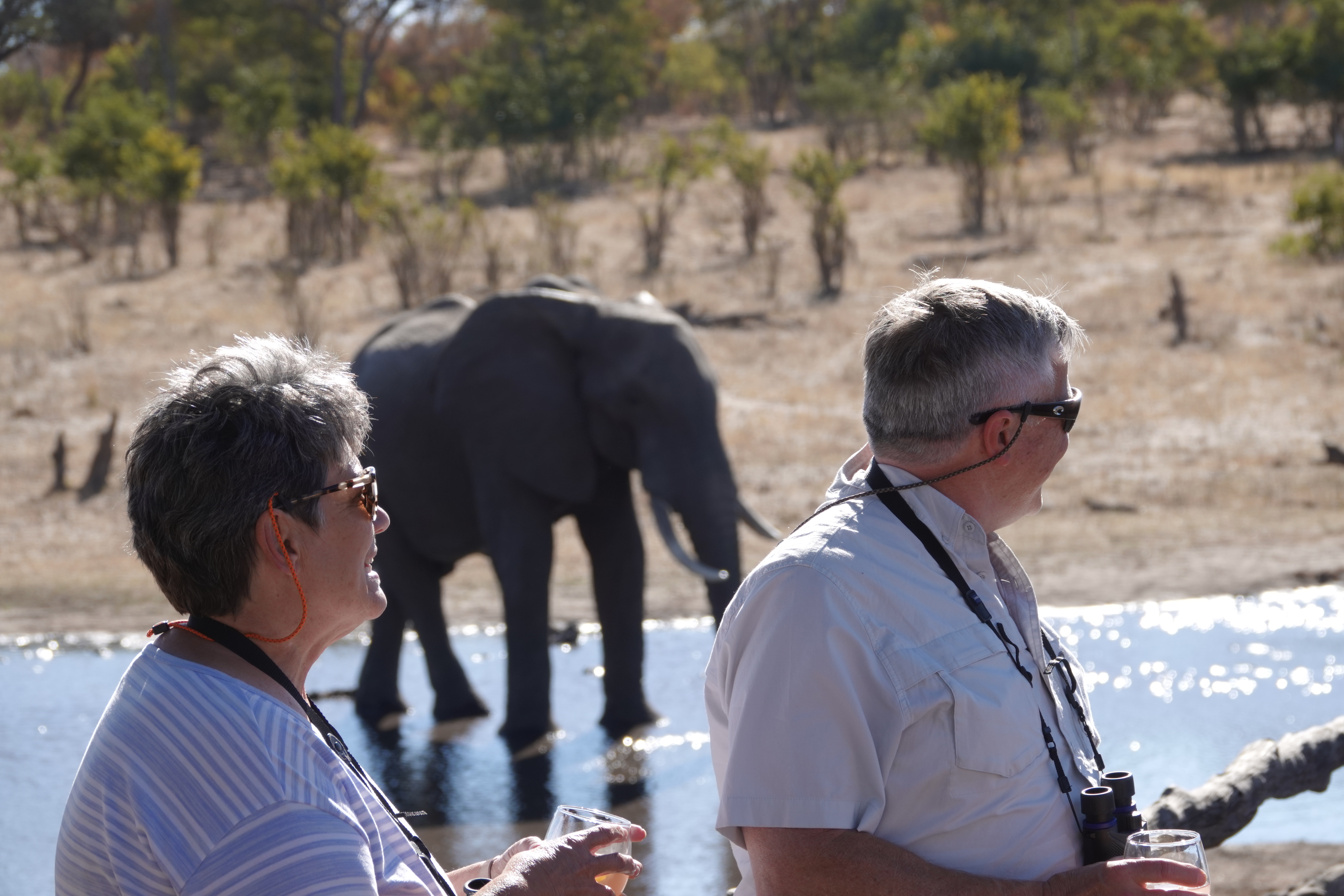

The afternoon was more of the same – elephants! En route for sundowners, Mark & Miles encountered a massive bull elephant – and sat in awed silence as he crossed right in front of our vehicle!
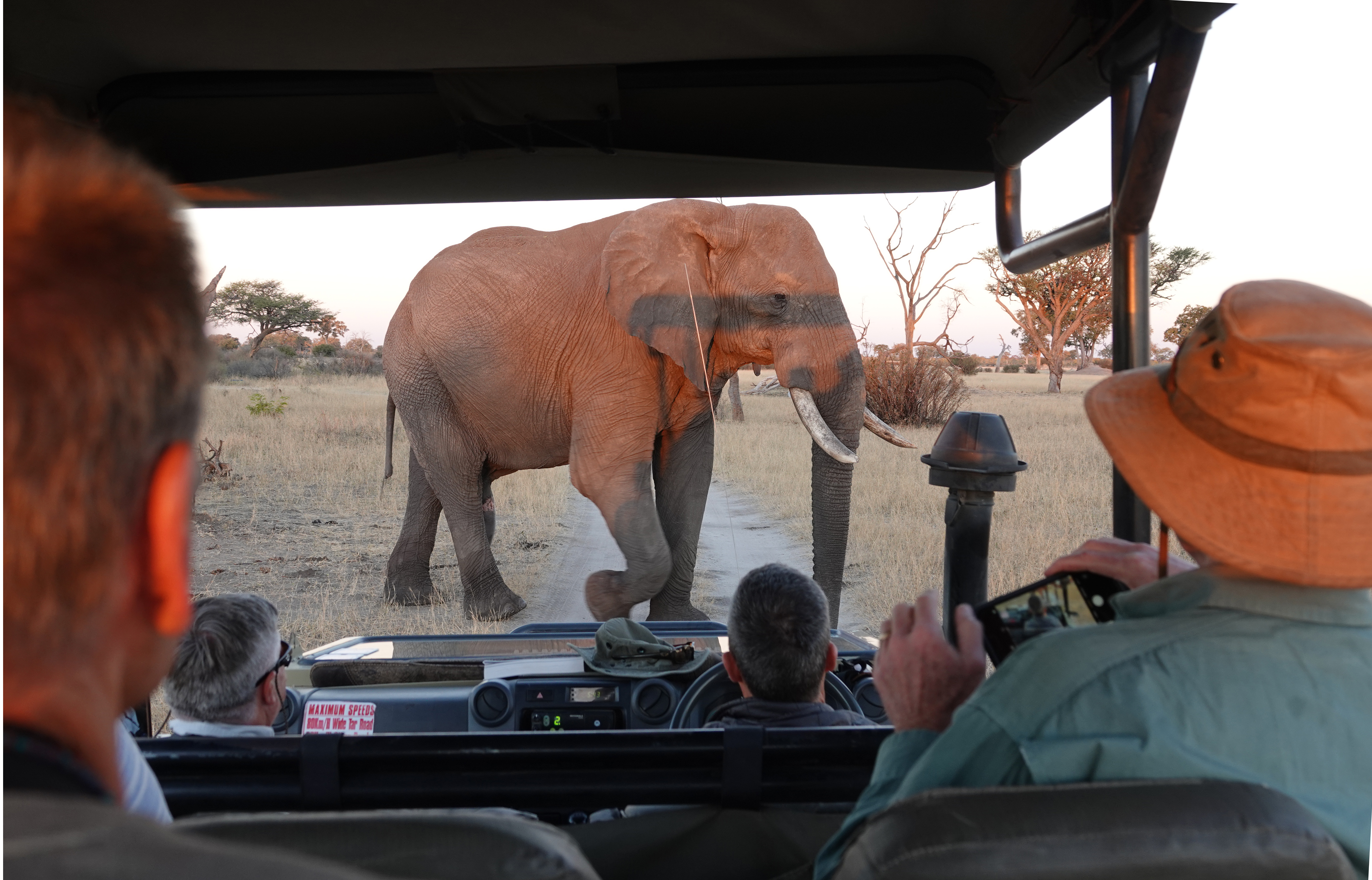
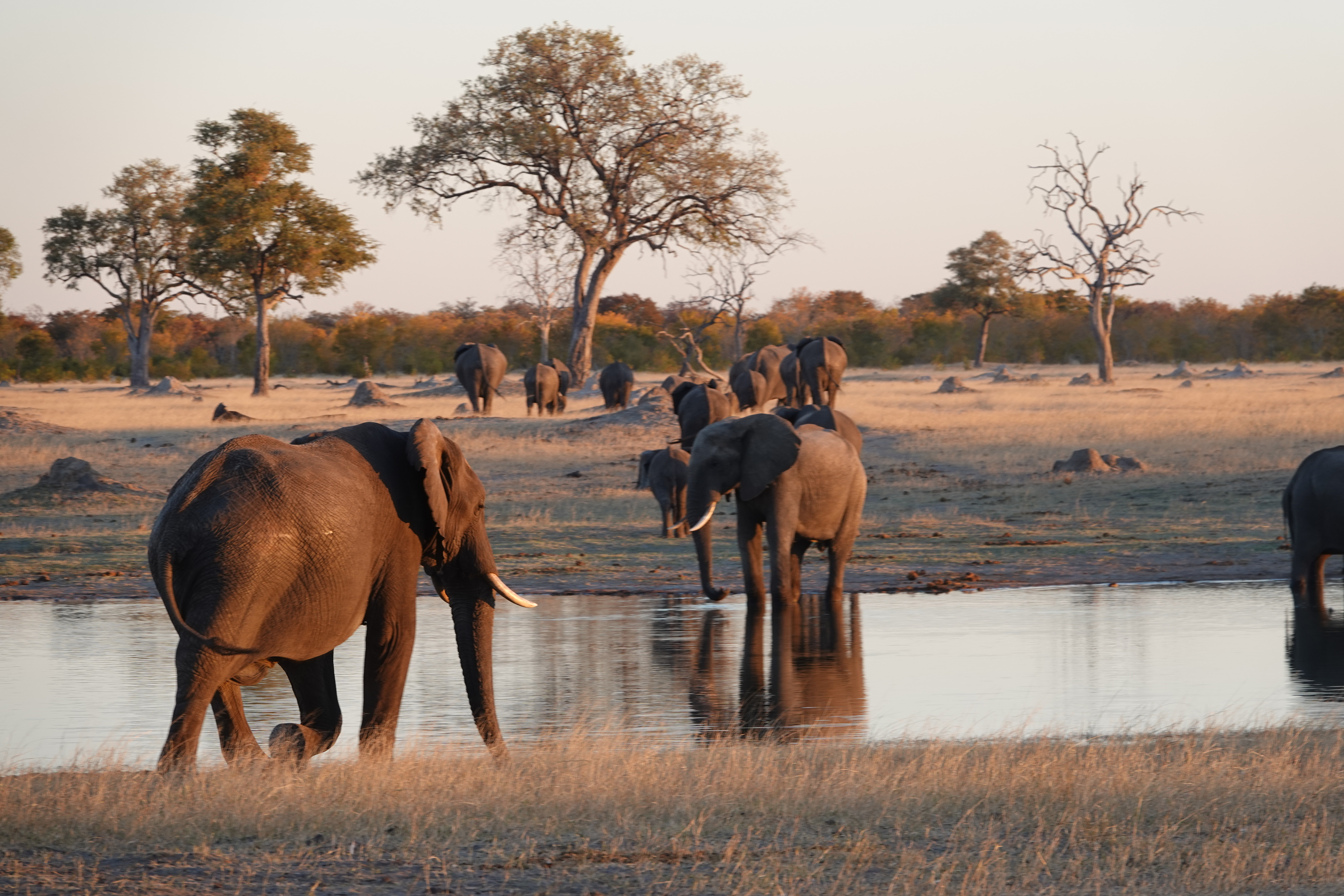
Our guide Nic then picked out a perfect spot to conclude our day – the beautiful golden light of twilight softly illuminating the countless elephants coming down to the waterhole was breathtaking!
July 14th: Somalisa Acacia – Hwange
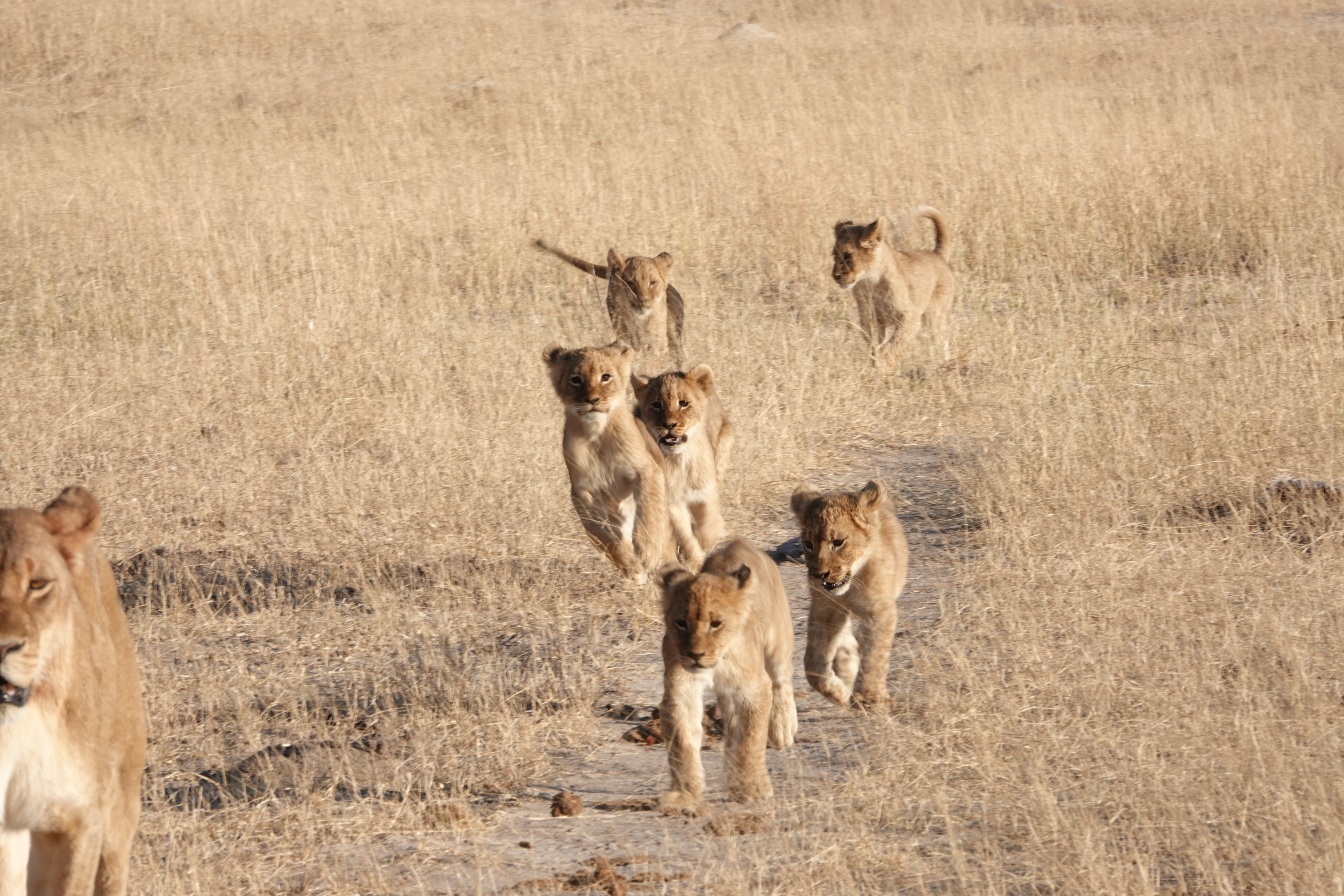
The next morning, everyone was abuzz – and not just because we were trying to warm up in the frigid morning weather. We made a plan to track some lioness and their cubs – which meant leaving earlier than normal! The earlier and colder start was totally worth it – in the soft light of early morning, we saw 6 cubs frolicking close behind their mom on their way to a waterhole!
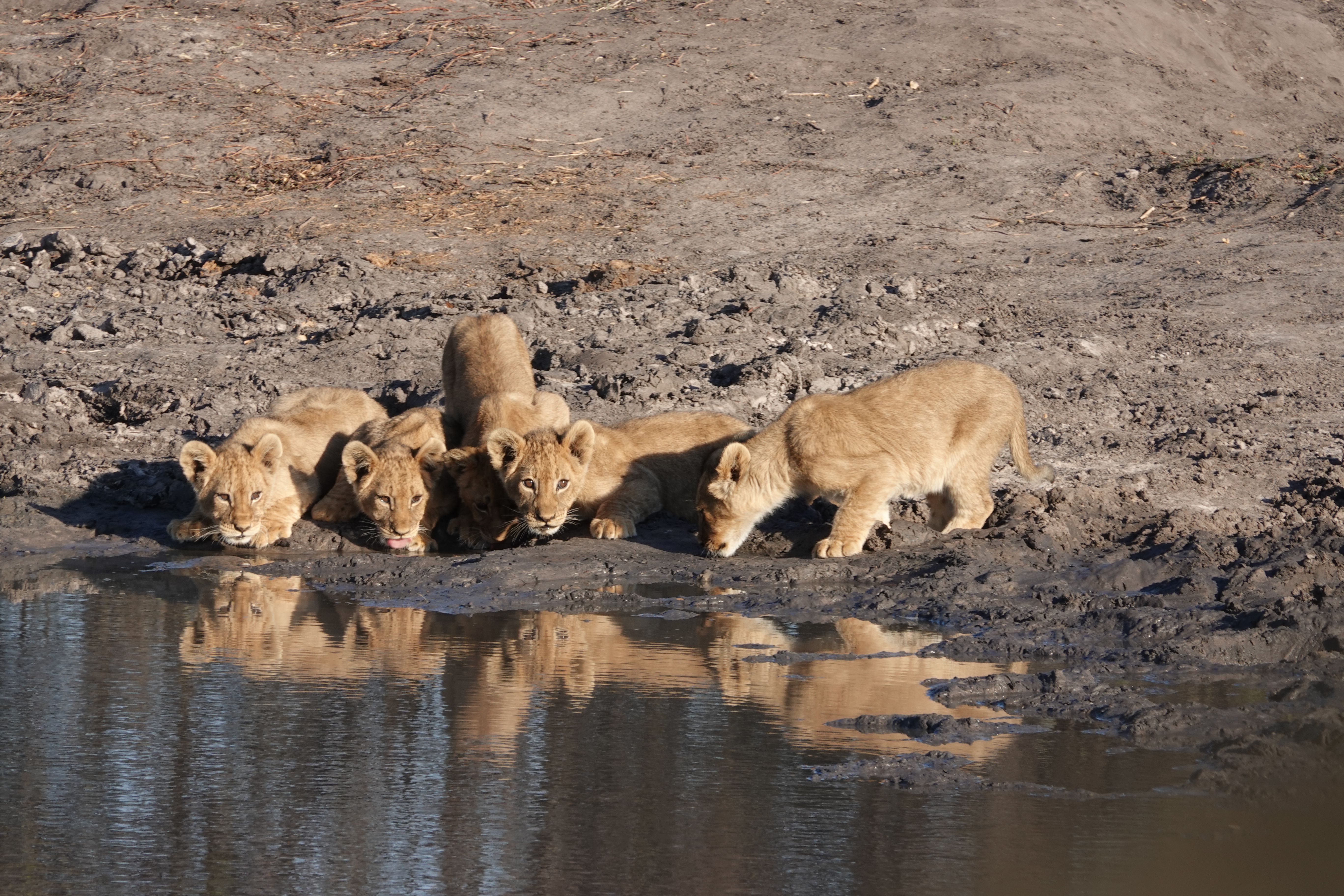
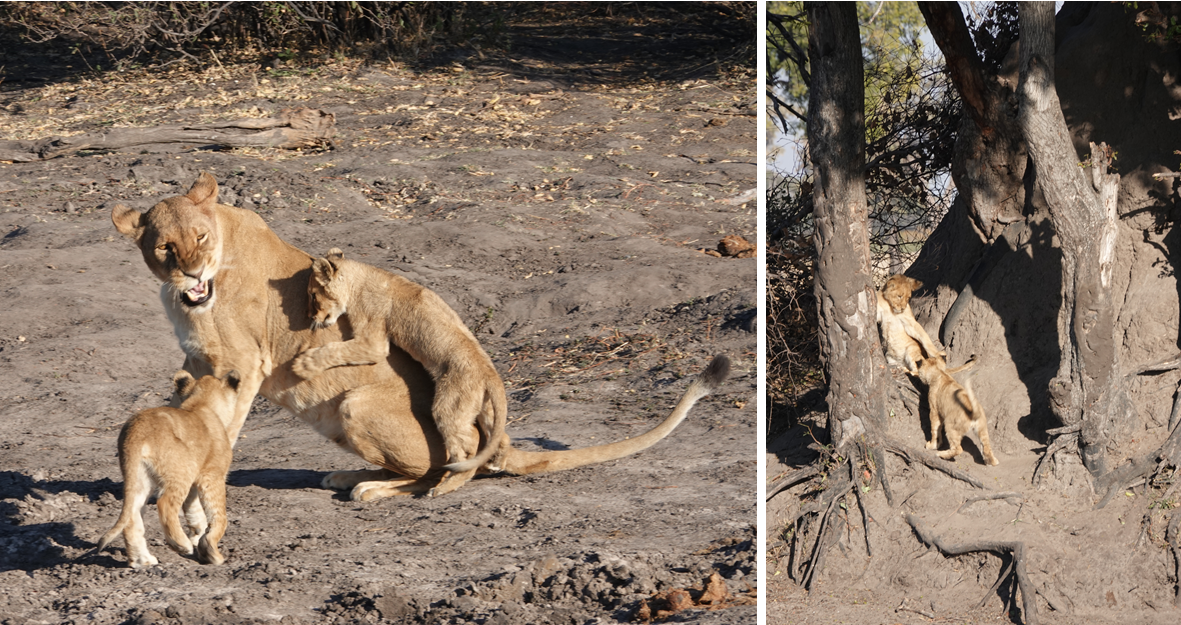
Nic Polenakis, our private guide, was astounded by our sighting – it’s not too often you get lion cubs playing out in the open for this long! They spent hours just sitting around, watching these cubs have the time of their lives!
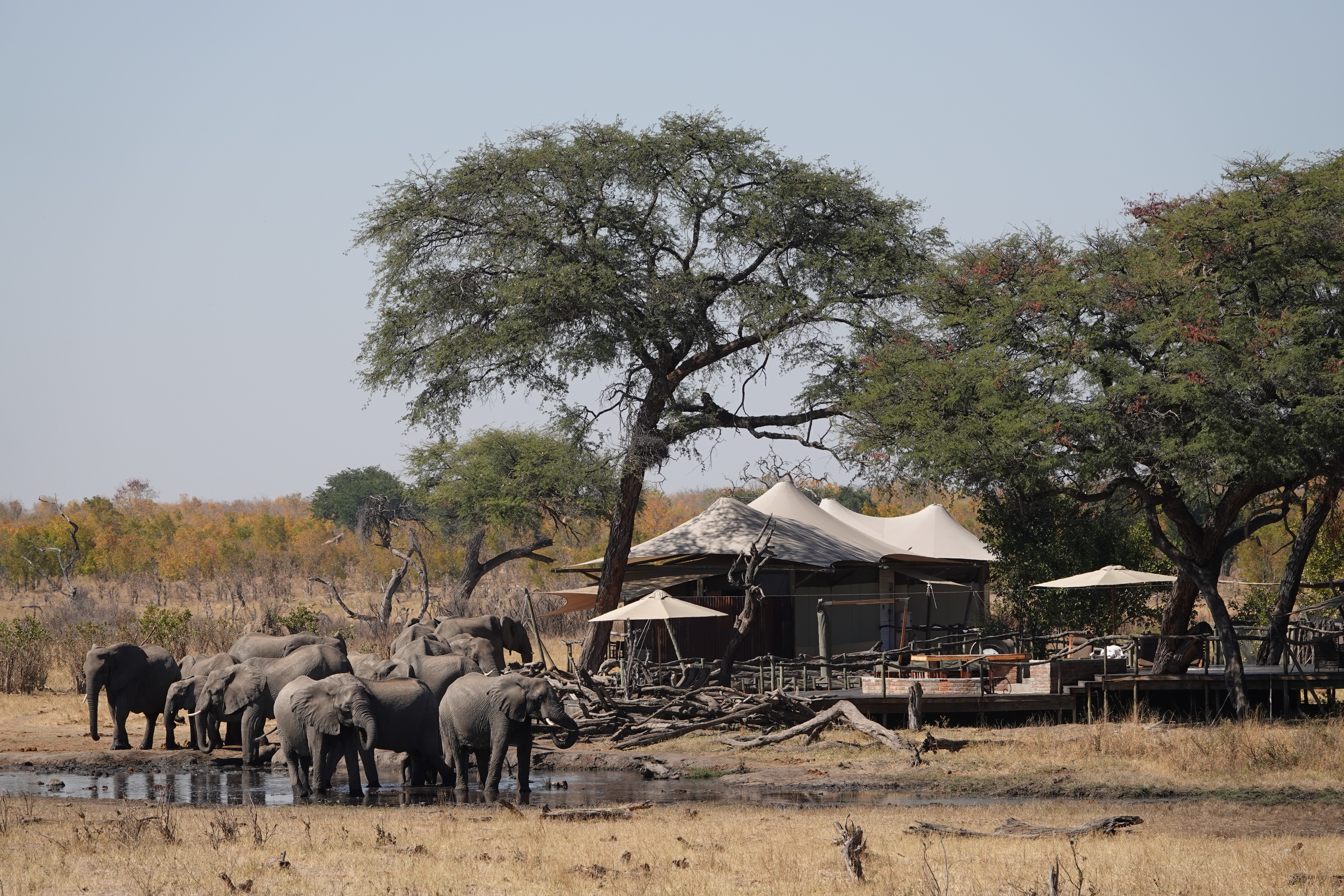
Just before arriving back at Somalisa Acacia for lunch, we were greeted by a herd of elephants drinking and washing themselves at the camp’s waterhole. No two meals were the same, remarkable considering how remote the camp is.

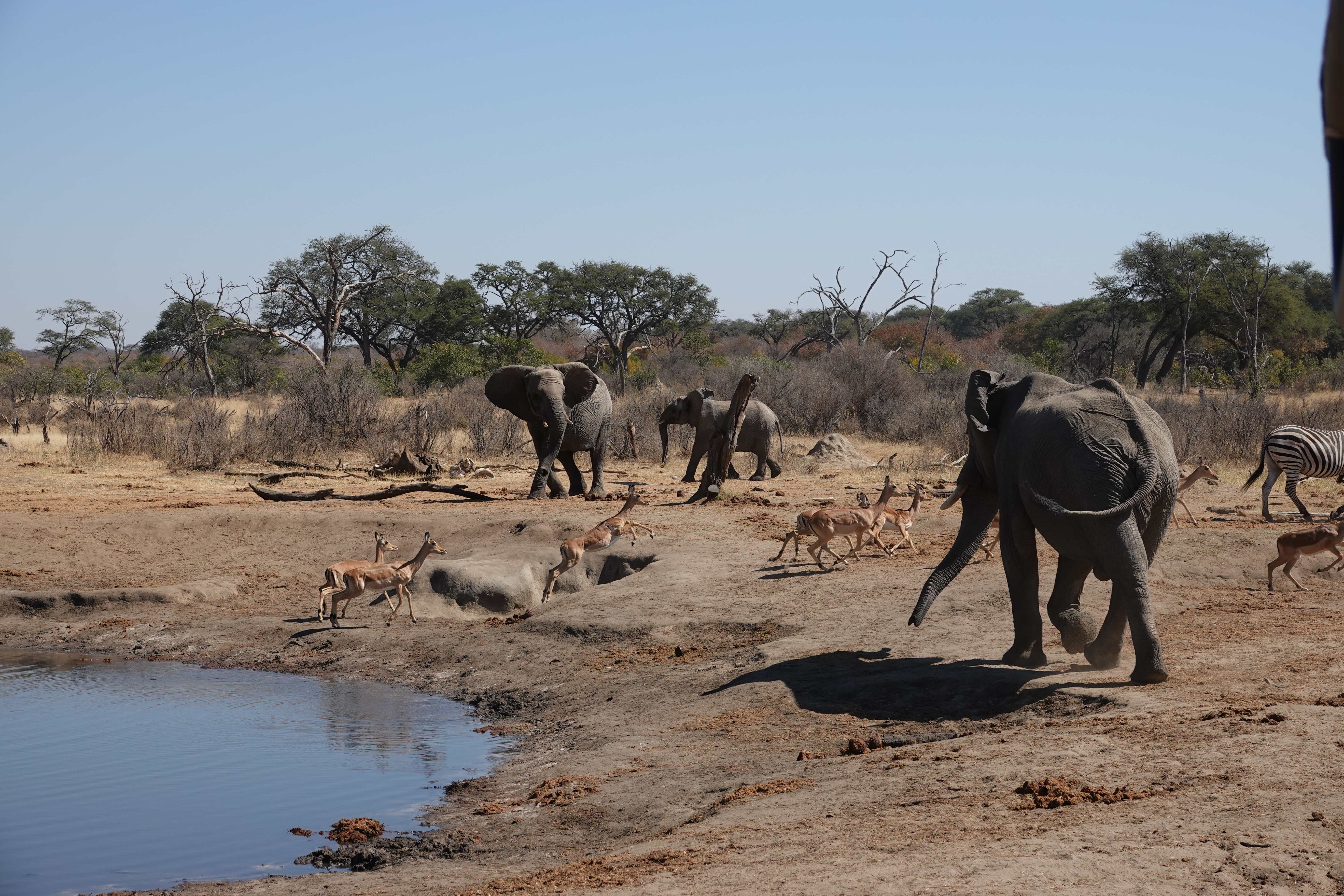

After everyone took their siestas, they embarked on another eventful afternoon. We made an early stop at a different elephant- occupied waterhole – and got out of the vehicle to enjoy them on foot! We also found out elephants can act like bullies around waterholes – as the young bull chasing away the harmless impalas shows. There was yet more instances of baby elephants playing around – the one above burrowed his head into the ground, before falling down and squirming around underneath his mom!


Other than lions and elephants, the group also spotted a solitary waterbuck, some giraffe, and kudu. The day game to close, but quite by accident. The group was planning to have a sundowner at a waterhole, just as yesterday. But Nic spotted a unique photographic opportunity for his guests: a small herd of elephants dusting themselves within the glowing sunset light. So instead, they stopped, and took photographs until the dramatic luminous effect ceased.
July 15th: Somalisa Acacia – Hwange
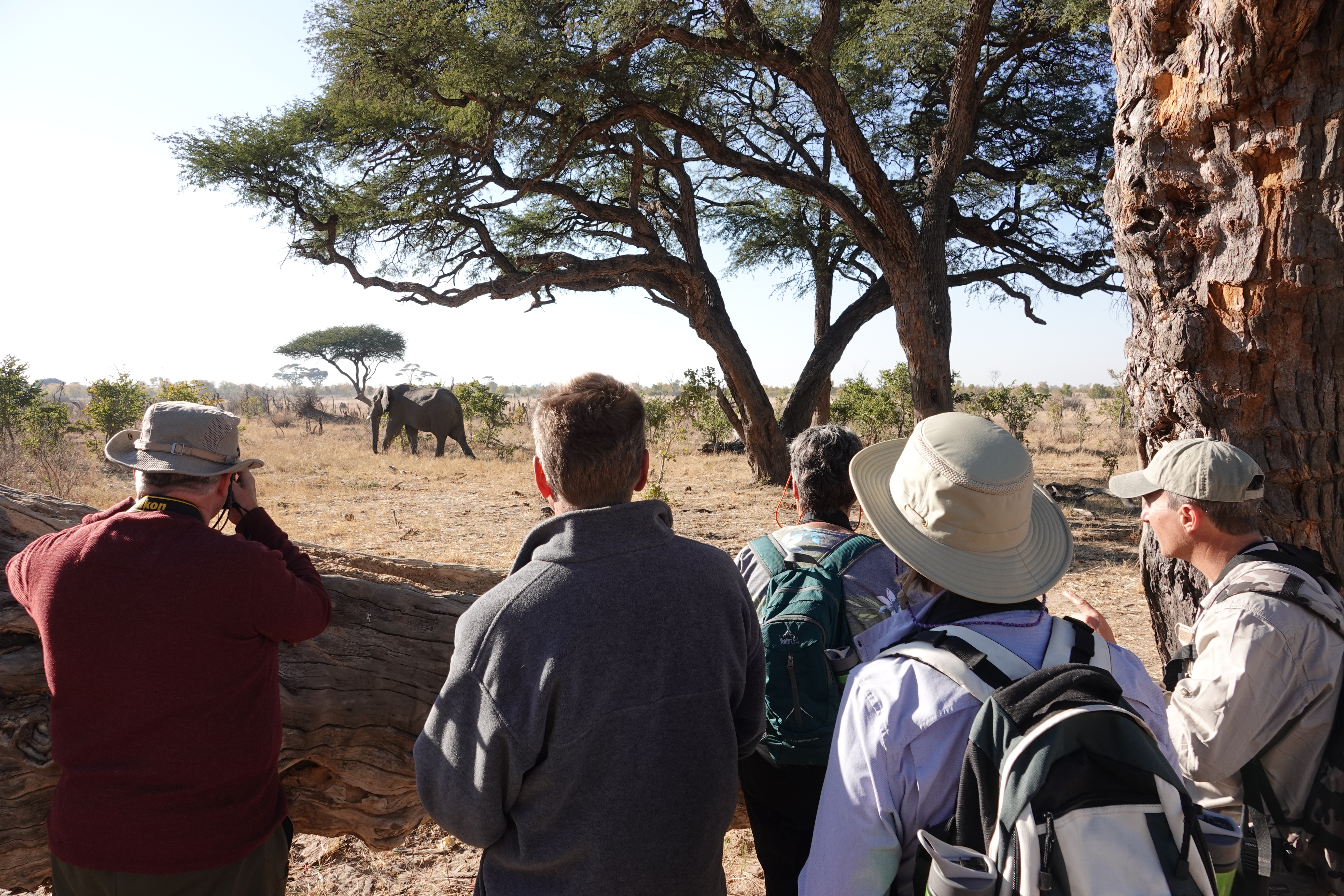
The following morning, the group was just as excited as the previous day: today was to be their first walking safari! But they were delayed, for the pride of lions they saw yesterday was joined by two males. The group sat, enjoying the roaring of the two males. Because it was so called, you could even see the cold breath of their roaring!
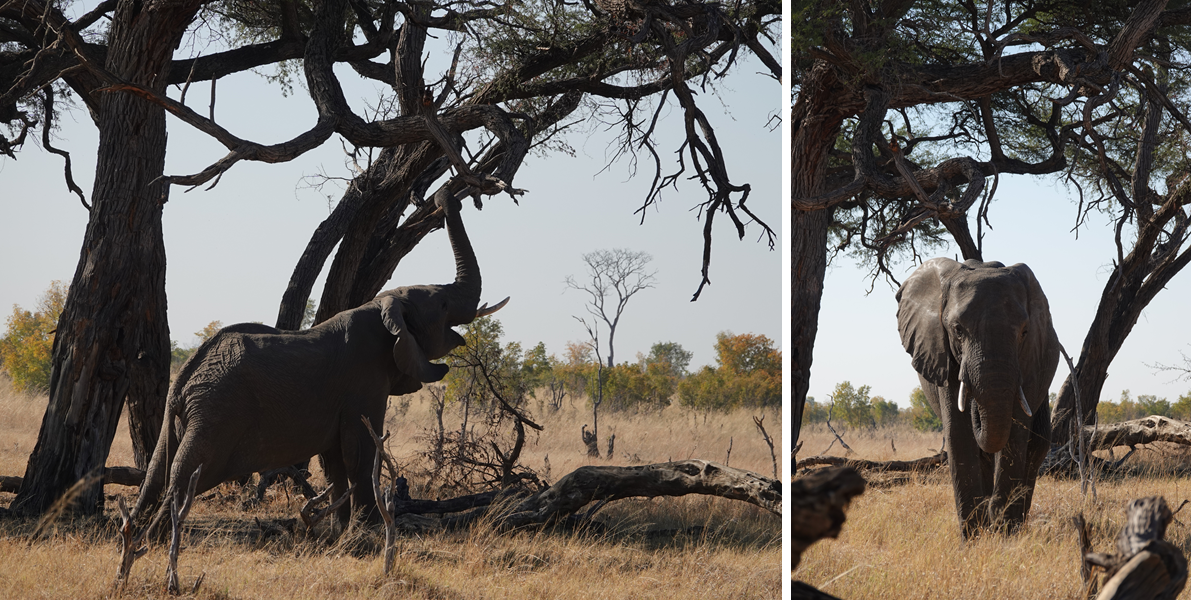
The walk itself was enthralling – Nic Polenakis deftly guided the group to approach the elephant without disturbing it. After hopping out the vehicle next to road, the group walked for about 30 minutes over flat terrain. By staying still, the group was able to watch the bull walking by – one eye ahead, the other looking at them!

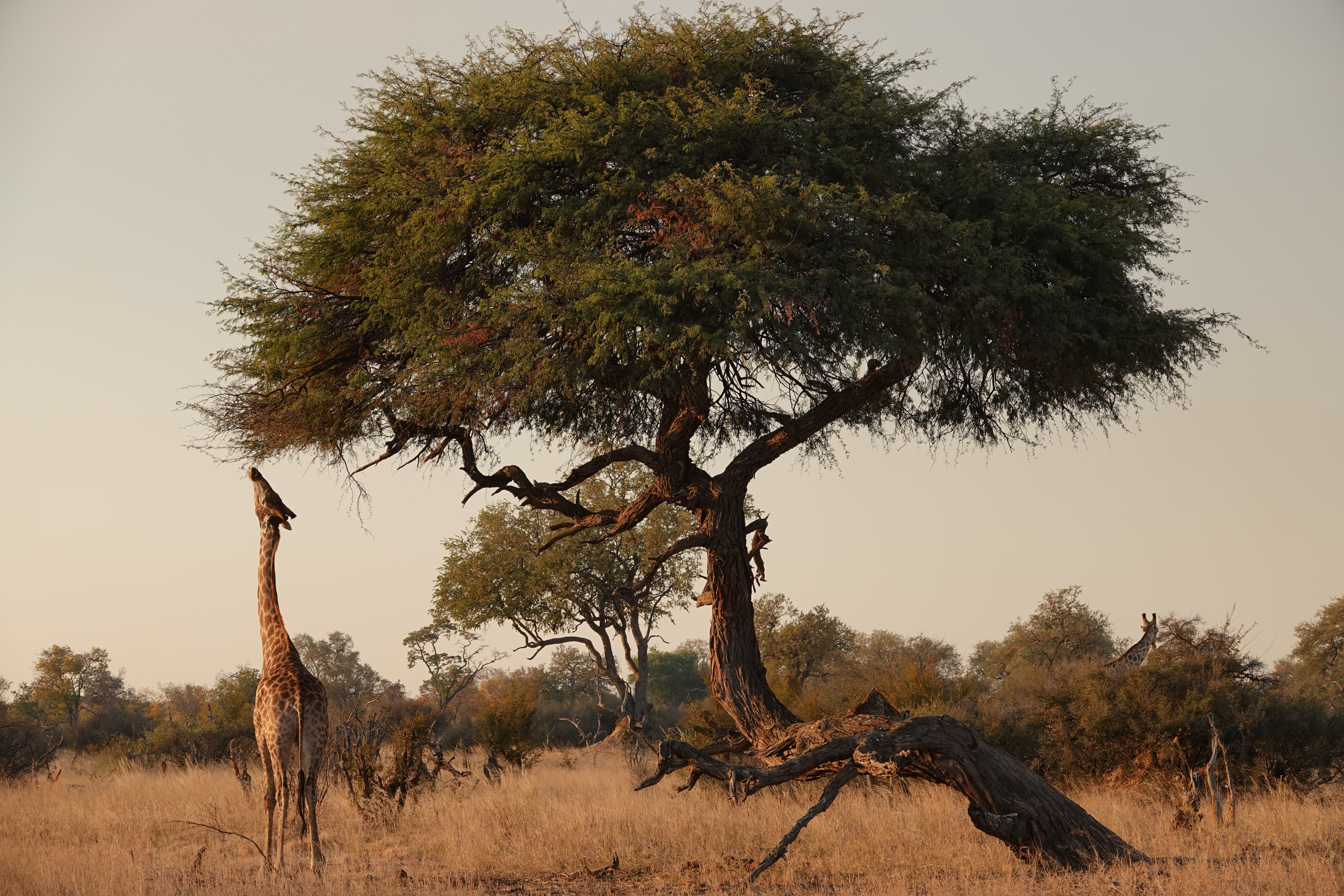

The rest of the day had several very cool sightings: more giraffe, some great birdlife, and several uncommon species of antelope, including roan. There was one lilac-breasted roller who was completely stationary, even as we crept closer and closer in the vehicle. Normally, this would be good, but the photographers were keen to get a shot of one mid-flight!
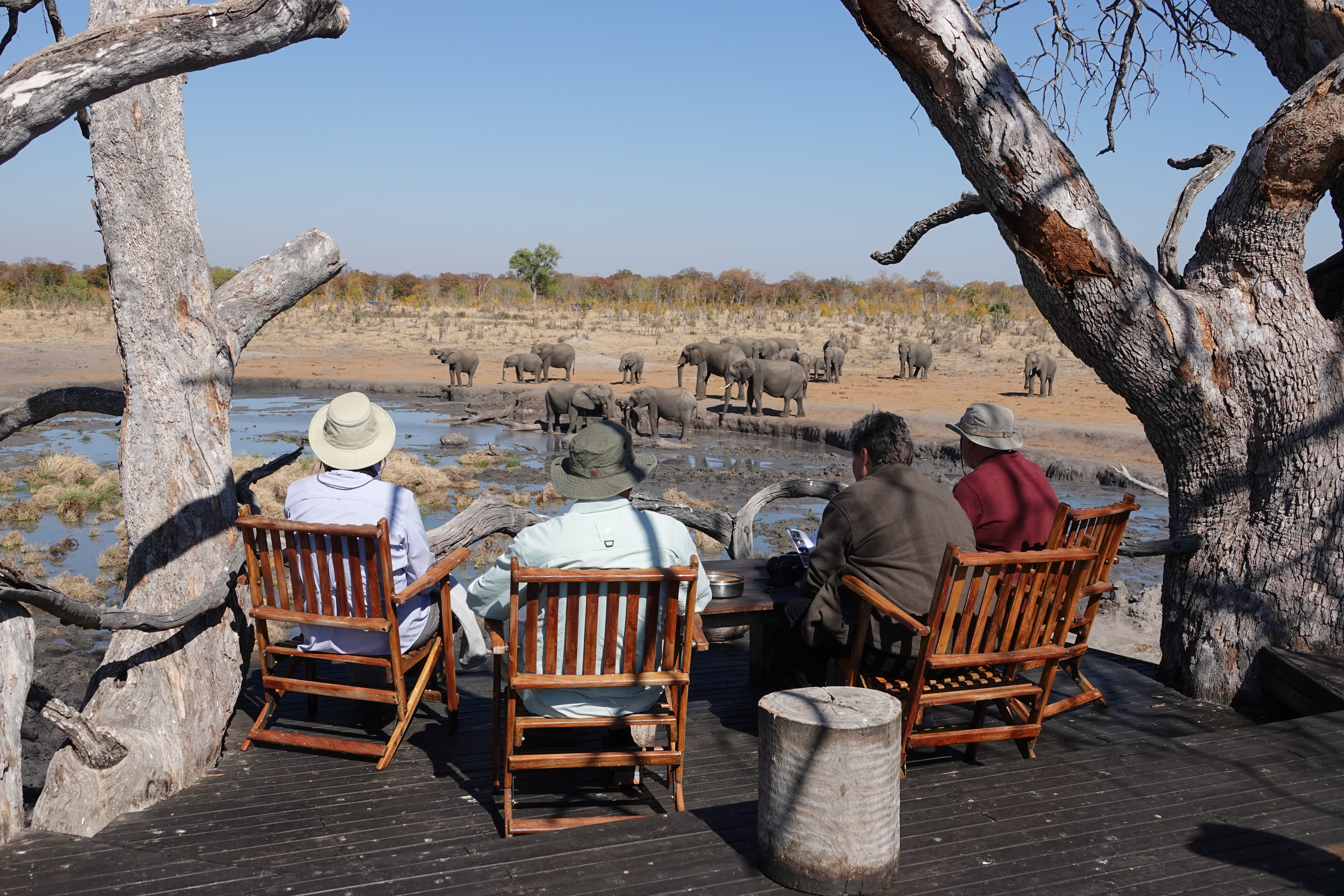
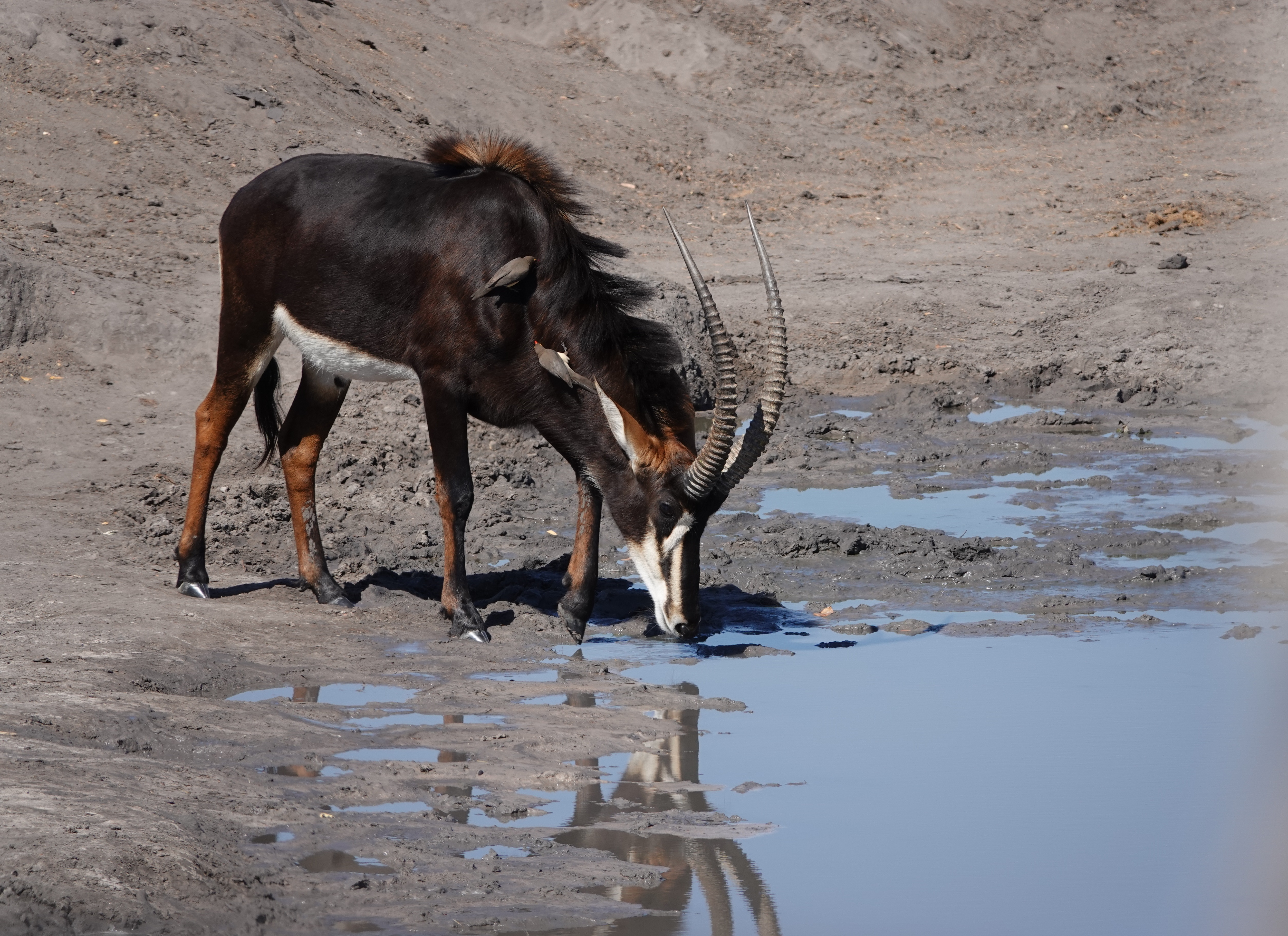
The group decided to spend part of the afternoon in Somalisa’s private hide – essentially a tree house overlooking a frequented waterhole. Funny enough the group began discussing some animal species they had yet to see, including the photogenic Sable antelope. Moments later, a lone Sable tentatively approached the waterhole. It was breathtaking, not only for the serendipity, but just observing the Sable’s elegance.
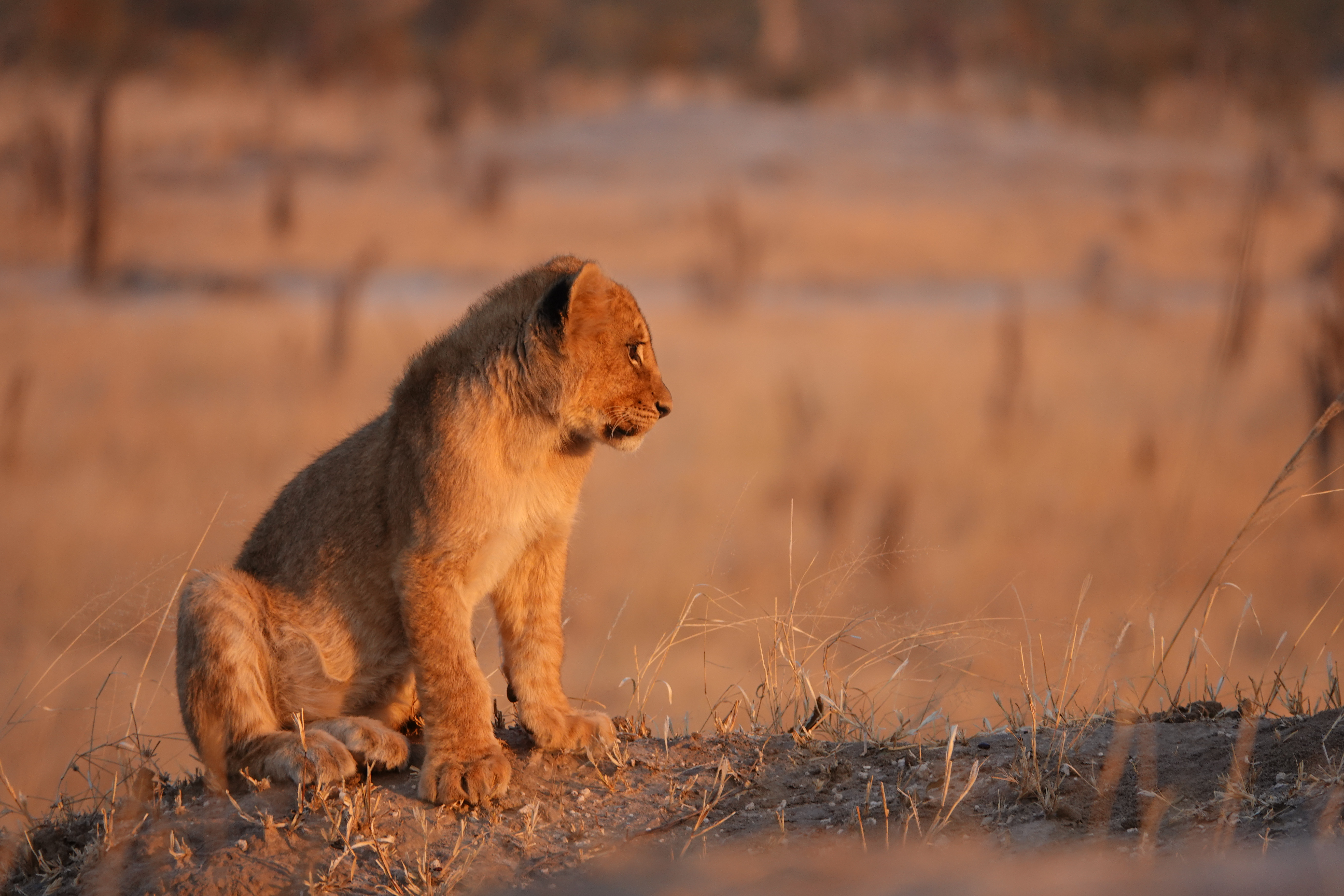
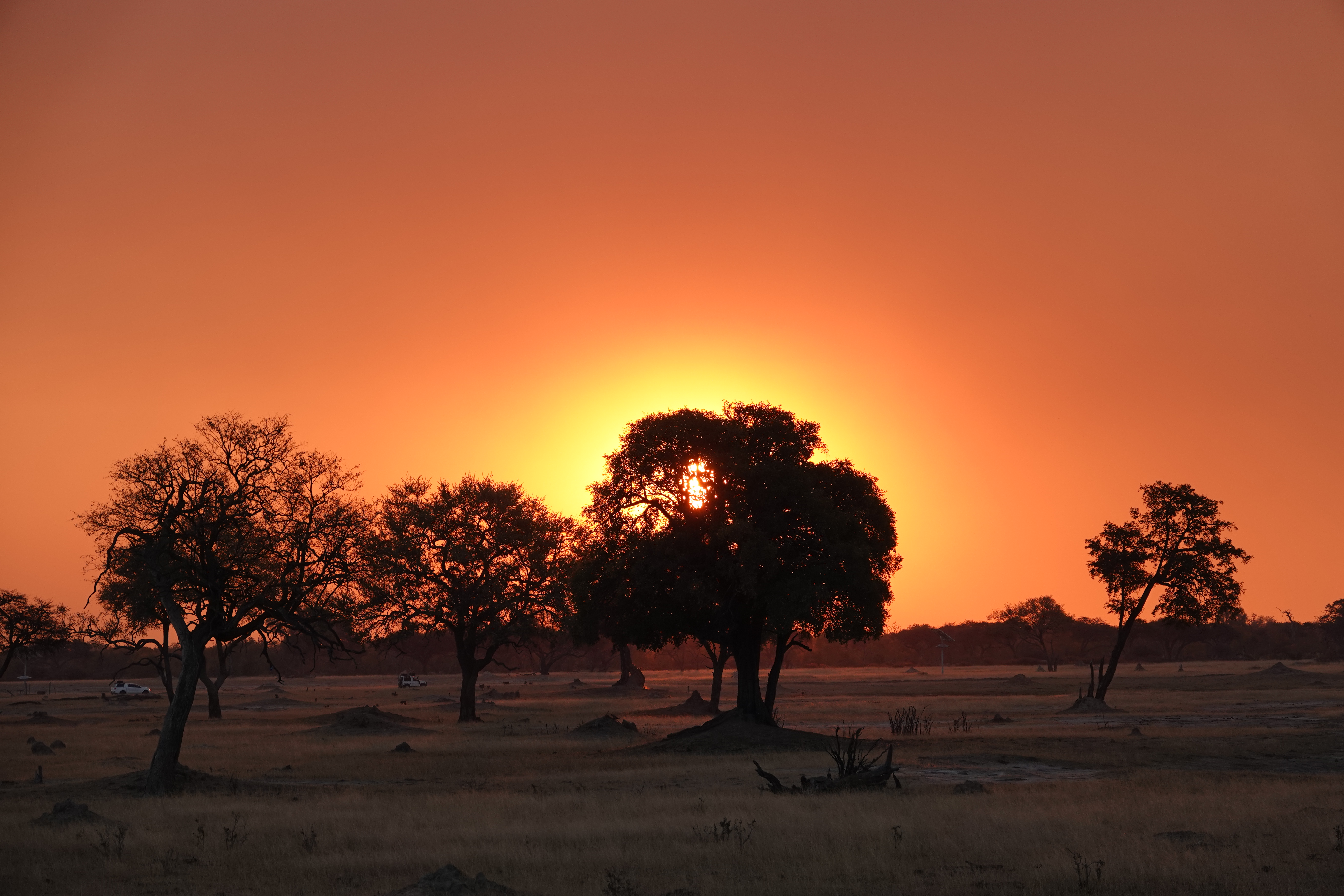
The day ended on two high notes: the group saw the lion cubs for the second time, and were left with a beautiful sunset to gaze upon.
July 16th: Somalisa Acacia – Hwange

The group’s final two days combined another guided walking safari with additional new animal sightings on a game drive.

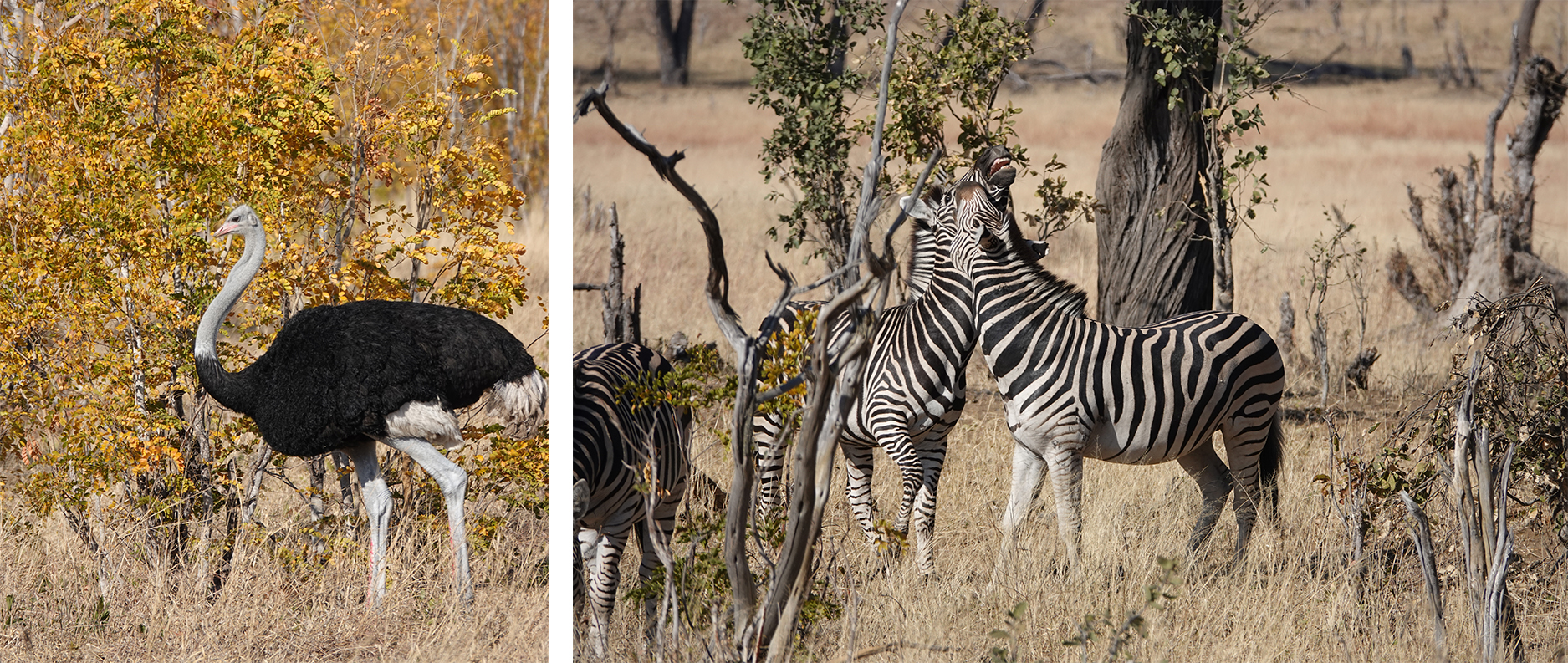
As the rest of the group enjoyed their afternoon siesta, Mark and Miles toured the other nearby Somalisa properties: Somalisa Camp and Somalisa Expeditions. The latter is an excellent property for those who prefer a more “rustic” safari experience.


July 17th-21st: Vundu Camp – Mana Pools
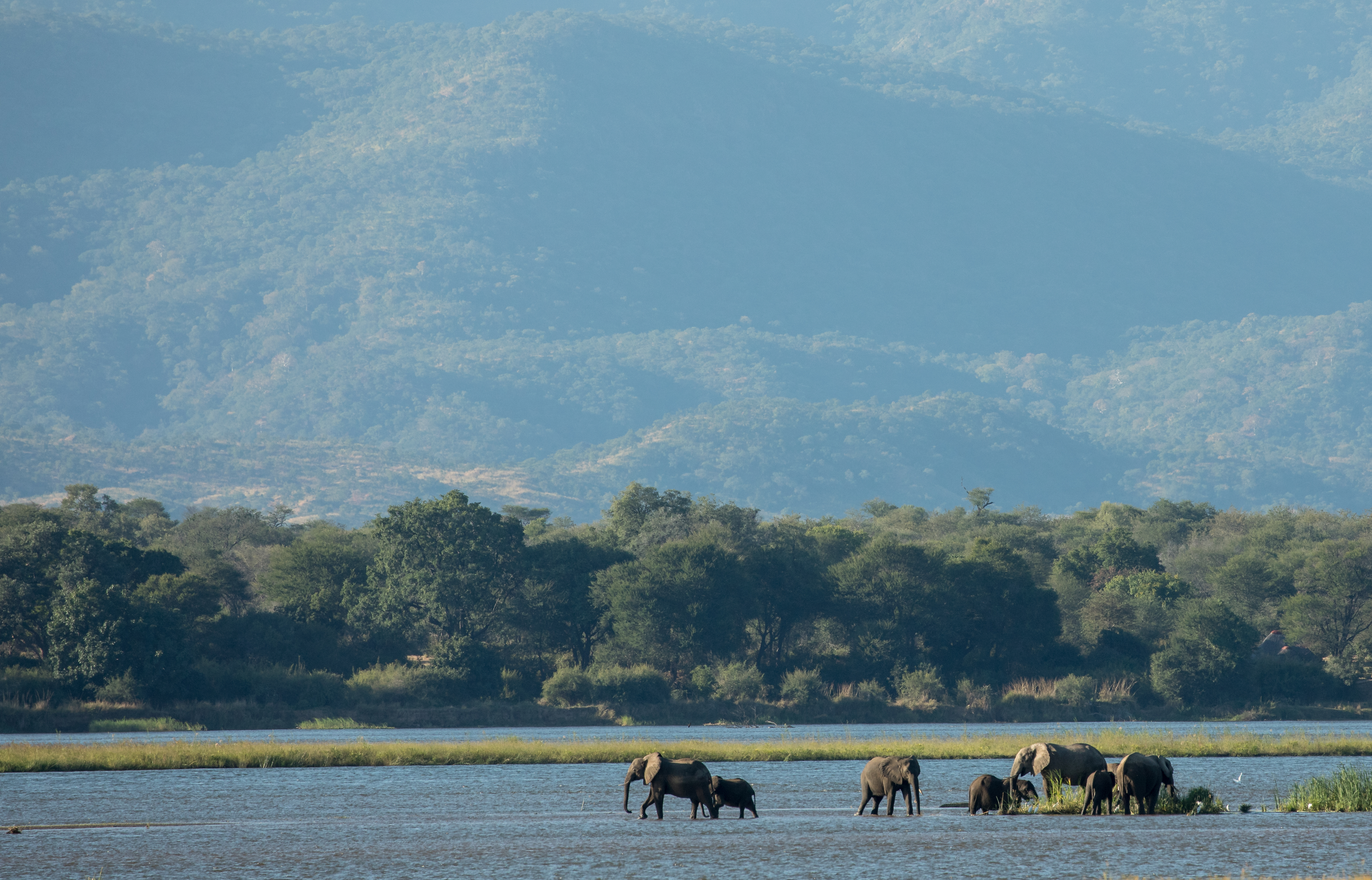
July 17th: Vundu Camp – Mana Pools

Following a mid-day scheduled charter flight to the Mana West Airstrip, the group arrived at their next camp: Vundu Camp. You can learn more about it, and why AAC likes it so much, by clicking on the link below:
Our Pick of 20 Intriguing Lodges & Camps for 2020
Mark and Miles had a great opportunity to catch up with Nick Murray, a longtime partner and friend of the Africa Adventure Company. In fact, Miles hadn’t seen him since the last time he was at Vundu Camp in 2011 – the picture above on the left is of him canoeing there in 2011!
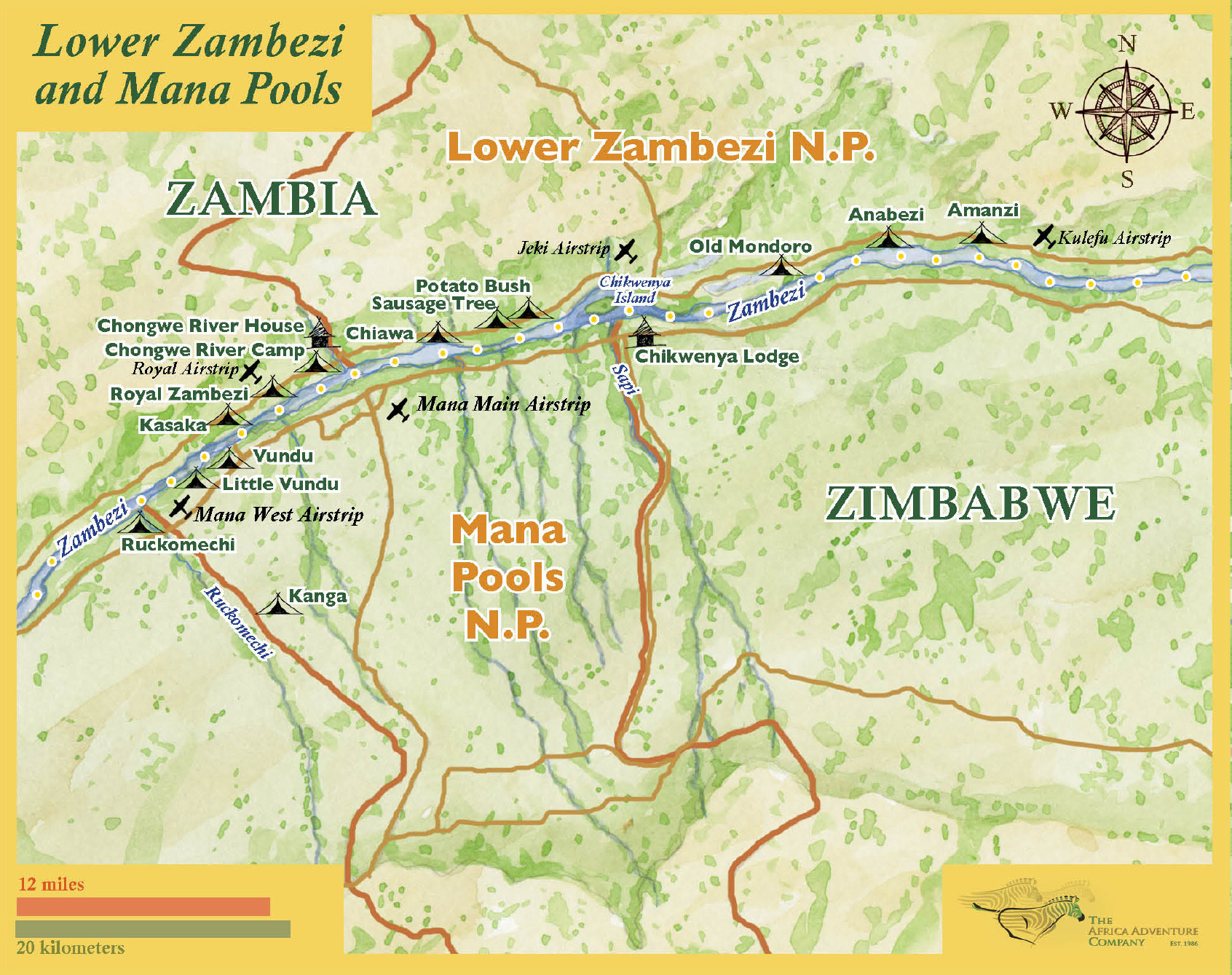
July 18th: Vundu Camp – Mana Pools
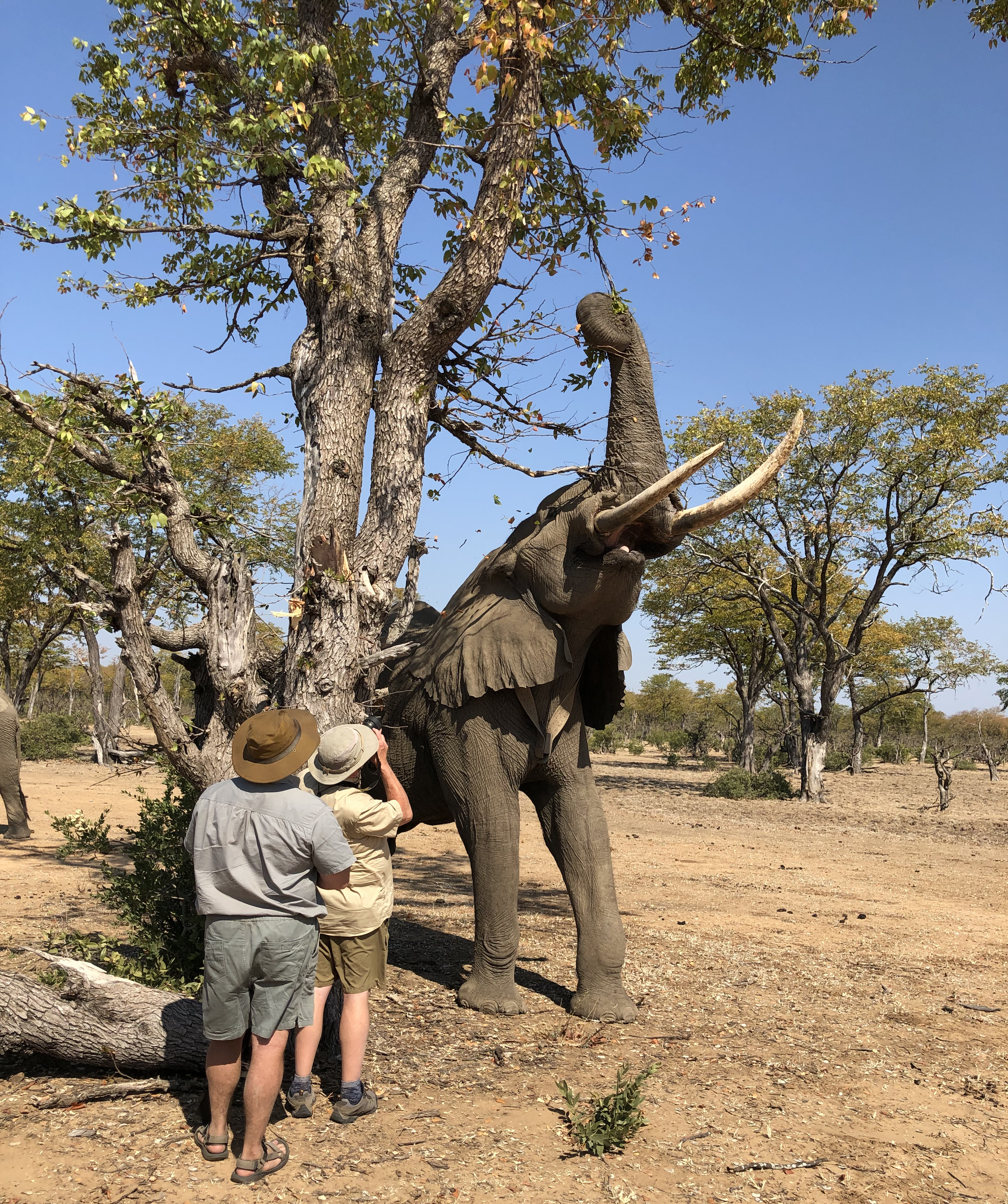
The group had discussed their plan of action for the night before. The plan was threefold: walk to a wild dog pack’s den, go see the bull elephant named Tusker, and go canoeing down the Zambezi.
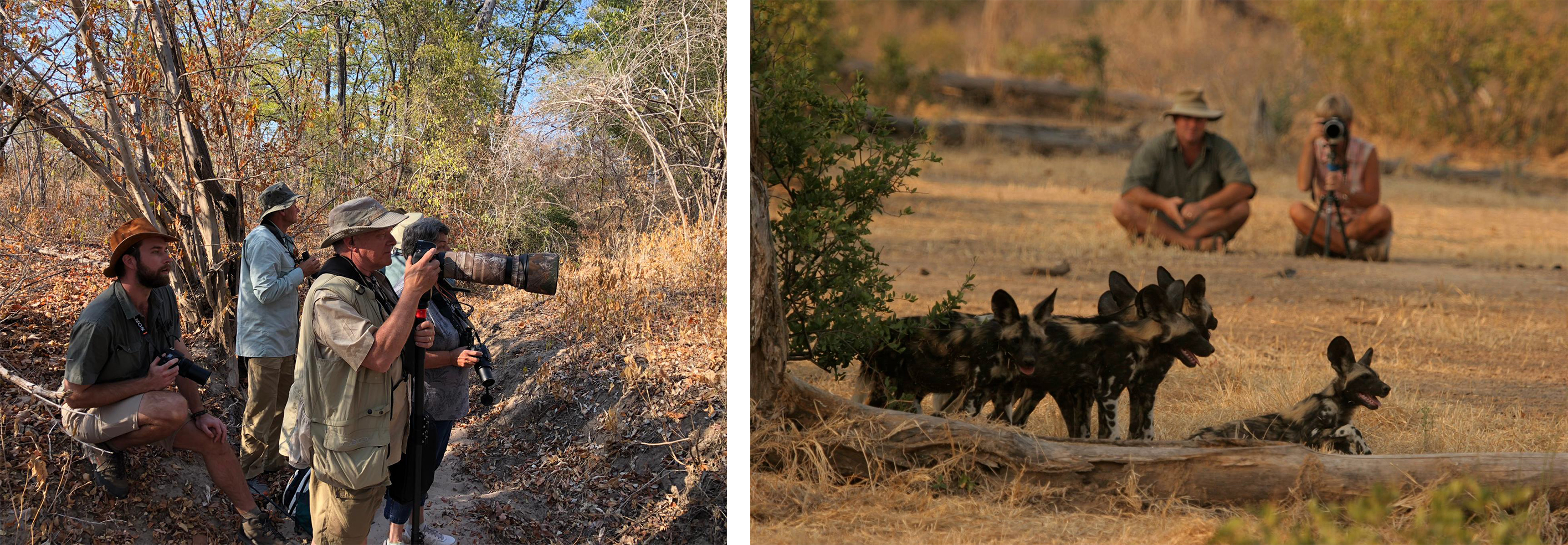
A couple of days before the group had arrived, Nick and the guides at Vundu Camp successfully tracked down a small pack of wild dogs. Nick suspected that the alpha female had just given birth no more than a few days ago! To learn more about Vundu Camp’s wild dogs, click here:
Surprisingly, the hunting pack of 3 was unsuccessful – wild dogs are known as one of Africa’s most proficient hunters, for around 75% of their hunts end with a kill. Nevertheless, they did return – Miles jumped up from surprise when one barked behind the group!
After the group returned to the vehicle, Tusker decided to pay us a visit. Though intrigued by us, it seemed he had no desire to see what we felt like – as evidenced by the video above.

After lunch at Vundu Camp, the ‘Eyes on Elephant’ Group decided to be adventurous: they were off to canoe down the Zambezi! For some, the prospect of canoeing down a river in Africa might be unnerving. And that’s entirely ok; you are under no obligation to do so, even if you planned on it – you can easily change your mind.
But what makes Vundu Camp great is for people who do want an authentic canoeing experience in Africa. Mark and Miles agreed – of the three camps they visited in Mana Pools, Vundu offered the best canoeing experience.
Additionally, there are camp staff members that can canoe for you – all you have to do is enjoy the sights and sounds of the river – like the elephant breeding herd the group spotted! Once the herd approached, the canoers interlocked with their legs and arms to keep the canoes stationary. Additionally, they also spotted lots of waterbuck, hippo, birds, including a small flock of African Skimmers – a rare find!
July 19th: Vundu Camp – Mana Pools
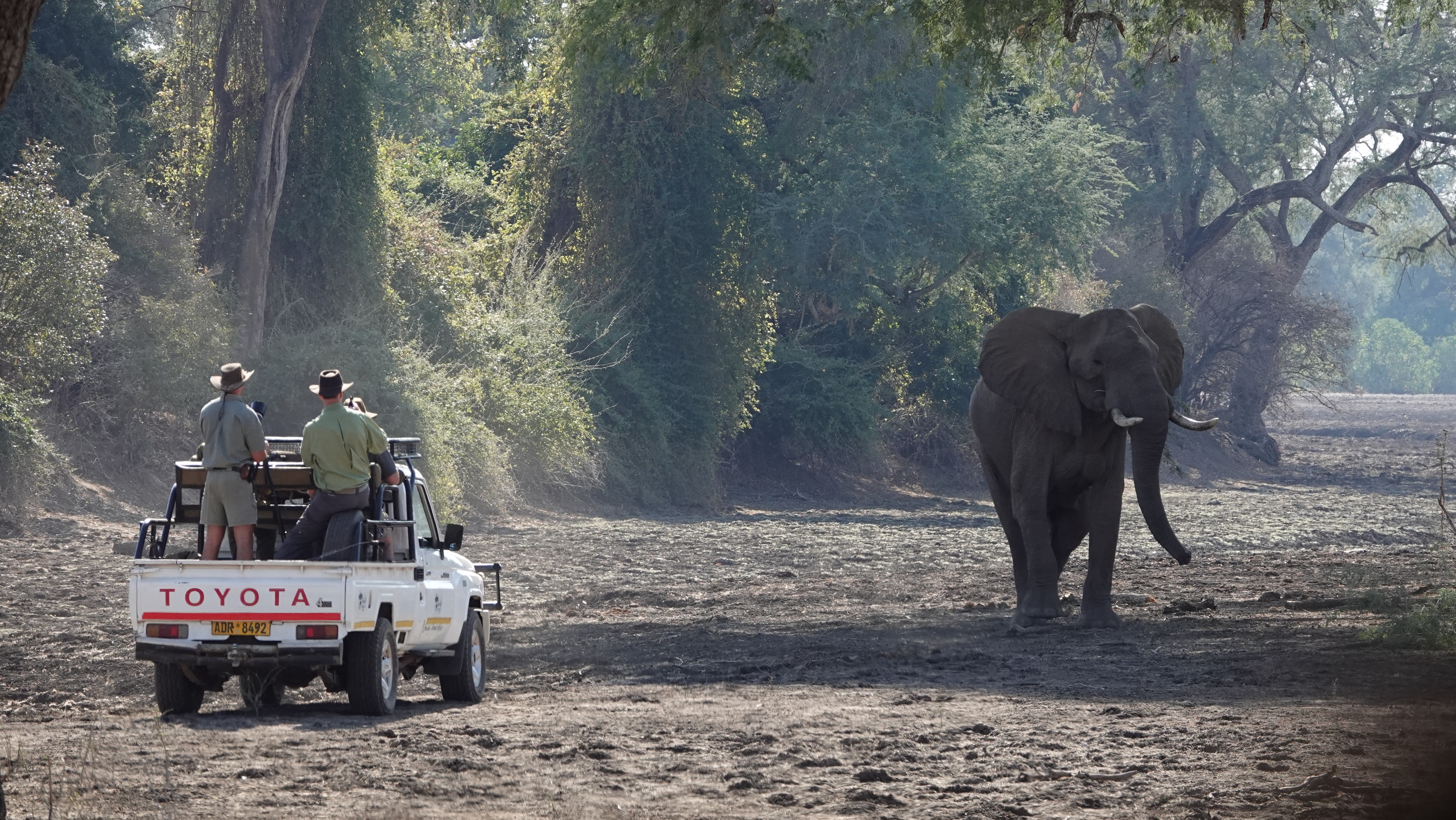
Today was the big day. During breakfast, everyone was murmuring about the news: the night before, the national parks veterinarian arrived. This meant the group, and several other AAC clients at Vundu, was about to collar its first elephant!
You may have noticed that Tusker, and elephant shown earlier, had a collar on. This helps Bushlife Conservancy, operated by Nick Murray nearly entirely from what clients pay to stay at Vundu Camp and their donations, track, and therefore better protect elephants prized by hunters in nearby concessions.
National Parks only allocated 5 elephant collarings. So the goal for the next two days was to identify 3 bull elephants with similarly-sized tusks as Tusker, and two matriarchs. Thus, this meant Nick and Bushlife needed to be choosy. The ‘Eyes on Elephant’ Group passed on several candidates until settling on Westpoint, a 35 year old male.
1st Elephant Collaring – Westpoint

The process of collaring begins with approaching the target elephant close enough to ensure the vet can put the elephant to sleep with a dart. The bigger the elephant, the bigger the dosage required for the elephant to remain unconscious without any health complications. Some elephants will “go to sleep” quicker than others, but after a few minutes, every elephant will fall down.
Depending on how the elephant falls down dramatically affects how easy the collaring will be. Unfortunately, Westpoint decided to fall down on his side. This meant the group had to dig, yes dig, underneath its neck in order to put the collar fully around its neck.
While this is occurring, there are numerous people keeping track of the elephant’s vitals: breaths per minutes, body heat, etc. Since Westpoint, landed in the shade, there was no need to poor water over him to stabilize his body temperature. Mark had the important job of keeping track of Westpoint’s breath per minutes and to ensure that his trunk was open throughout the collaring process. If the elephant’s breathing rate dropped too low, the vet would have to intervene in order to avoid health complications for the elephant – whether or not the collar was placed on or not.
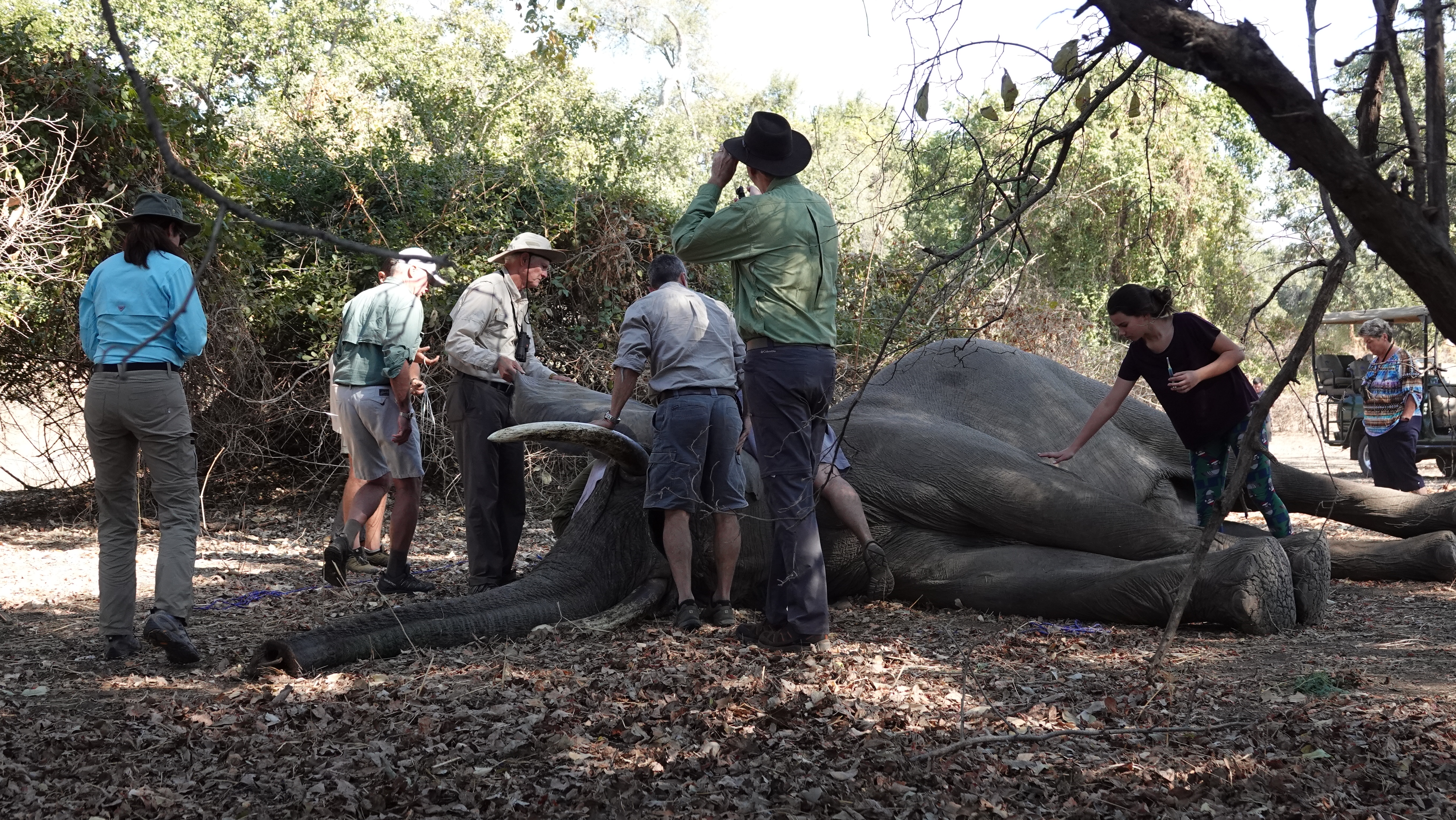
But the collaring was a success – the vet injected a “revival serum” into the elephant. This gave the Bushlife staff, and the group of guests watching, time to disperse before Westpoint woke up again.
2nd Elephant Collaring – Impi

If everyone though the day’s first collaring was difficult, were they in for a surprise for the second one!
Like Westpoint, Impi fell on his side after the darting. But unlike Impi, the Bushlife Staff were unable to get the collar fully around Impi’s neck. This was even after Miles, Mark and a rope attached to a reversing Land Cruiser were used. Furthermore, since Impi was in the sun for part of the collaring, he also needed to be drenched in water to ensure his body temperature did not rise too rapidly. The Bushlife staff came to the conclusion that they would have to slip the collar around Impi’s ear – as he stood up.
As the dramatic video above shows, it worked! This was definitely the most challenging, but consequentially, the most rewarding, of all 5 collarings. There wasn’t a frown among the entire group during the sundowners immediately afterwards!
July 20th: Vundu Camp – Mana Pools
3rd Collaring – Bruce
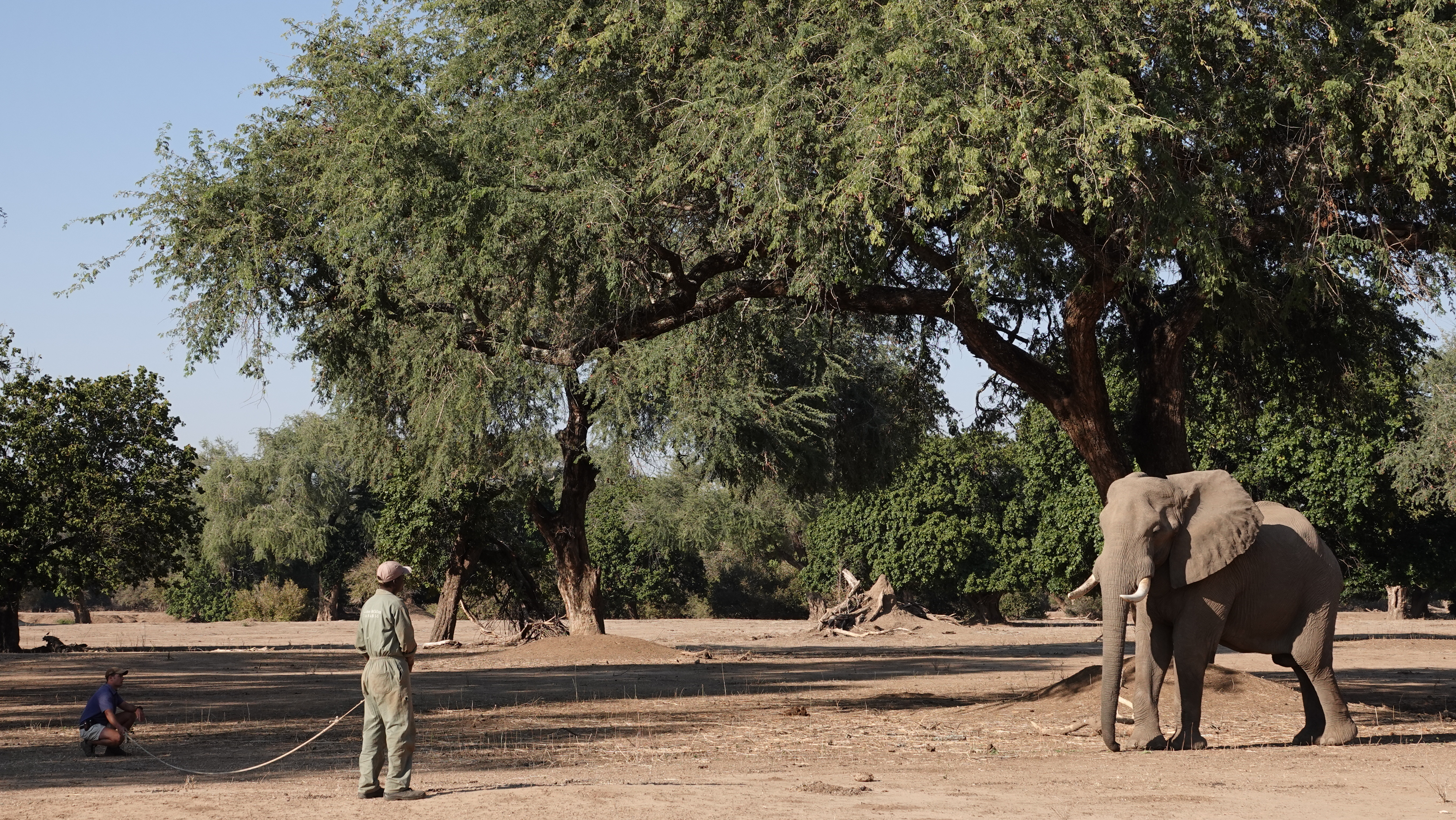
The following morning, the Eyes on Elephant Group went to search for its last bull elephant to be collared. Unlike yesterday, the group found their target quickly. And also unlike the others, this one had yet to be named.
Bushlife decided to try a new approach. They decided to have the collar ready to put around the bull’s neck right as he collapsed. This could be possible, for the tranquilizing dart disorients the elephant enough to allow them to approach. As it so happens, it worked out perfectly – the bull landed on its front knees, neck perfectly accessible.
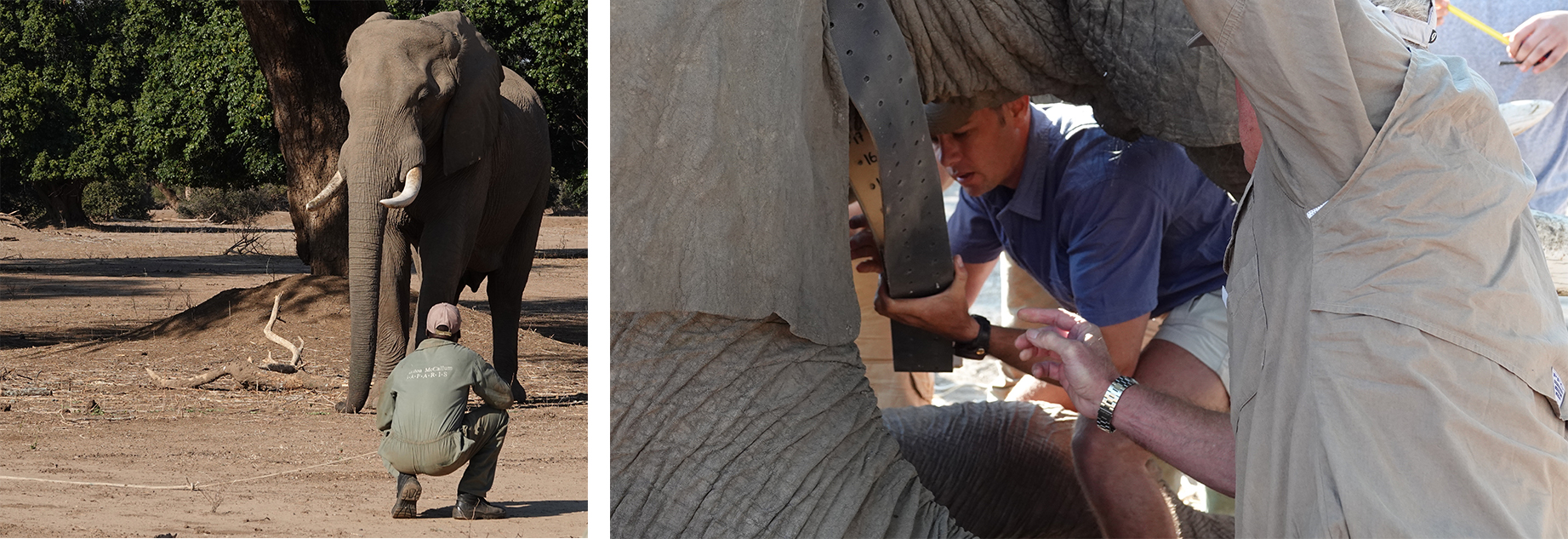
This was the quickest collaring, and because of that, the least stressful for all those involved.
Because this bull was unnamed, it was decided that he would be named “Bruce,” after Bruce Lawler. He and his wife Lisa were instrumental in providing the funds needed to make the 5 elephant collarings. Therefore, it was only fitting that this elephant was to be named Bruce!
Walking with Boswell
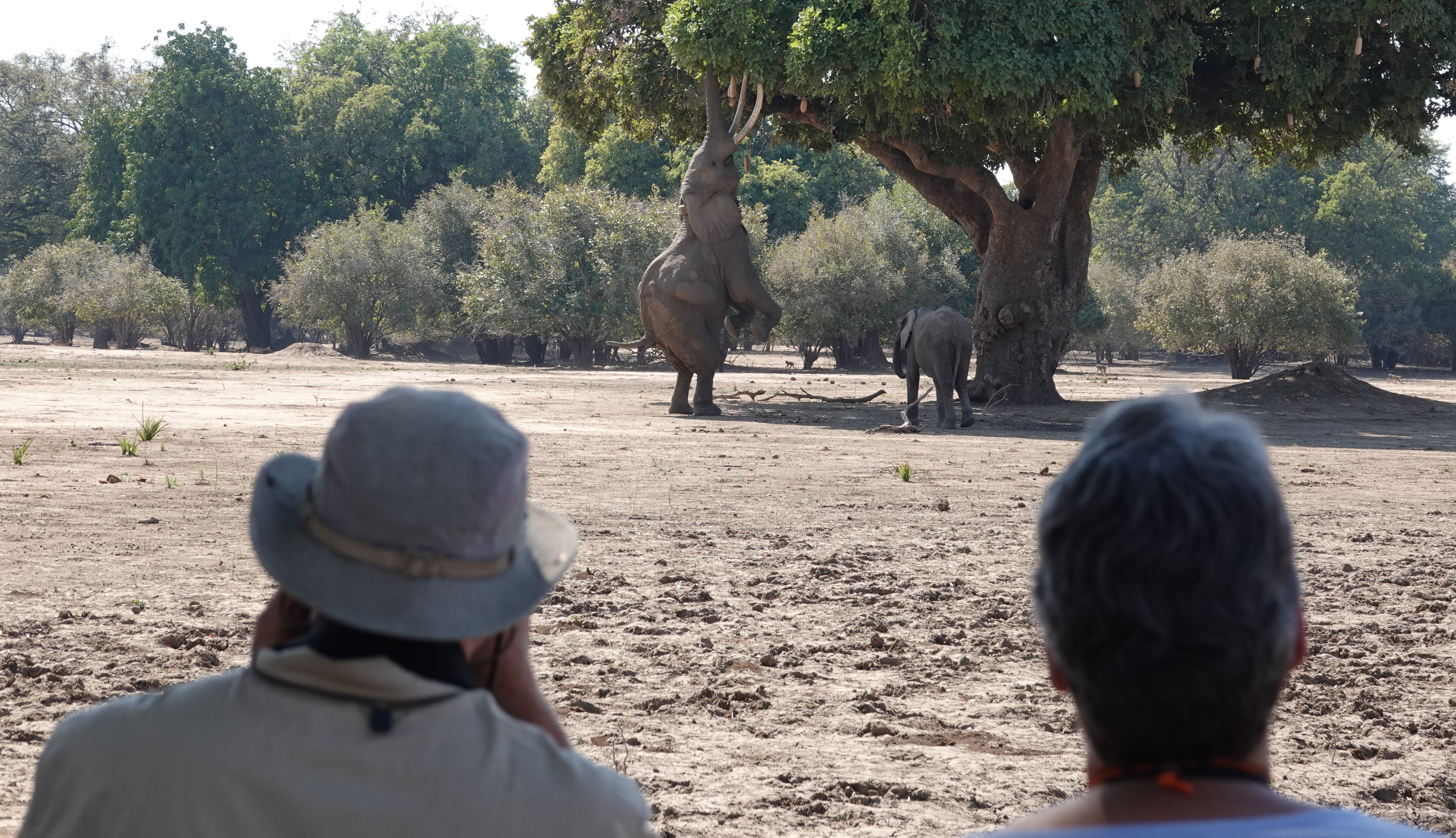
A big highlight of Mana Pools is to approach elephants by foot – and if you’re lucky, see them reach for branches on their hind legs!
Since the day’s first collaring went so quickly, the ‘Eyes on Elephant’ Group had time to spare. When they heard Boswell, both the biggest elephant by body and tusk size in the area, was around, they unanimously decided to go find him!
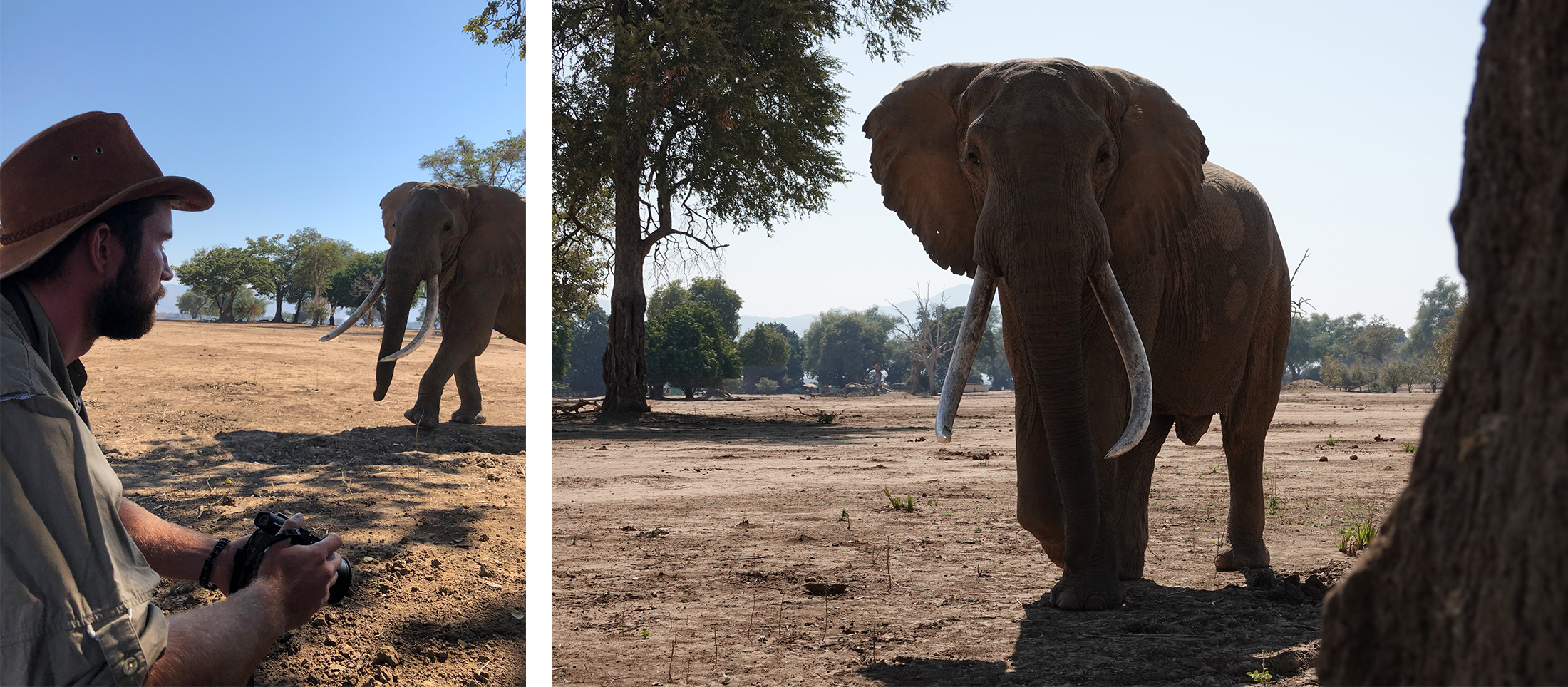
Boswell was one of the first elephants Bushlife targeted. This was not only because of the size of his tusks, but also his unique ability to reach for branches by balancing on his hind legs.
The group found a nice tree to sit underneath and watch, with awe, as Boswell went up on his hind legs. Later on, Boswell came walking on by. Curious about us, he approached closer. But before he got too close, Nick Murray blurted out a stern “Bossie!” He hesitated, then almost scoffed before continuing to walk on. He also got some snot on Miles in the process!
4th Collaring – Lisa

Collaring a bull elephant is one thing, but collaring a cow is another thing completely. The Bushlife staff and the vet have to take into consideration not only the matriarch’s protectiveness, but the other cows’ protectiveness, too. This meant that the guests stayed way clear of this collaring – essential personnel only.
The plan to collar this cow was to separate her from the rest of the herd after darting her. This required a handful of vehicles – fortunately for all, it worked, and even better, the rest of the breeding herd remained quite calm.
From there, the collaring was seemeless: unlike the bulls, cows’ necks are much smaller. Therefore, no digging is required if she falls down on her side after the darting. Thus, it was a quick in-and-out for the now well-experienced crew. After she revived, the rest of the herd approached her, curious about what she now had on her neck!
In thanks for Bruce and Lisa Lawler’s contributions to the collarings, this previously unnamed matriarch was named Lisa.
July 21st: Vundu Camp – Mana Pools
This was the last day that Mark, Miles and the ‘Eyes on Elephant’ Group were to spend with each other. They were treated to not only the 5th (and final) elephant collaring, but an additional darting – details later.
5th Elephant Collaring – Mrs. Tusker
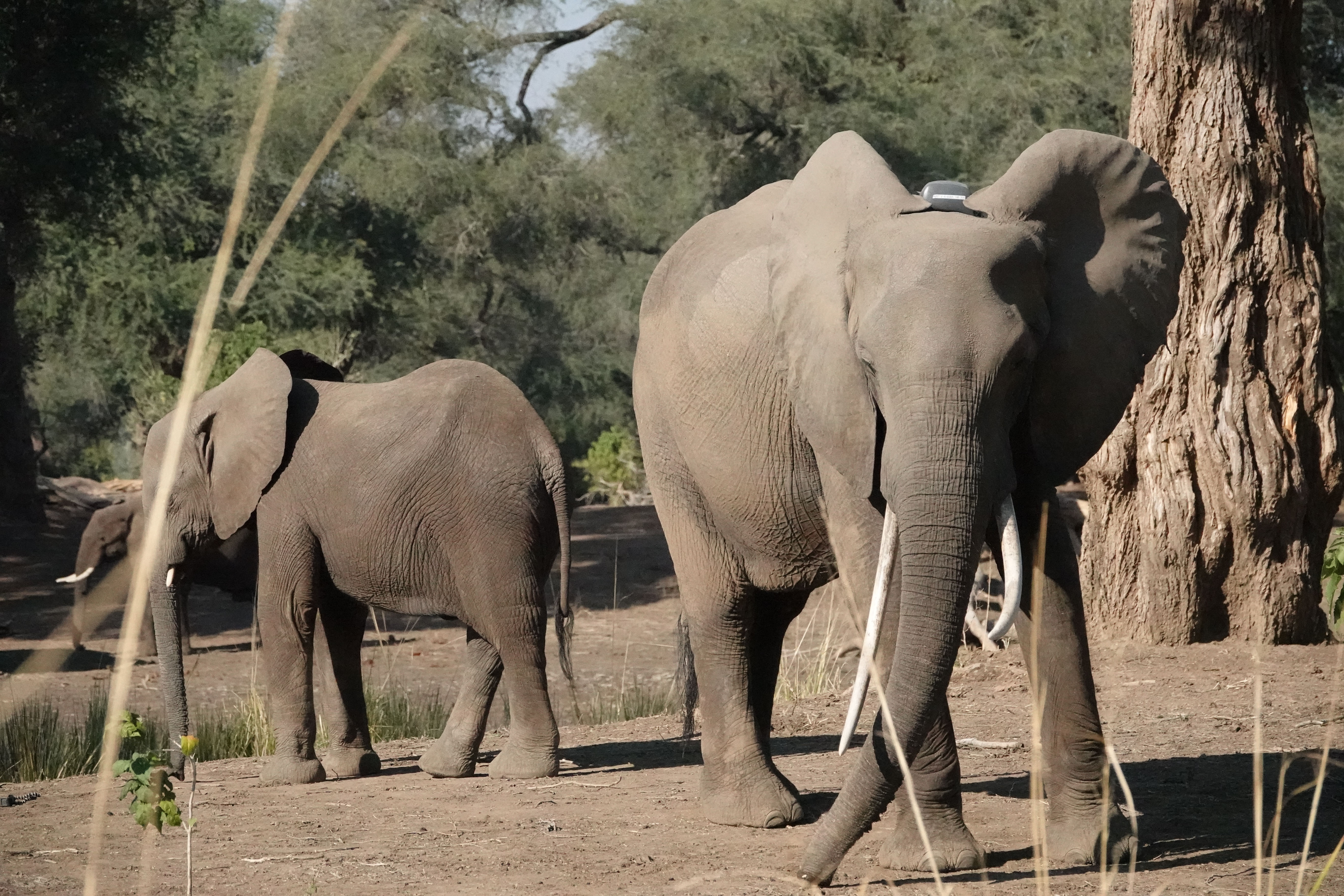
The final cow to be targeted was “Mrs. Tusker,” named that because of her unusually large tusks for an elephant cow. Unlike Lisa, she only had her one calf with her at the time. Though he was a little bit agitated, the Bushlife crew worked quickly and efficiently so that he was shortly reunited with his mom.

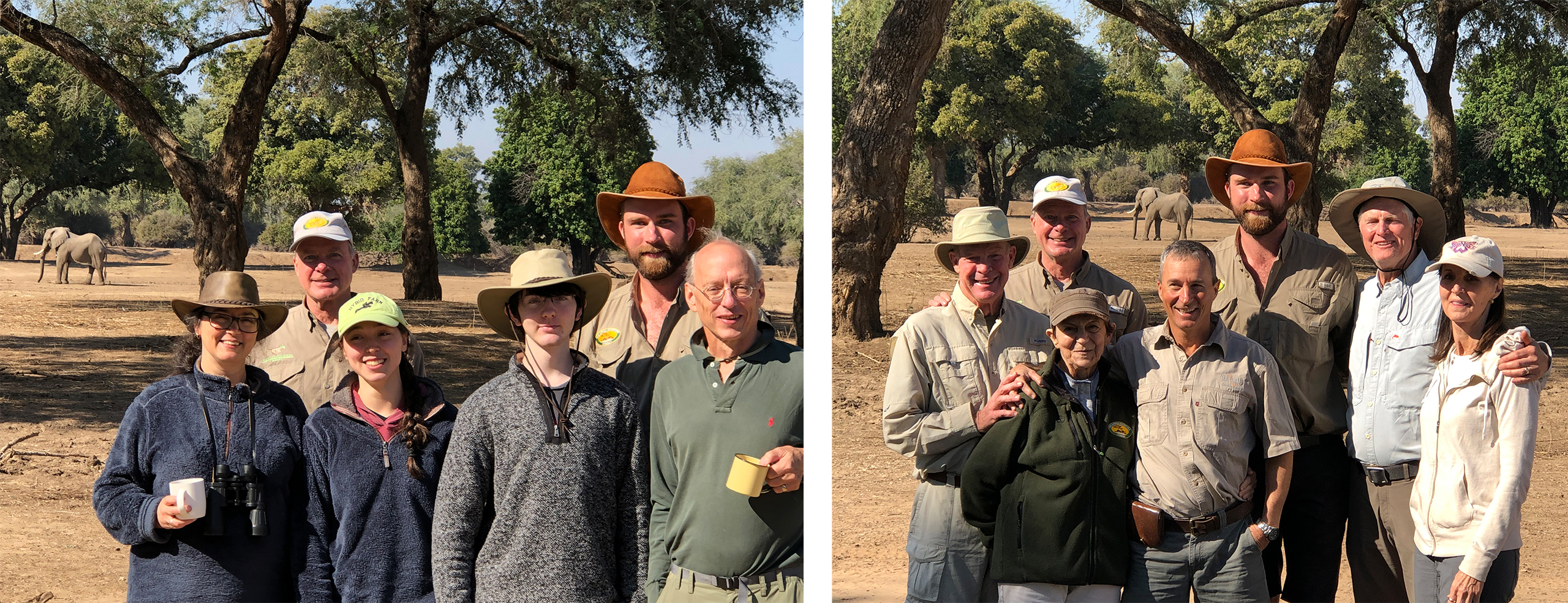
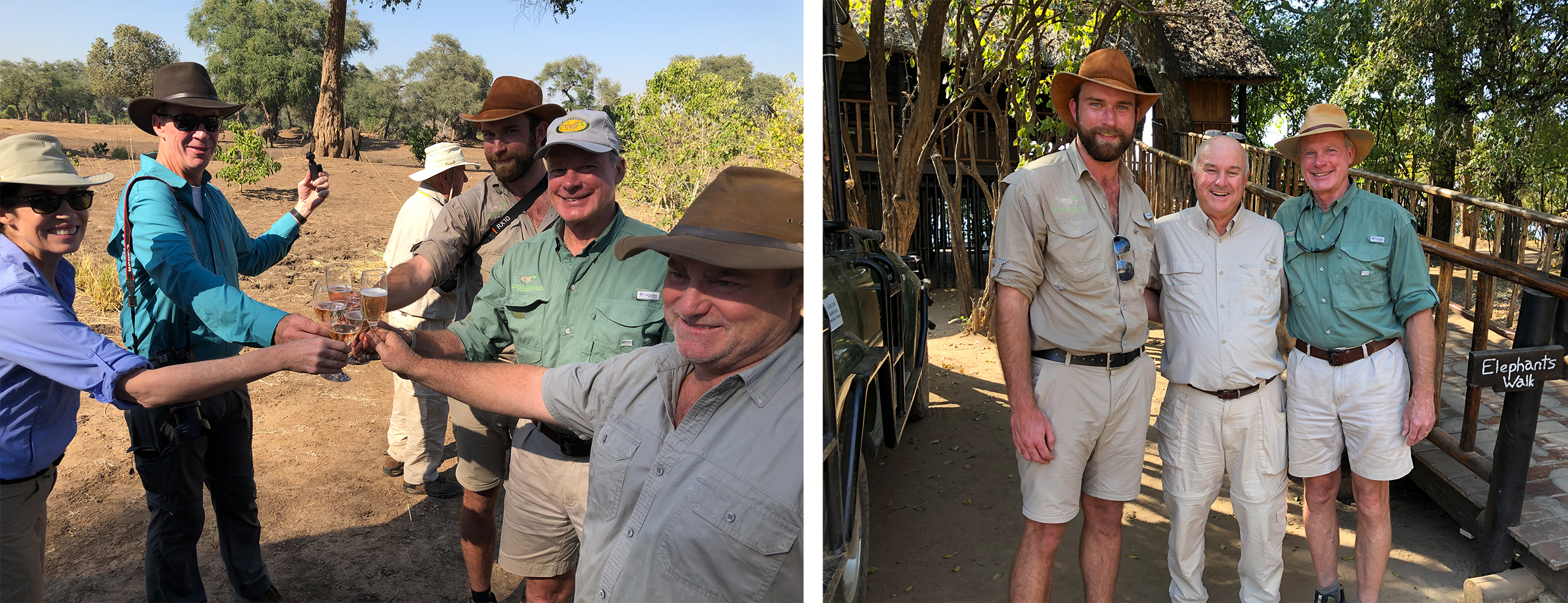

Elephant Darting
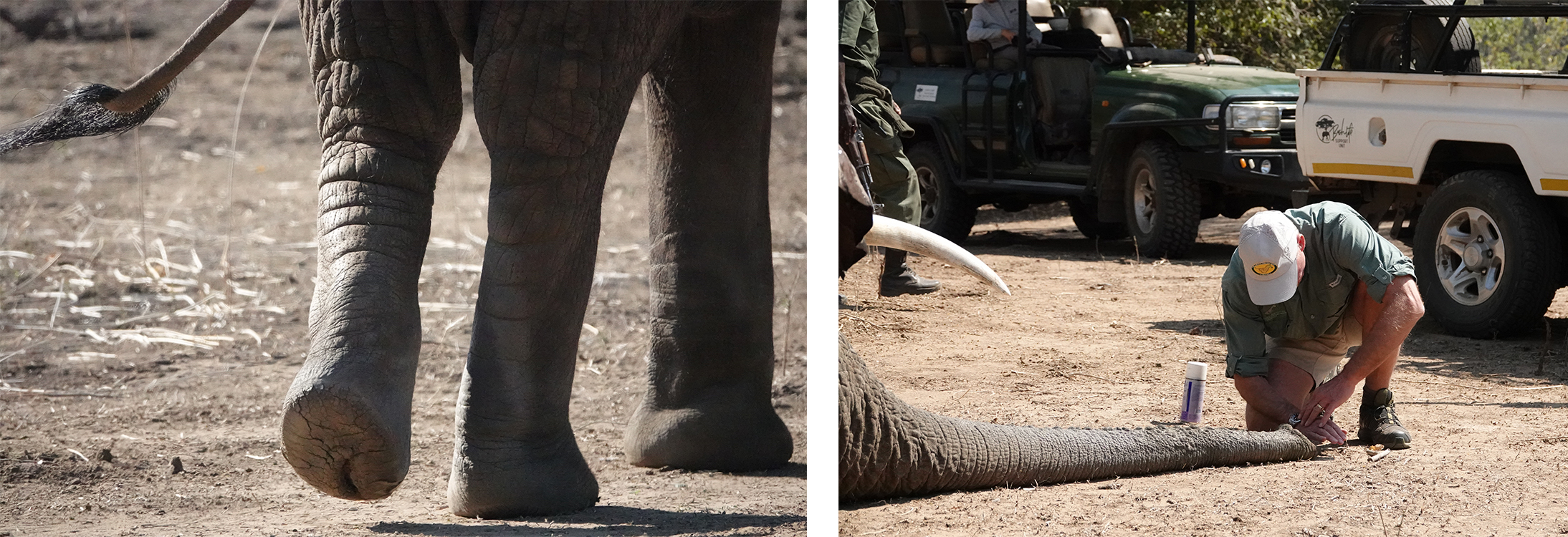
While the group was in the process of collaring Mrs. Tusker, Nick Murray and the vet noticed a nearby bull elephant was hobbling awkwardly. Upon closer inspection, it was determined that it had a deep puncture wound in its hind left foot. As a result, the elephant was in risk of starvation: since they have to eat so much on a daily basis, a slower pace means less eating. Therefore, the group decided to intervene once Mrs. Tusker was collared.
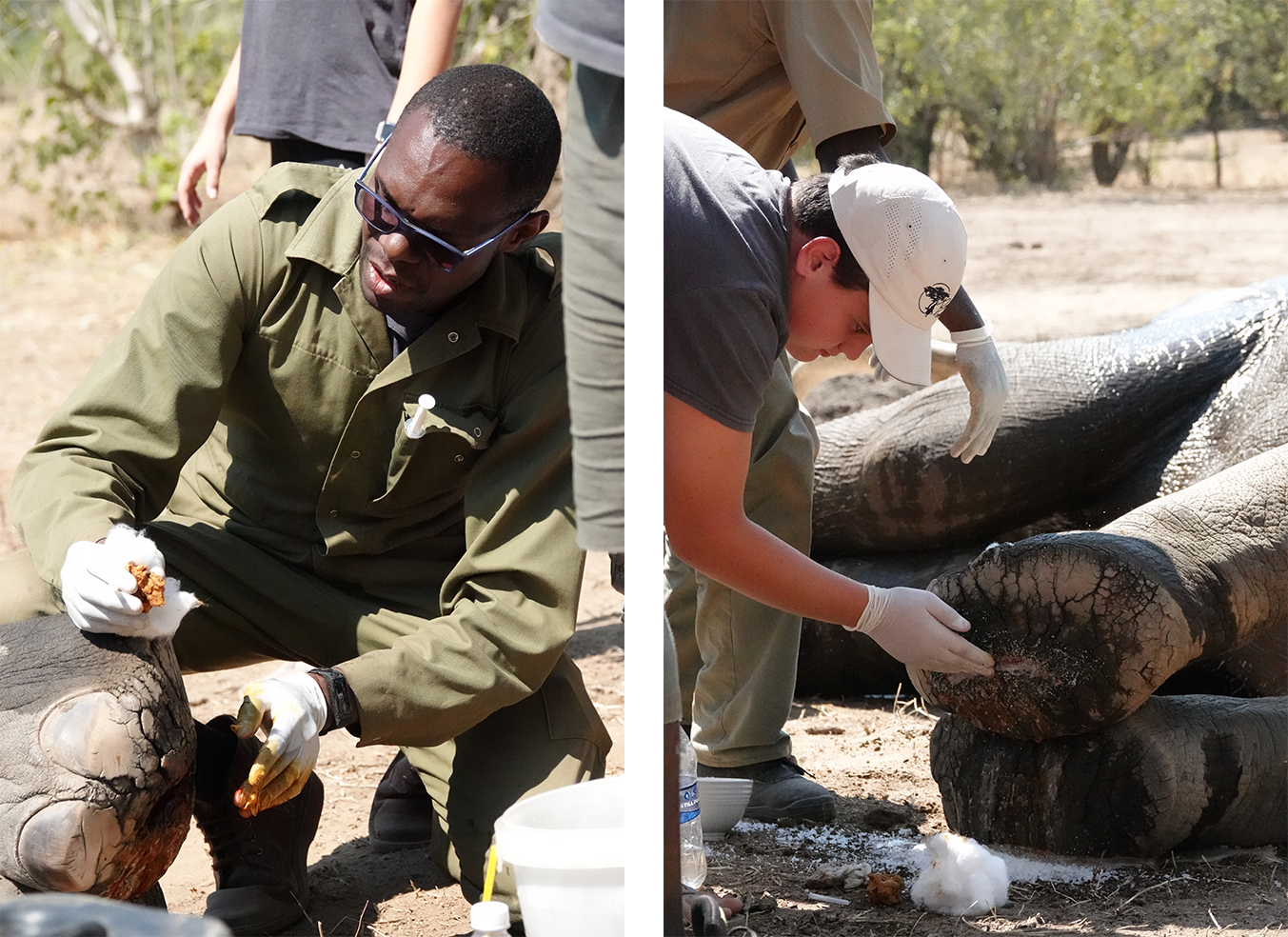
The process was similar to the collarings: approach the elephant close enough to ensure it could be darted properly. Then wait until it “fell asleep” before administering medical treatment. In the process, vitals would be tracked and body temperature would be maintained by pouring water over the elephant.
Mark was tasked with keeping track of breaths per minute while Jed, Nick and Dez Murray’s son, helped with filling the wound – the hope was that the medication would help seal the wound and the filling would help the elephant walk more normally.
Saying Goodbye & Onward to Chikwenya

Now, it was finally time to say goodbye after 4 nights at Vundu Camp. On the second night of the trip, Nick Murray’s family came up for the weekend: his wife Dez, son Jed and daughter Tait. Normally, they live in Harare, Zimbabwe’s capital. Dez handles the financials, marketing and bookings ends of the business while also being a mom to her school-age children.
Despite living the city life she hadn’t lost a step – as a former safari guide herself, she was driving clients around during the exciting elephant collarings. From AAC, we wish them all the best, and hope the next time we can visit is sooner rather than later.
To learn more about Mana Pools or AAC’s “Eyes on Elephant” itinerary, fill out the Safari Questionnaire on the bottom of the page!
July 21st-23rd: Chikwenya Camp – Mana Pools
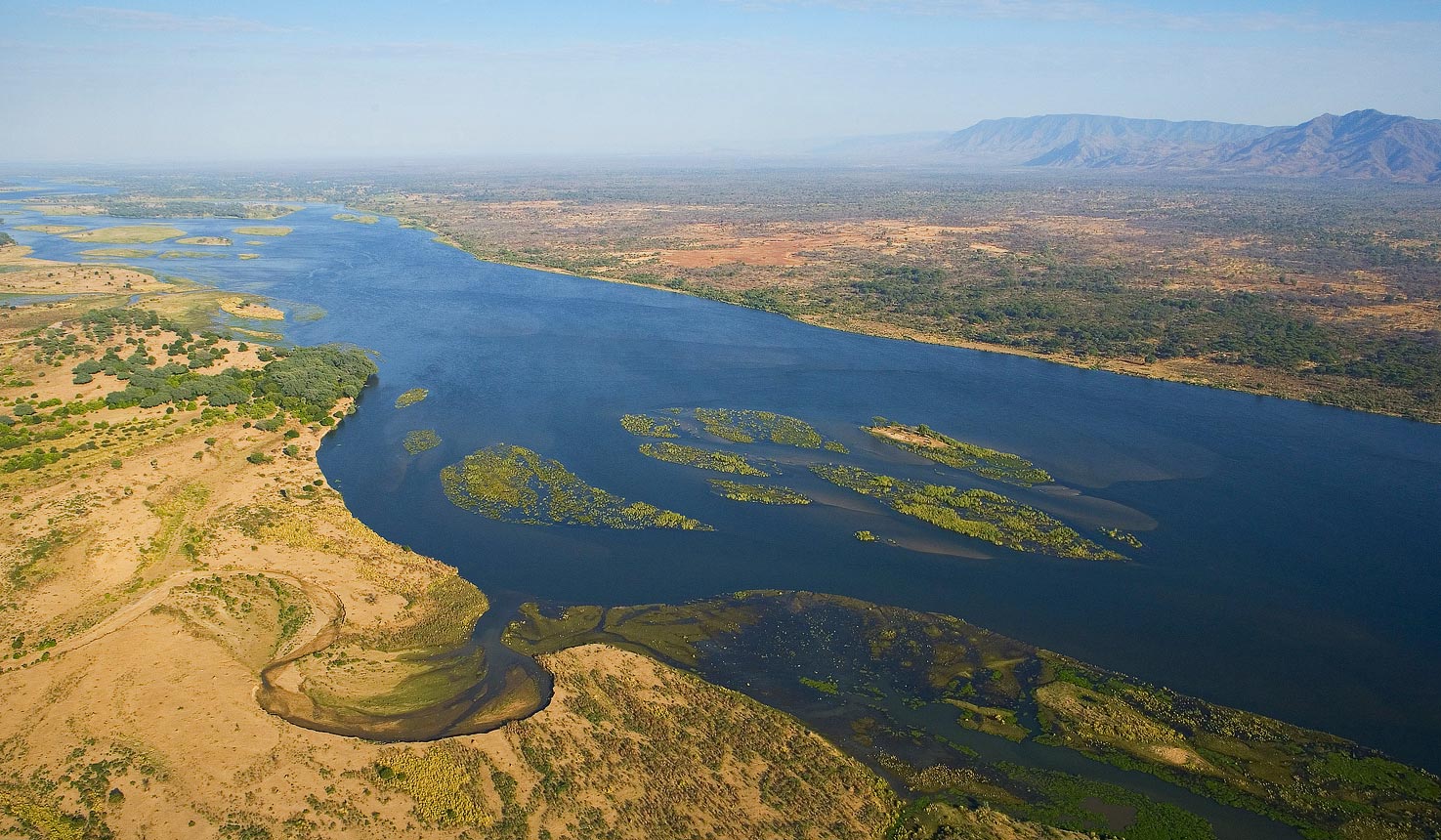
July 21st: Chikwenya Camp – Mana Pools

Mark and Miles then departed to Mana West Airstrip to wait for the short scheduled charter flight to Chikwenya airstrip on the eastern side of Mana Pools. A short-drive away was Chikwenya, the newest camp in the Mana Pools vicinity. Guests who don’t like other vehicles around will appreciate that the camp is located within its own private concession. Mark & Miles found the elevated permanent tents to be very comfortable and stylish, while the food and service were very good as well.
Additionally, the camp is also a great departure point for walking safaris along the Zambezi floodplain and water activities centered around nearby Chikwenya Island.
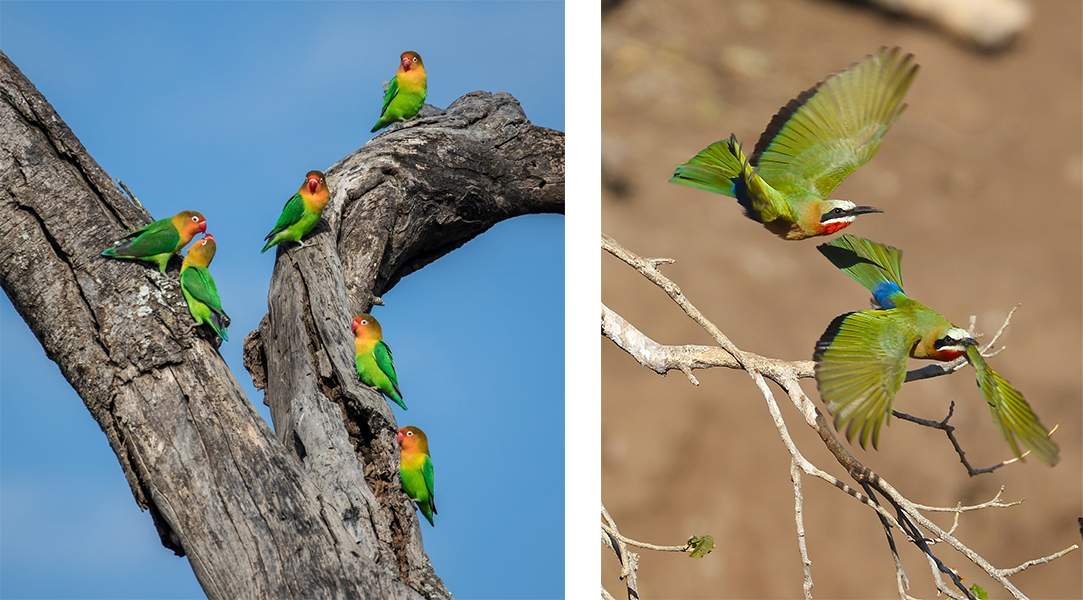
For both sundowners and bird-watching, Mark & Miles decided to take a boat cruise that evening. Though a little bit early for the arrival of European and North African migrants (November), the diversity of birds of prey and waterbirds was very good.
July 22nd: Chikwenya Camp – Mana Pools
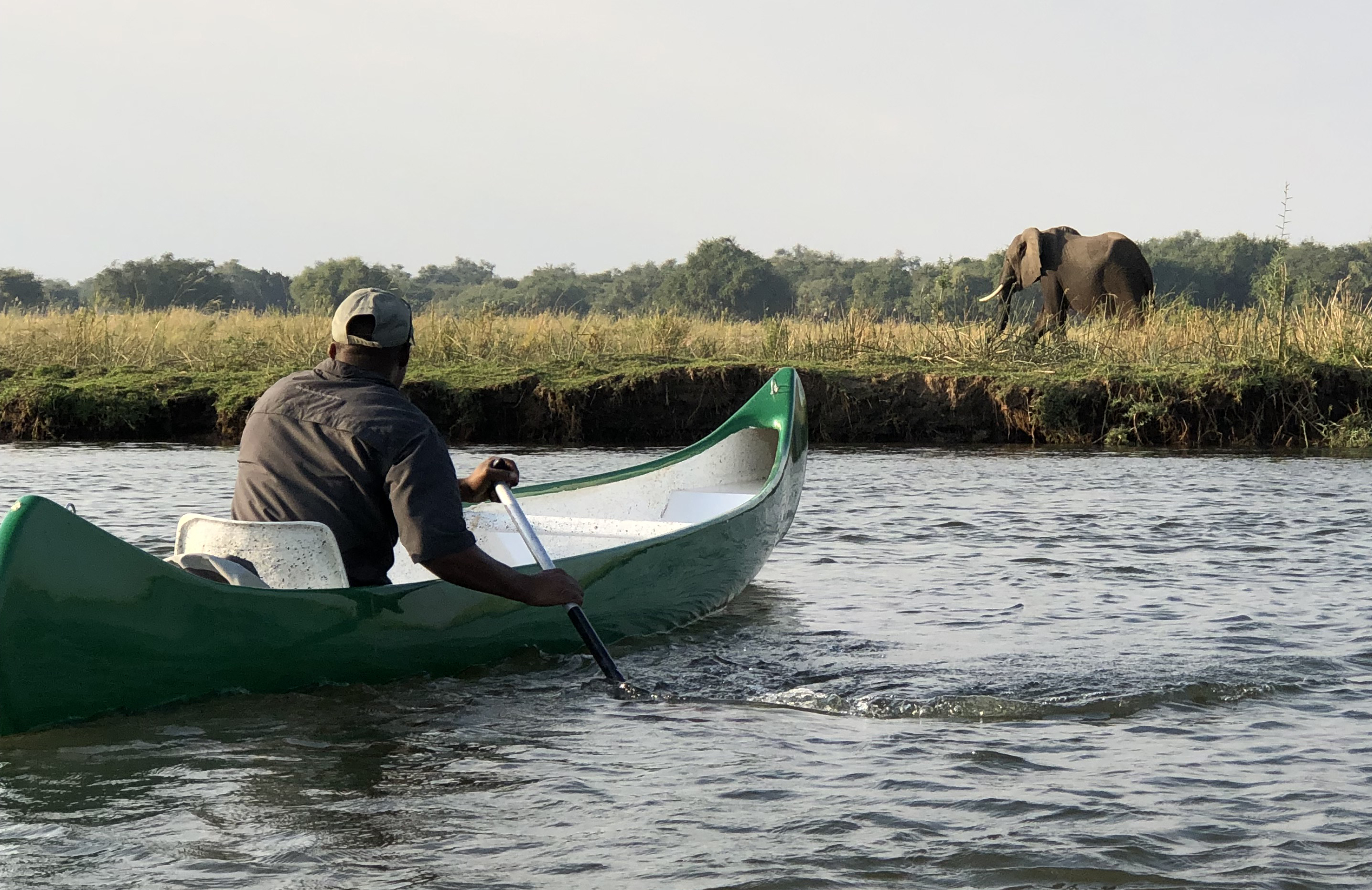
The day began with a two-phased plan: in the morning, Mark and Miles were to canoe, while in the afternoon, they would attempt to find the wild dog pack that was spotted prior to their arrival yesterday.
Because it was a little bit windy that morning, not as many animals were on the floodplain and islands as normal. But Mark and Miles still had some great sightings of elephant, hippo, and numerous birds.

Though Mark and Miles had no look with finding the wild dog pack from yesterday, they did have numerous elephant sightings, and most interestingly, a lot of eland sightings. Eland are equally known as Africa’s largest antelope and perhaps its most skittish – Mark and Miles were therefore quite surprised at how often they got close to the elands.
July 23rd: Chikwenya Camp – Mana Pools
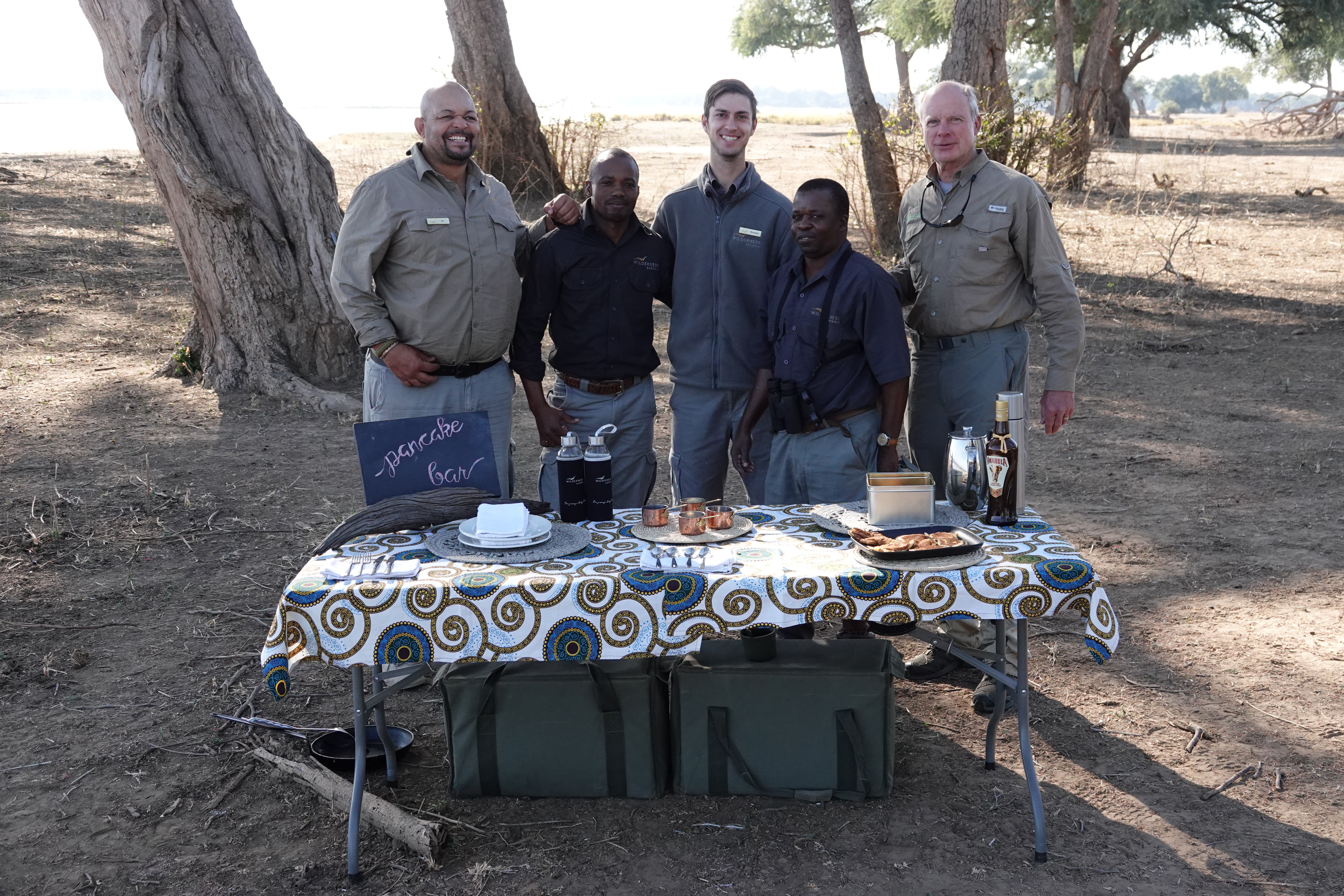
Before departing to Ruckomechi Camp, Mark and Miles decided that they would go for a guided walk along the Zambezi floodplain. AB, their guide, showed them evidence of the wild dog pack’s kill from the previous day along with identifying several birds by their call. Instead of immediately returning to camp, Mark and Miles were surprised with a farewell “bush brunch.” Mark especially appreciated the made-to-order pancakes!
July 23rd-24th: Ruckomechi Camp – Mana Pools

July 23rd: Ruckomechi Camp – Mana Pools
After flying back on a scheduled charter to the Mana West Airstrip, the game-viewing began almost immediately after Mark and Miles stepped off the plane. The crescendo was spotting a leopard with a kill up a tree – the first leopard of the trip!
Ruckomechi Camp made a good impression on Mark and Miles from start to finish. Mark and Miles split one the camp’s two family tents – but all 10 of the elevated, canvas tents were spacious and comfortable. The shaded firepit and main area were also excellent. Miles spent both of his siestas there either reading or writing up his trip report notes; for dinner, it served as a great communal dining spot. They joined the Zillmans and Cohens (both AAC clients) for dinner that night, while the Peters were also staying at the camp.
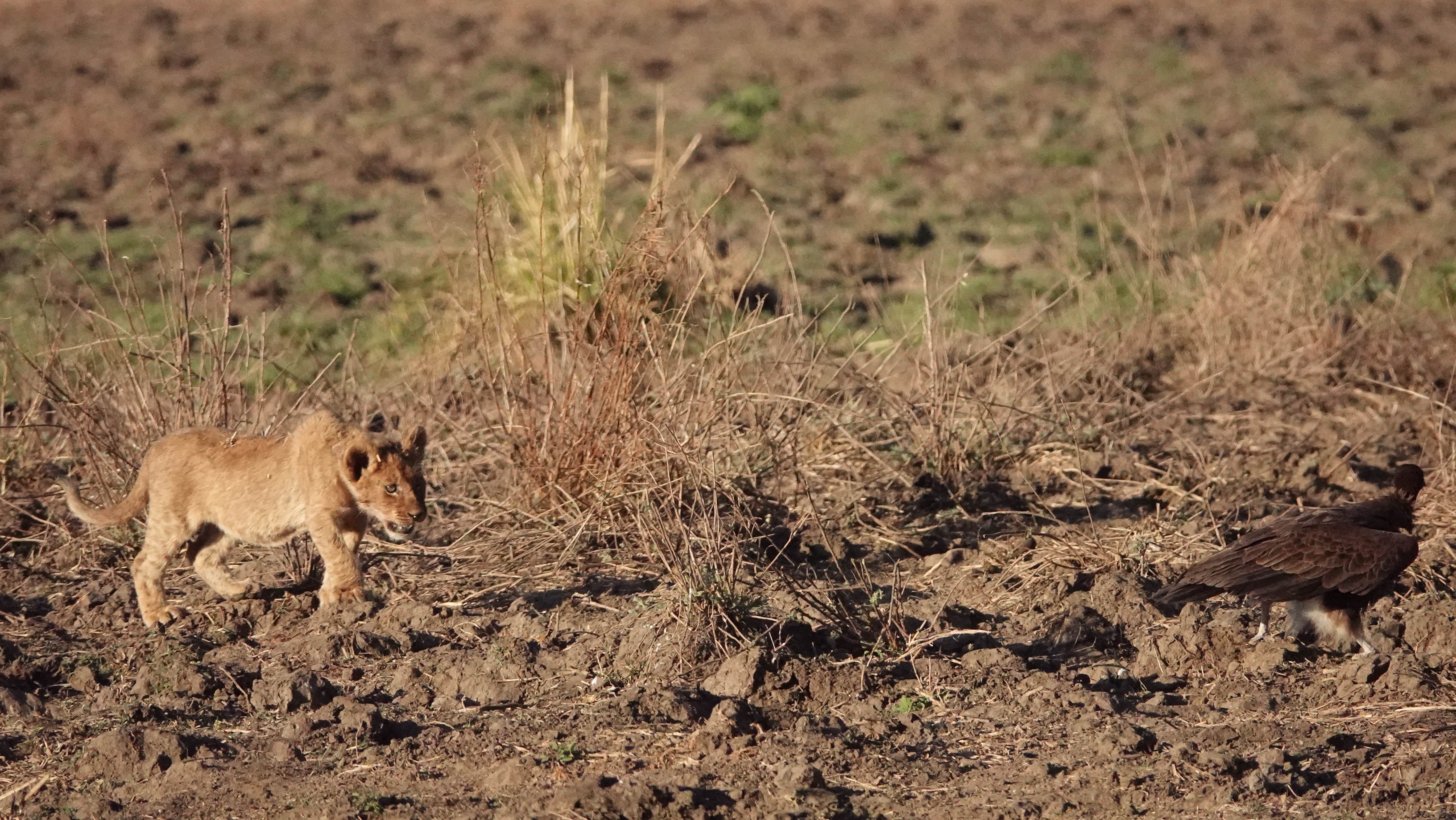
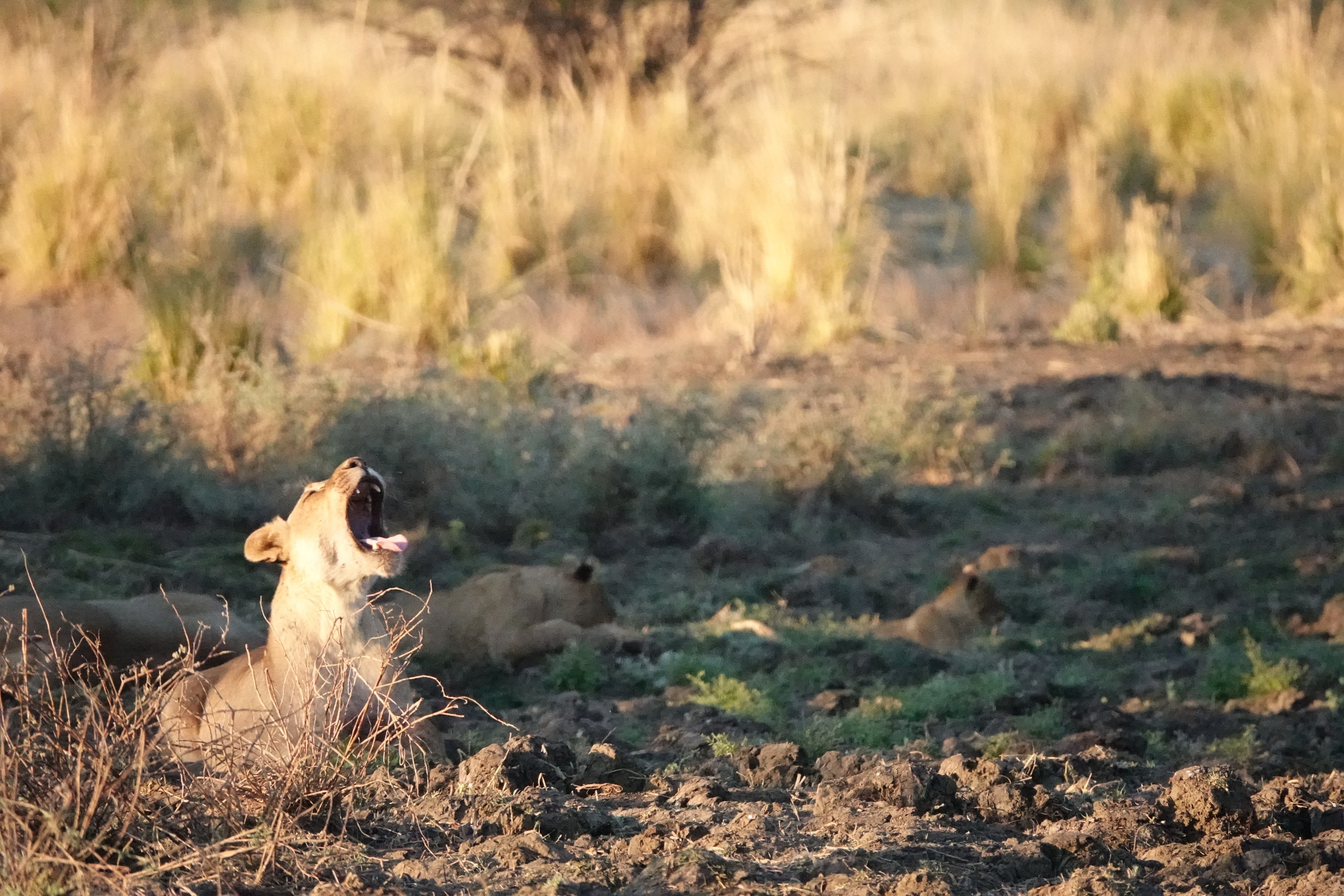
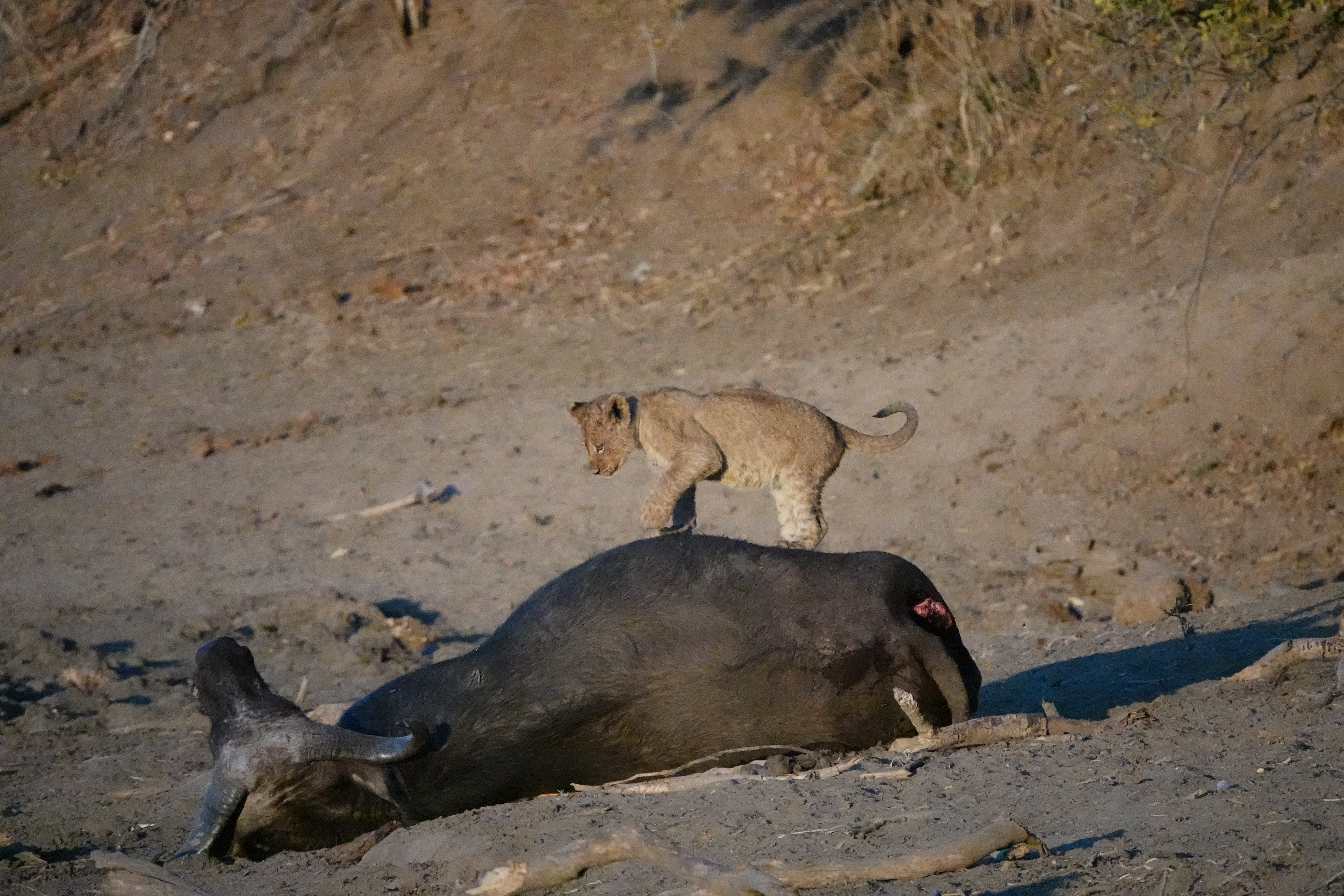
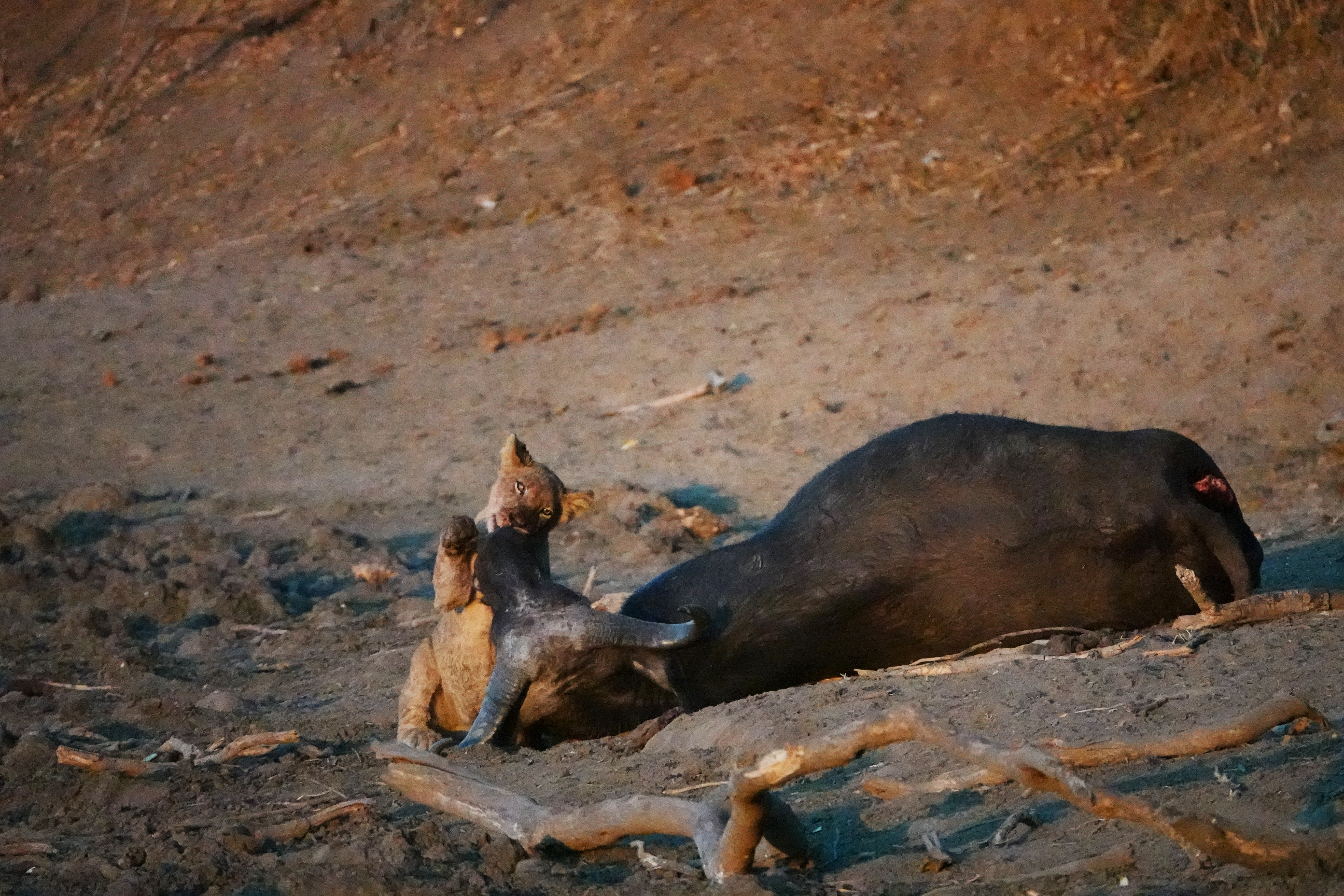
When Mark and Miles arrived at camp, they were informed that the guests’ who went out that morning got to see a lioness kill a buffalo! As a result, Mark and Miles departed with their guide Kurt to the scene of the kill.

The night drive they had was the best of Mark and Miles’ trip: they saw genet, a Verreaux’s Giant Eagle Owl, several hyena, a porcupine, and not one, but three leopards!
July 24th: Ruckomechi Camp – Mana Pools
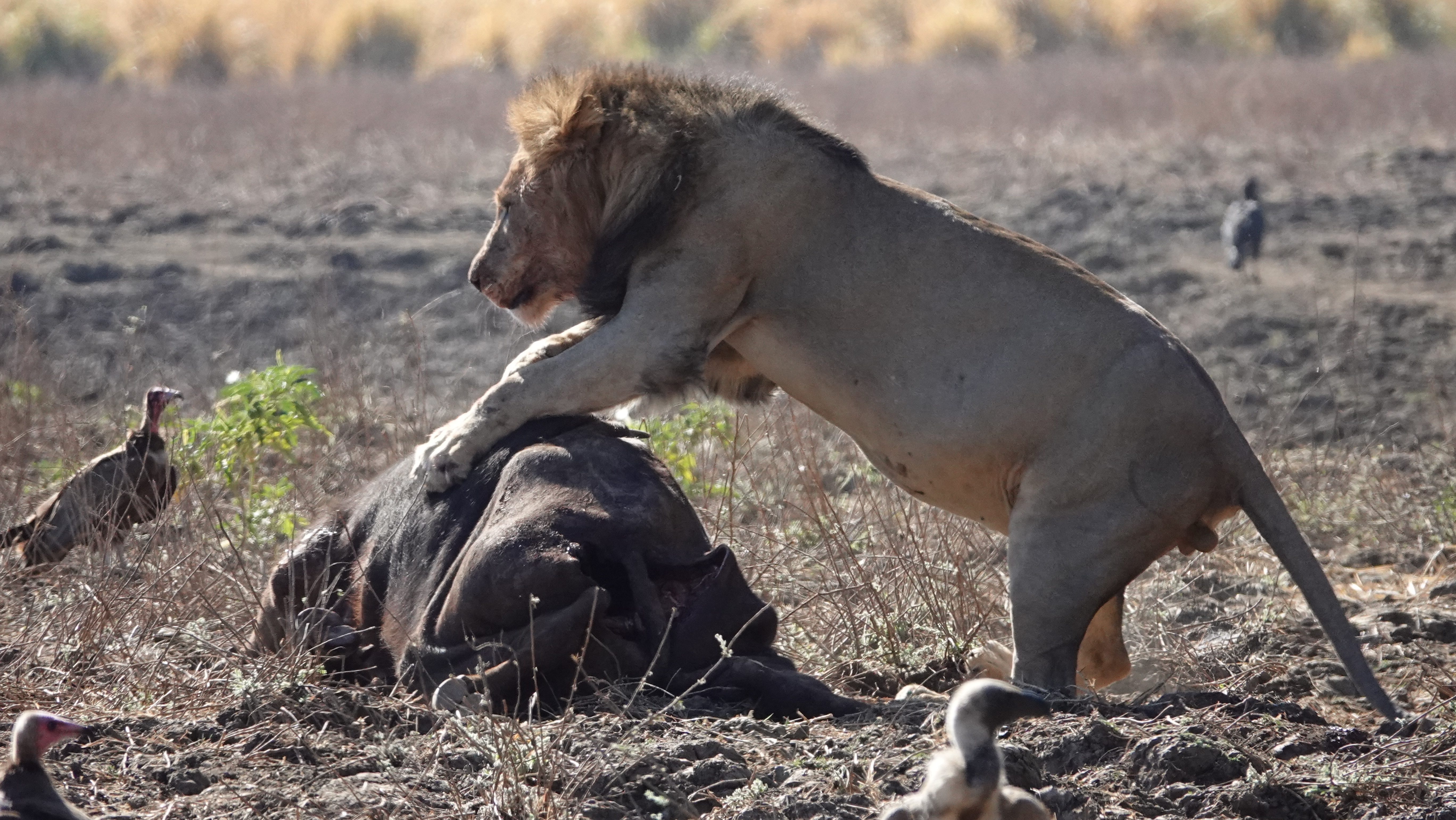
The following morning, Mark and Miles decided to return to the site of the buffalo carcass. The night prior, their was quite a verbal sprawl between the hyenas and lionesses. But Kurt said the hyenas dispersed once a male lion arrived on the scene. Just as he suspected, Mark and Miles saw a male lion join the pride upon their arrival. Watching the male lion push and drag the carcass was a reminder of how strong these felines are – and why hyenas don’t even mess with them!
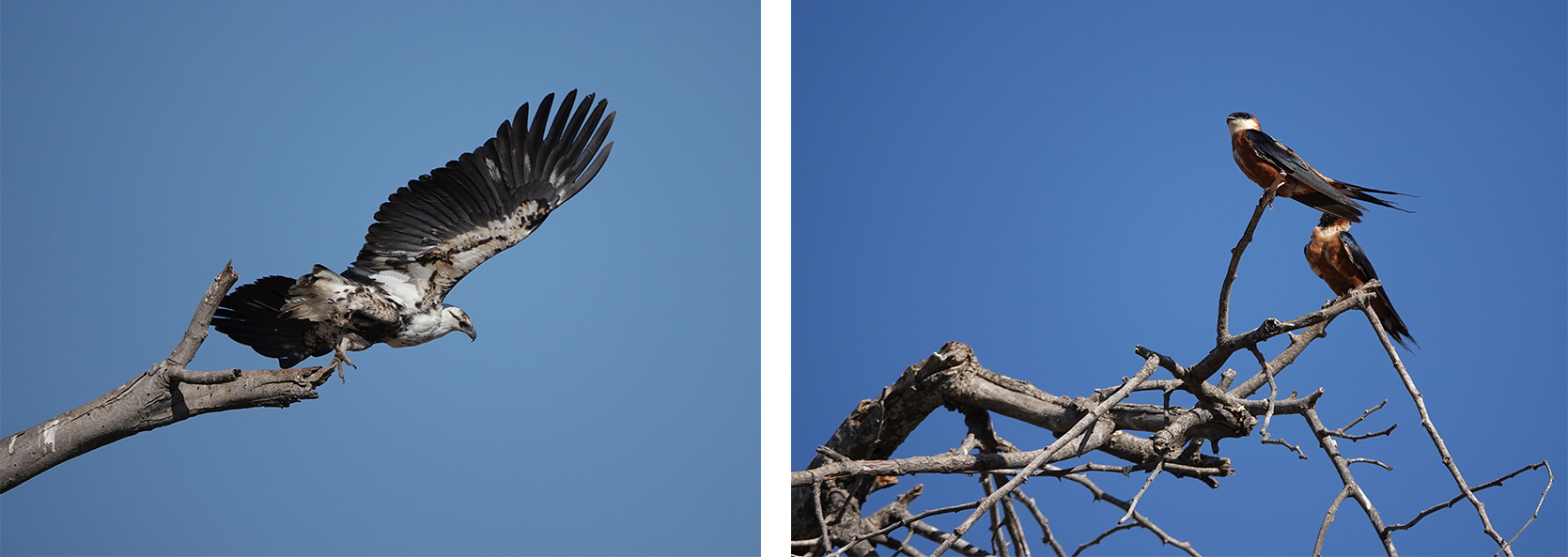

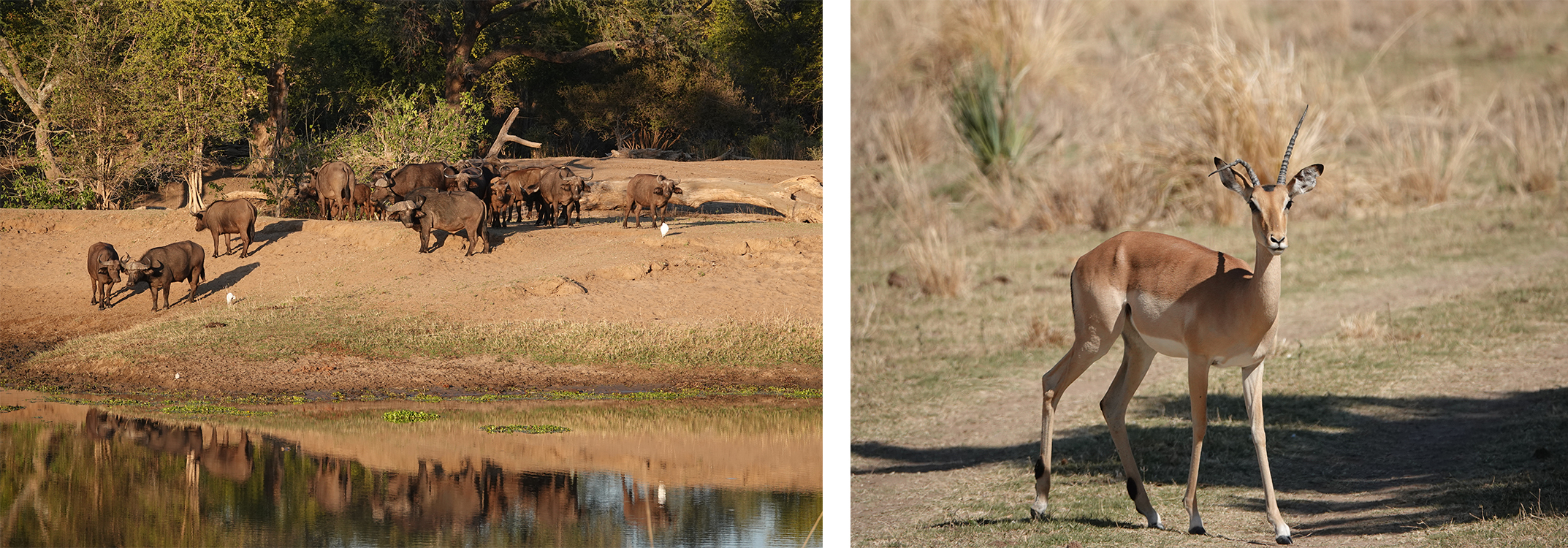
The remainder of the morning game drive brought a nice diversity of wildlife sightings, including several herds of buffalo, numerous different bird species, and a unique impala. The female impala (shown above) was unique because it had horns. Not only don’t female impalas normally grow horns, her horns were noticeably smaller than the horns of a typical male impala; one was even bent out of shape.

Before heading out for their afternoon canoe trip, Mark and Miles did a site inspection of Little Ruckomechi. Located nearby to its namesake, this camp is great for those who desire a more intimate, rustic camp, but still not sacrifice the comforts of the main Ruckomechi Camp.
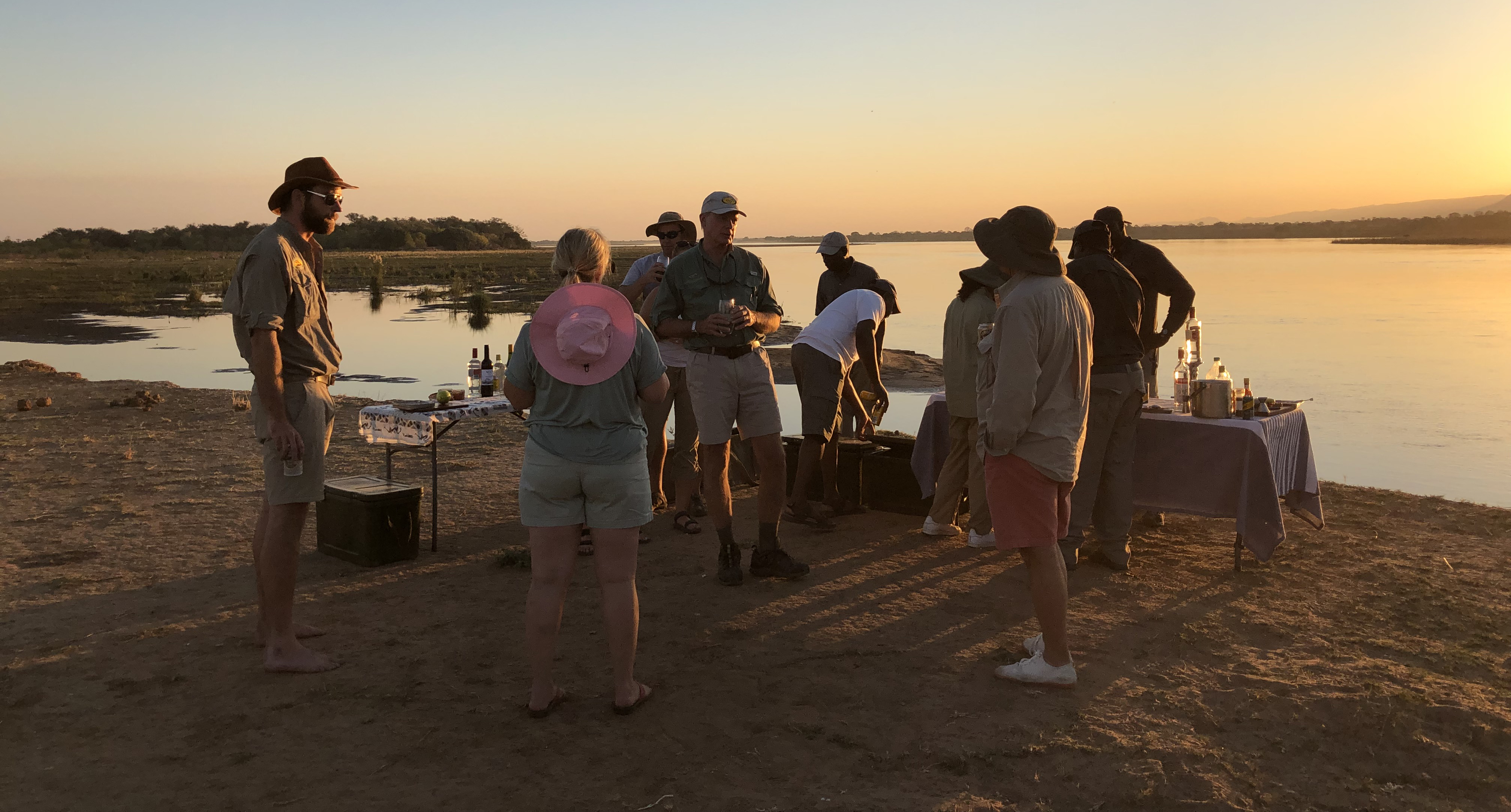
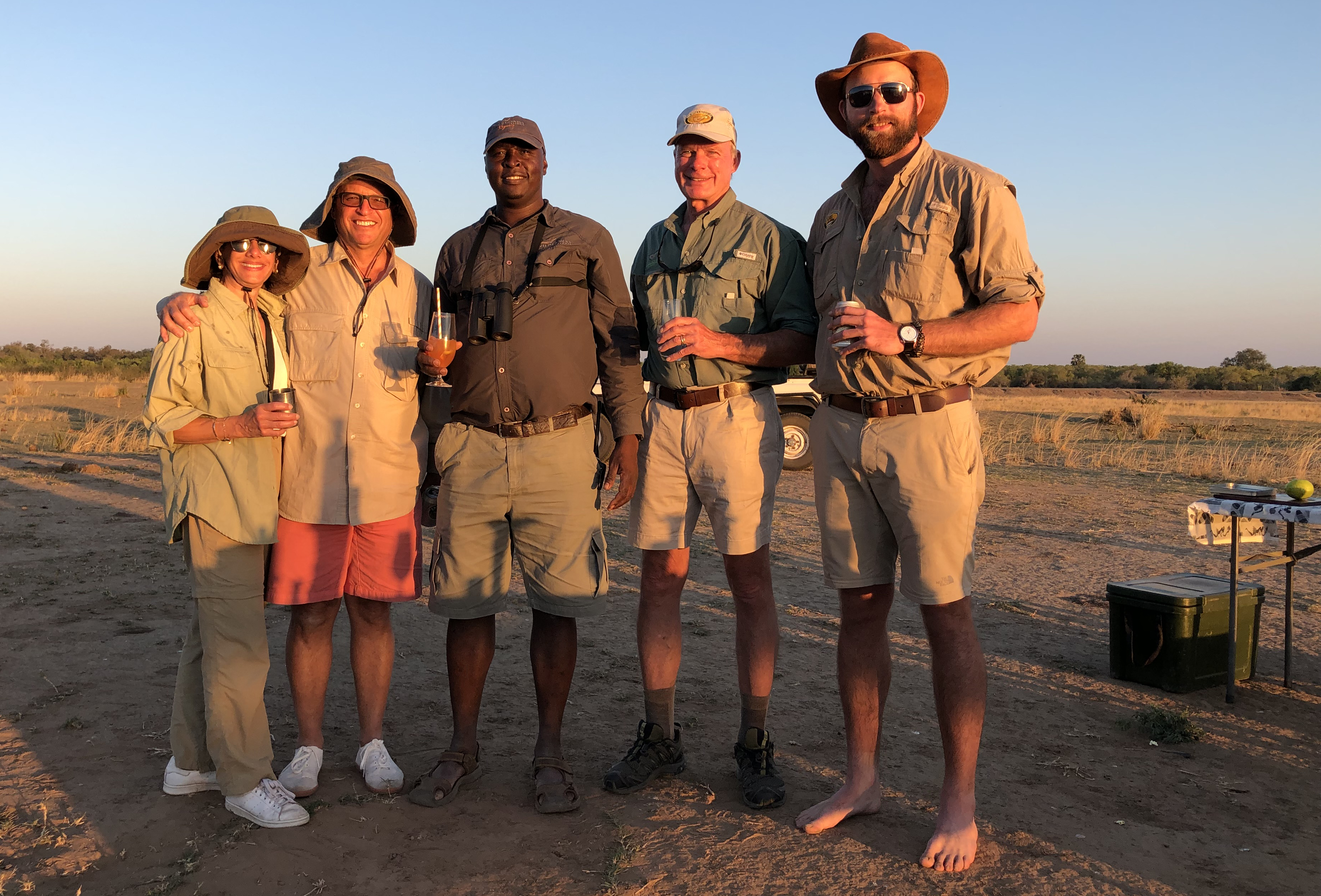
That afternoon Mark and Miles went on their third, and final, canoe trip. They were joined by two other groups, including AAC clients Diane and Larry Cohen. Though some people were a bit nervous about the trip, they were good sports up to the end. And as a pleasant surprise, the groups were rewarded with a sundowner – Mark and Miles’ eight in Mana Pools!
July 25th-26th: Busanga Bush Camp – Kafue
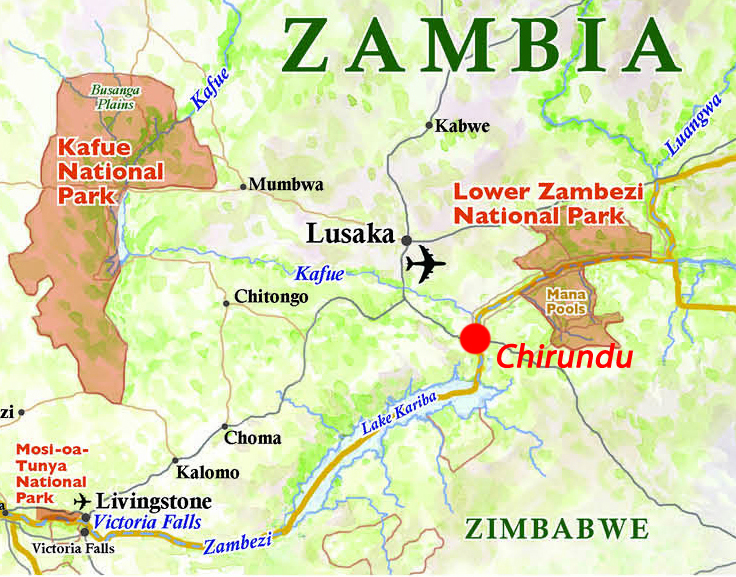
July 25th: Busanga Bush Camp – Kafue National Park
En route to Kafue National Park
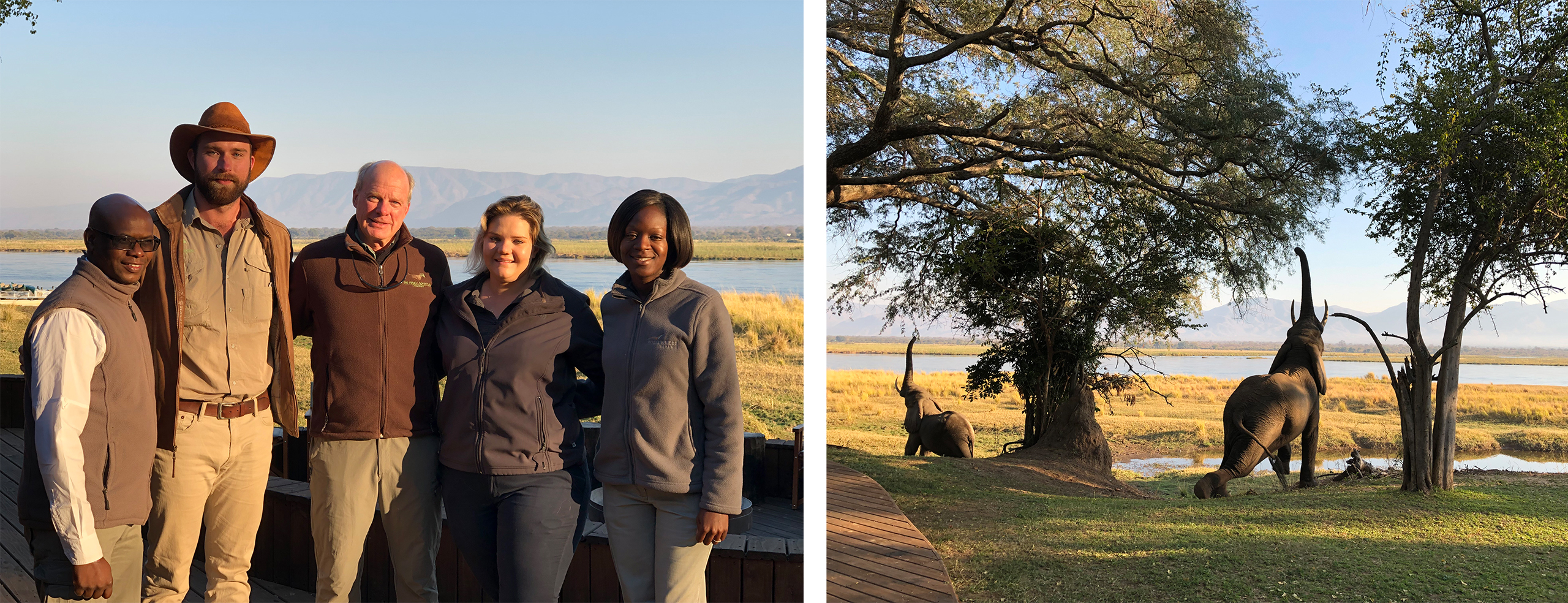
Before they departed for Kafue National Park in Zambia, Miles and Mark gave a special thank you to the great staff at Ruckomechi Camp. And as if it were a sign they shouldn’t leave just yet, two elephants arrived on the scene stretching for some pods!
Mark and miles decided to try a different, more adventurous type of transfer. Namely, they took an 1.5-hr boat ride to the border town of Chirundu. From there, they were picked up by a driver, who quickly escorted them through immigration before driving 3 hours to Lusaka Airport. On arrival, they took a scheduled charter to Kafue National Park.
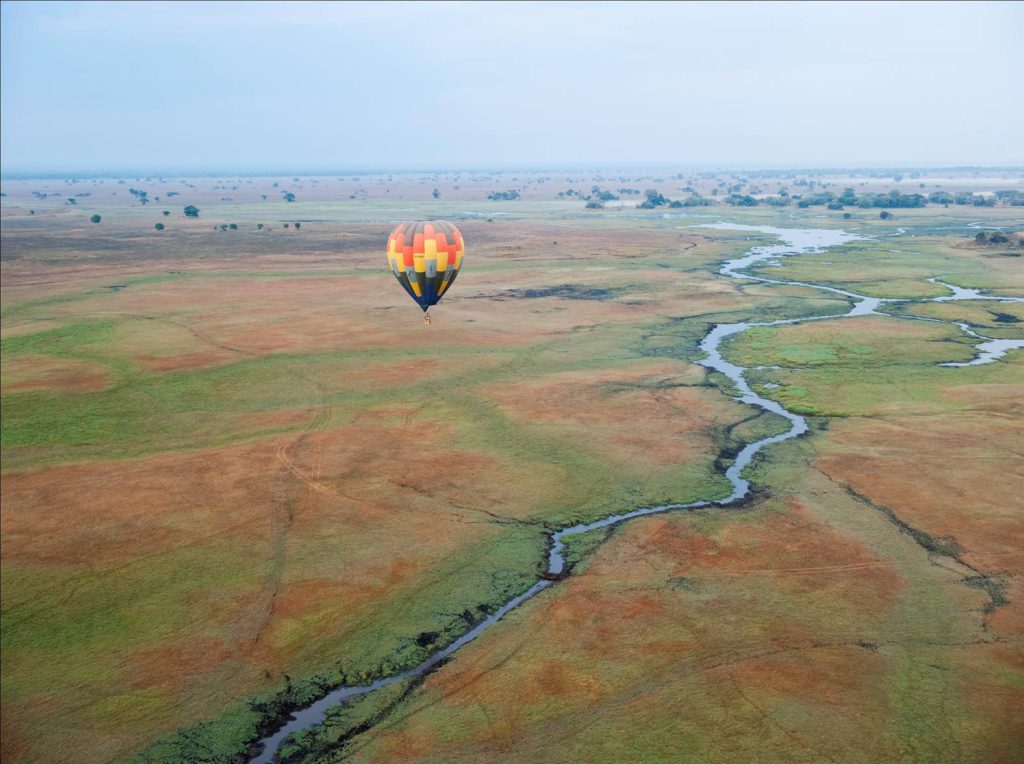
The Africa Adventure Company considers Kafue National Park to be a “hidden gem.” It is one of Africa largest wildlife areas, with the greatest number of antelope species (19) and a great concentration of lions and cheetah. In fact, of the three parks Mark and Miles visited, Kafue is arguably the best for cheetah. Despite this, Kafue had only 12,000 visitors in 2015; to put this in perspective, the similarly-sized Kruger National Park in South Africa had well over a million visitors in 2017!
The best wildlife area within Kafue is the Busanga Plains – think of it as a cross between Botswana’s Okavango Delta and the Serengeti plains in Tanzania and Kenya. Once the rainy season ends, narrow channels criss-cross the plains, meaning you will get unobstructed views of the wildlife that concentrates around the area’s only fresh water.
Arrival at the Busanga Plains
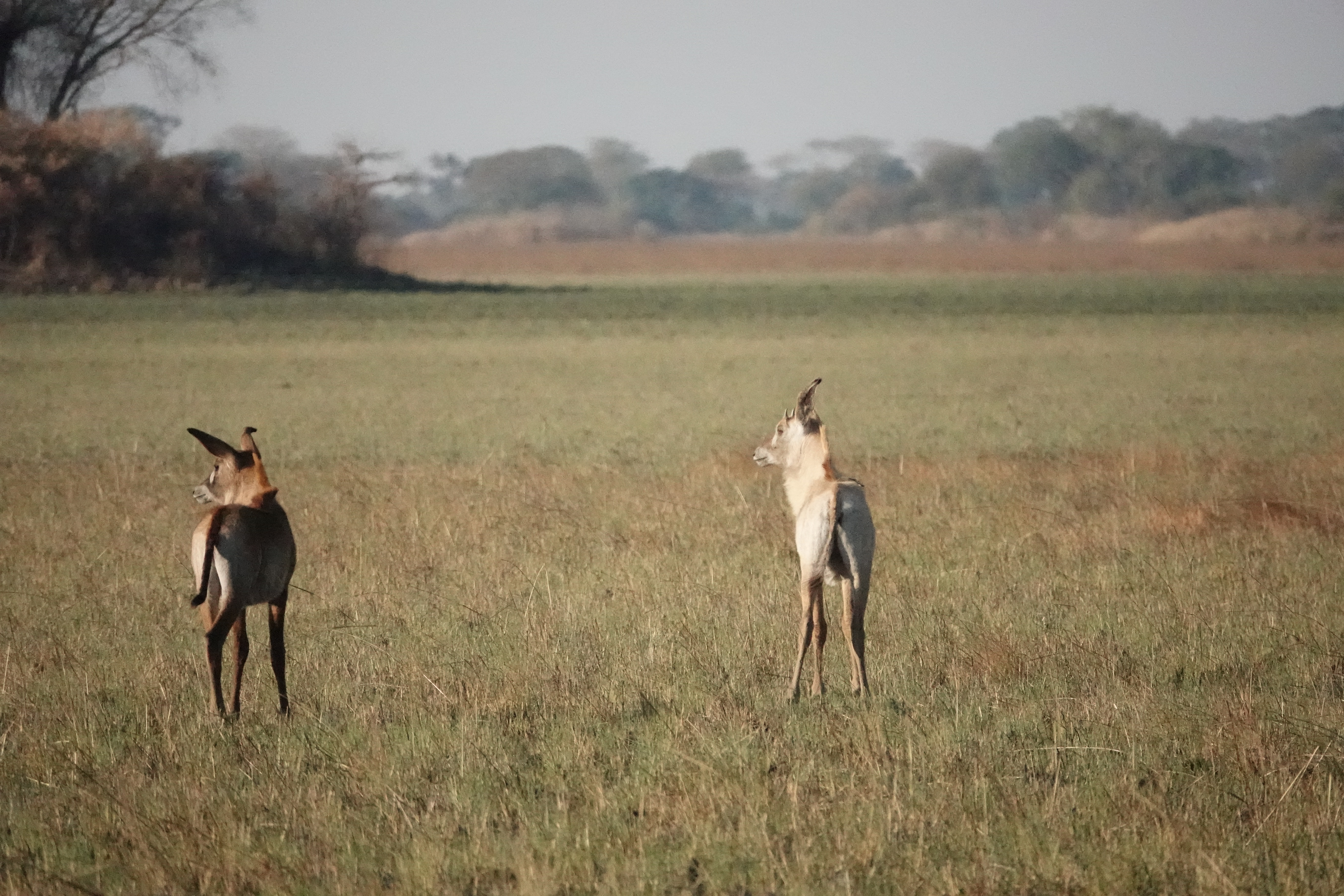
From the airstrip, Mark and Miles had a very unique sight. Among a large Roan herd, there was an albino calf – distinguishable by its stark, whitish coat. An auspicious start!

Mark and Miles stayed at Busanga Bush Camp. The small small features only four reed and canvas rooms, creating a very intimate camp experience for its guests. For guests who prefer a more rustic, less over-the-top feel, this is a great option for a visit to Kafue.
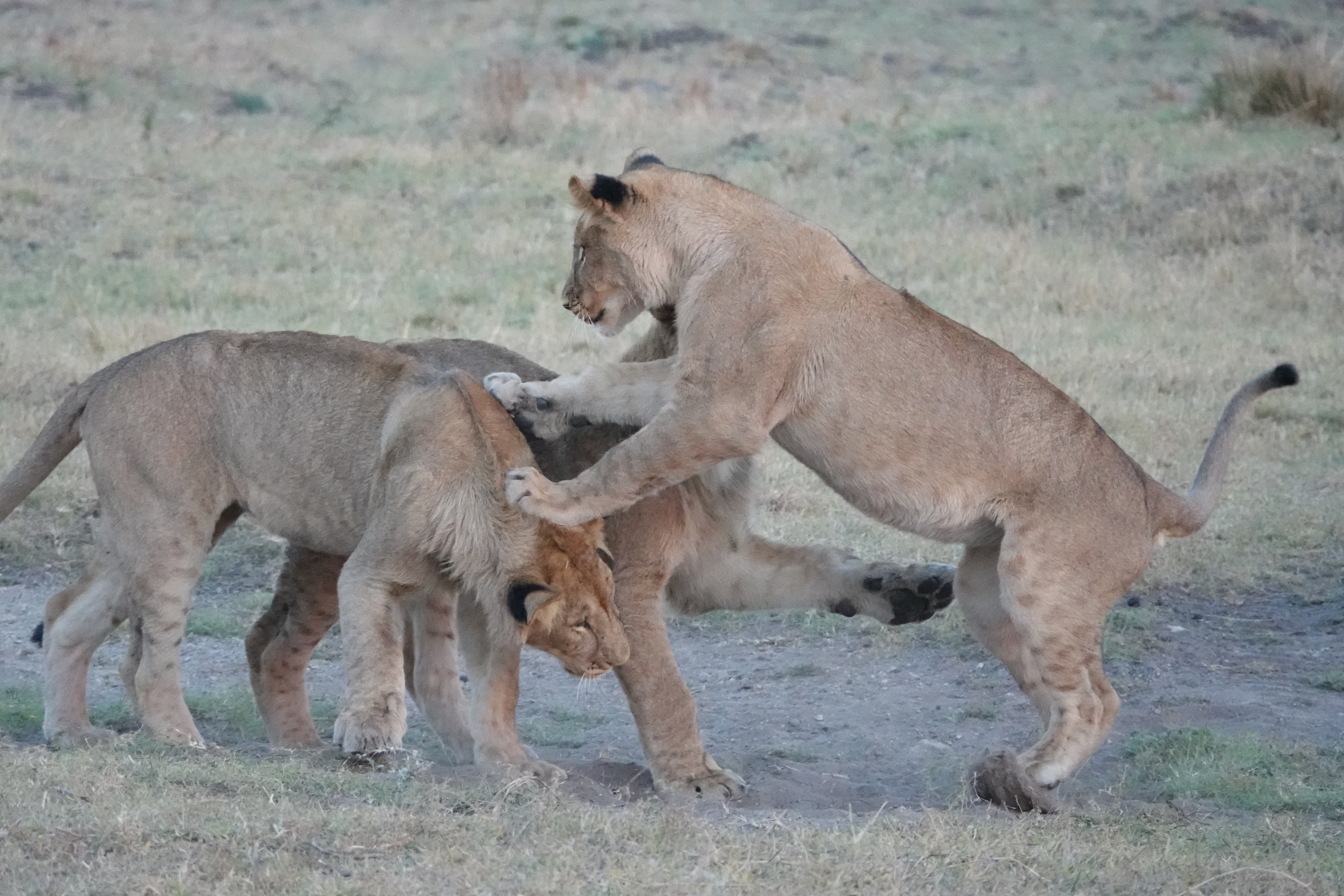
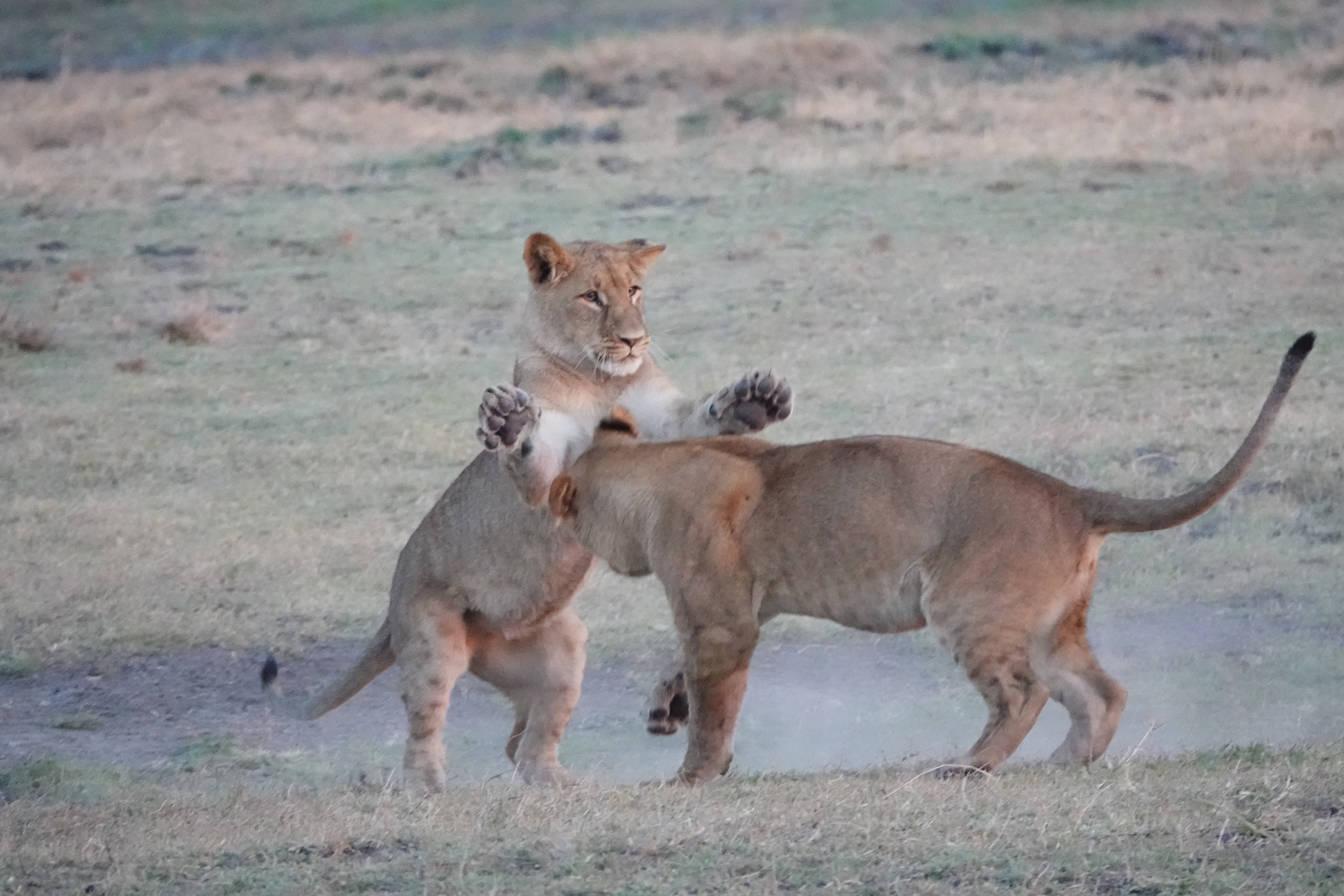
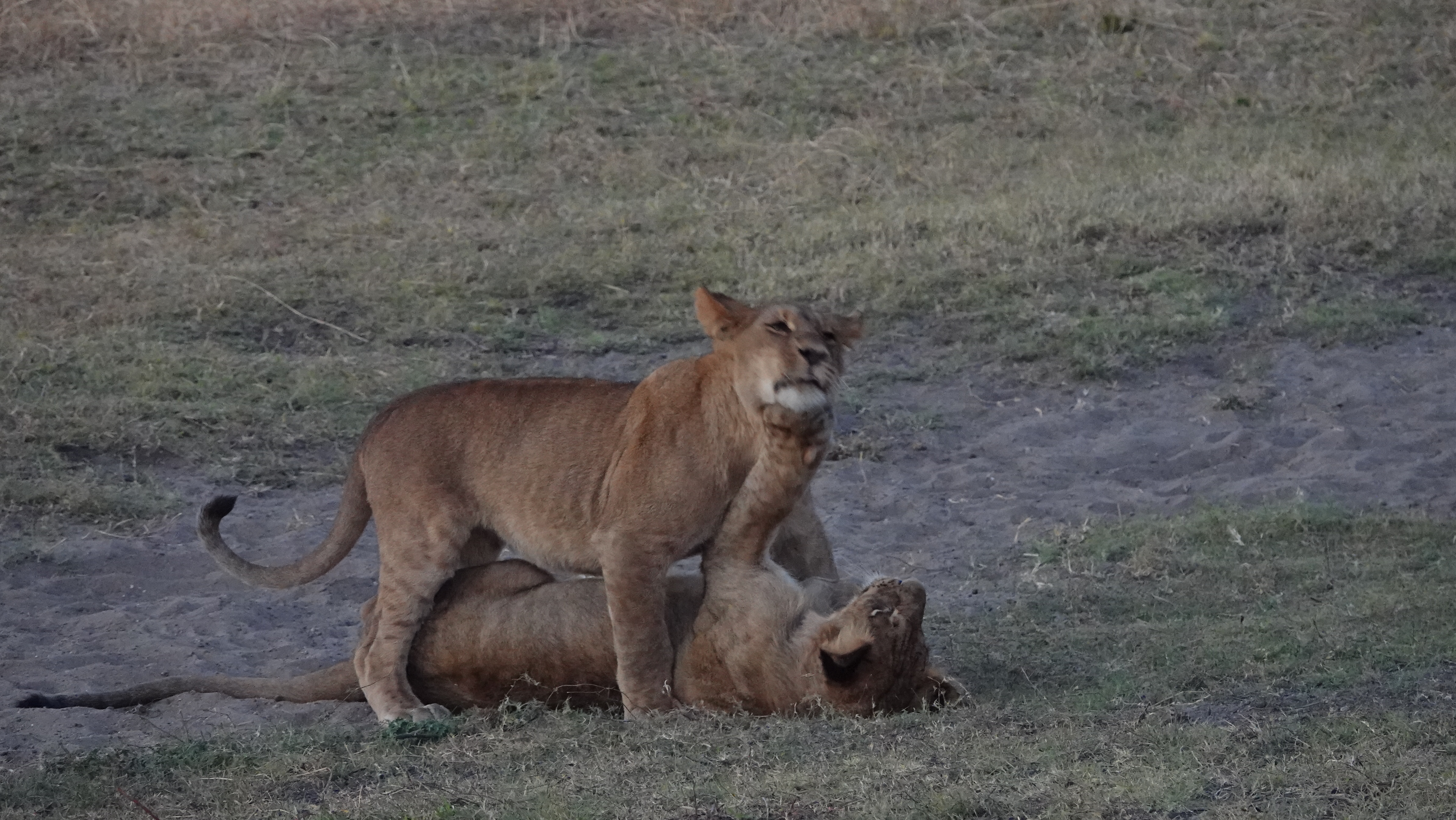
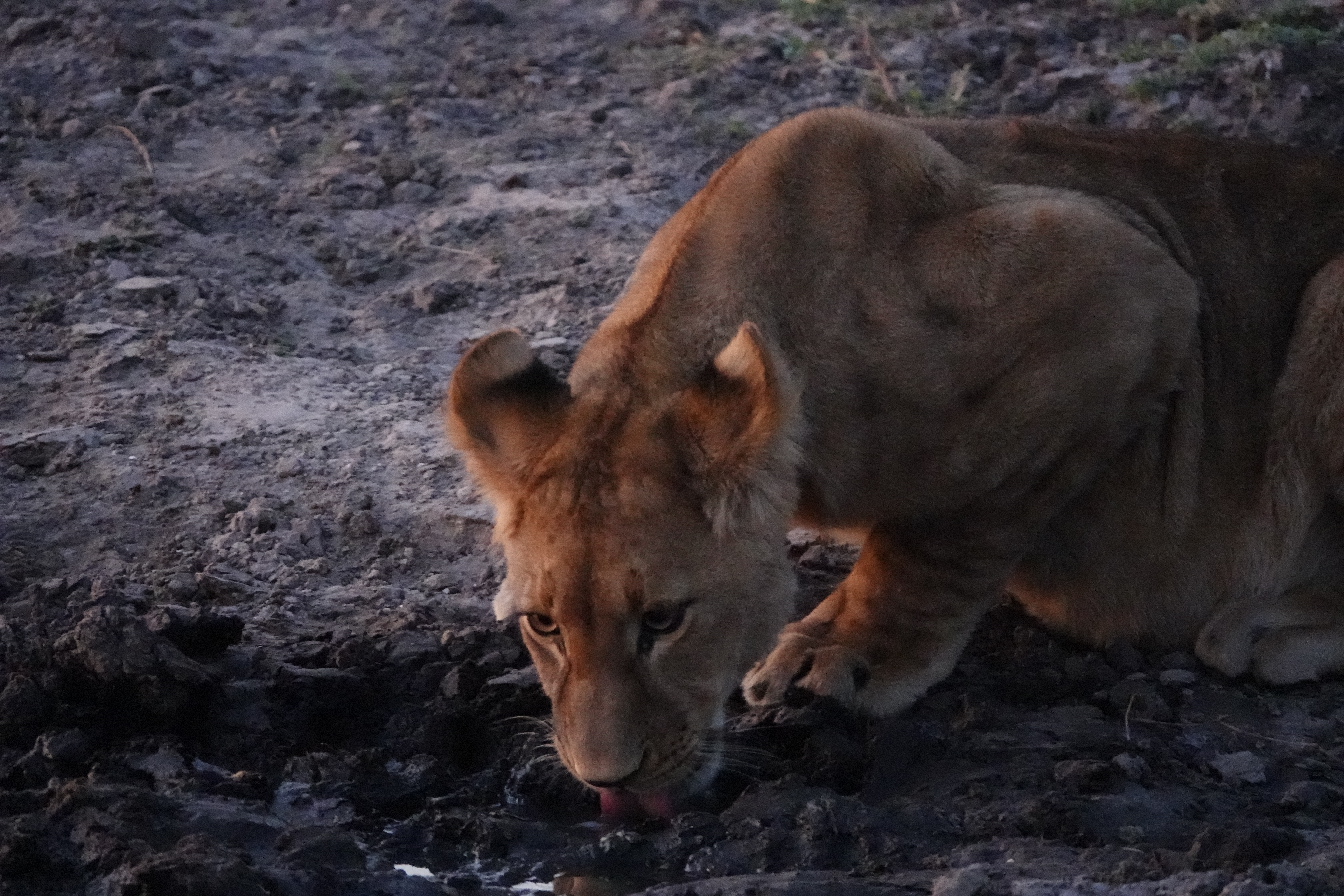
Mark and Miles met their guide, Isaac, before heading out for their afternoon drive. They followed his suggestion and pursued a small pride of sub-adult lions spotted nearby. Though closer to the size of an adult than a cub, these sub-adults behaved just like cubs – prancing around, play-fighting. It was really charming to see!
July 26th: Busanga Bush Camp – Kafue
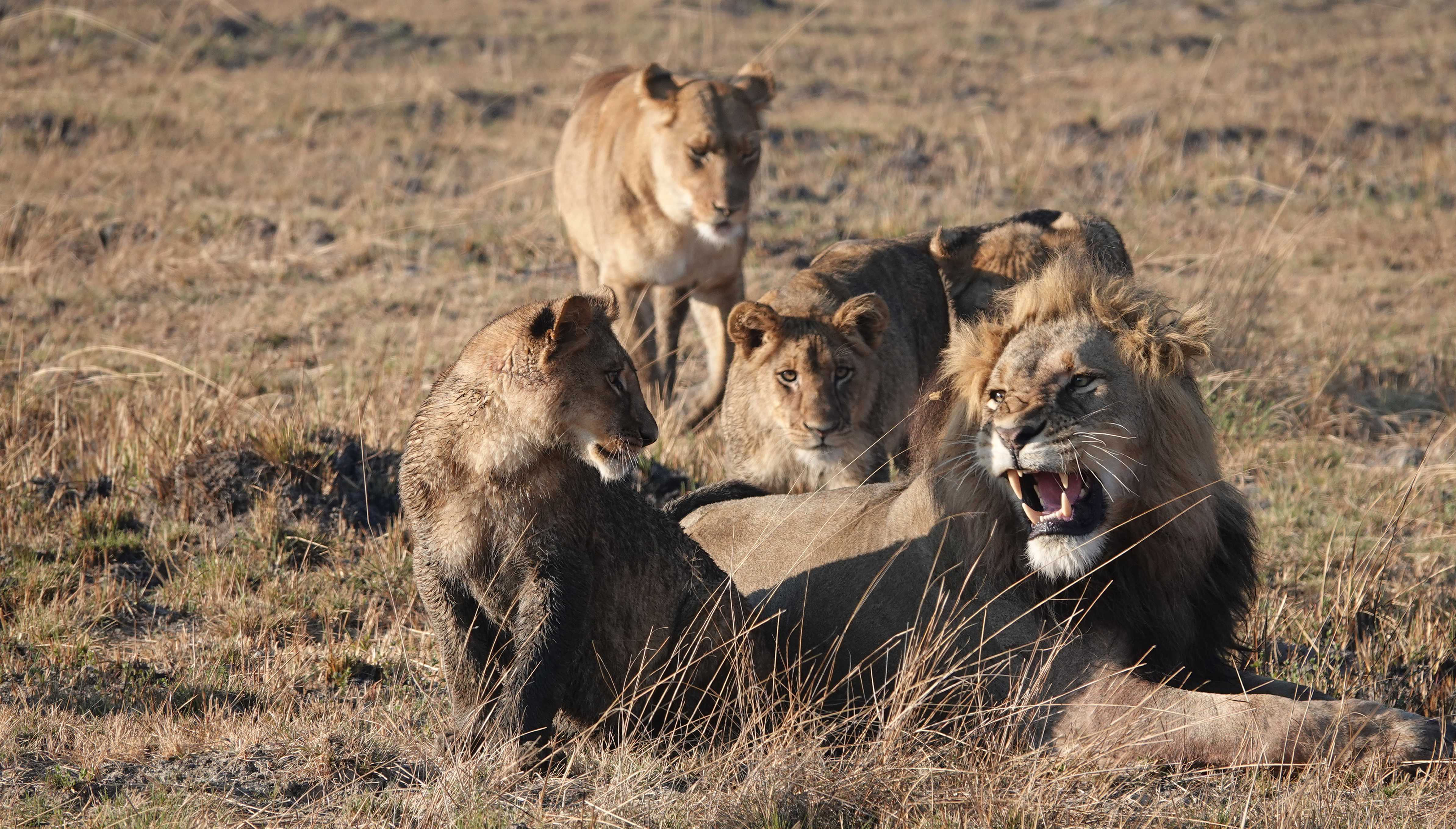
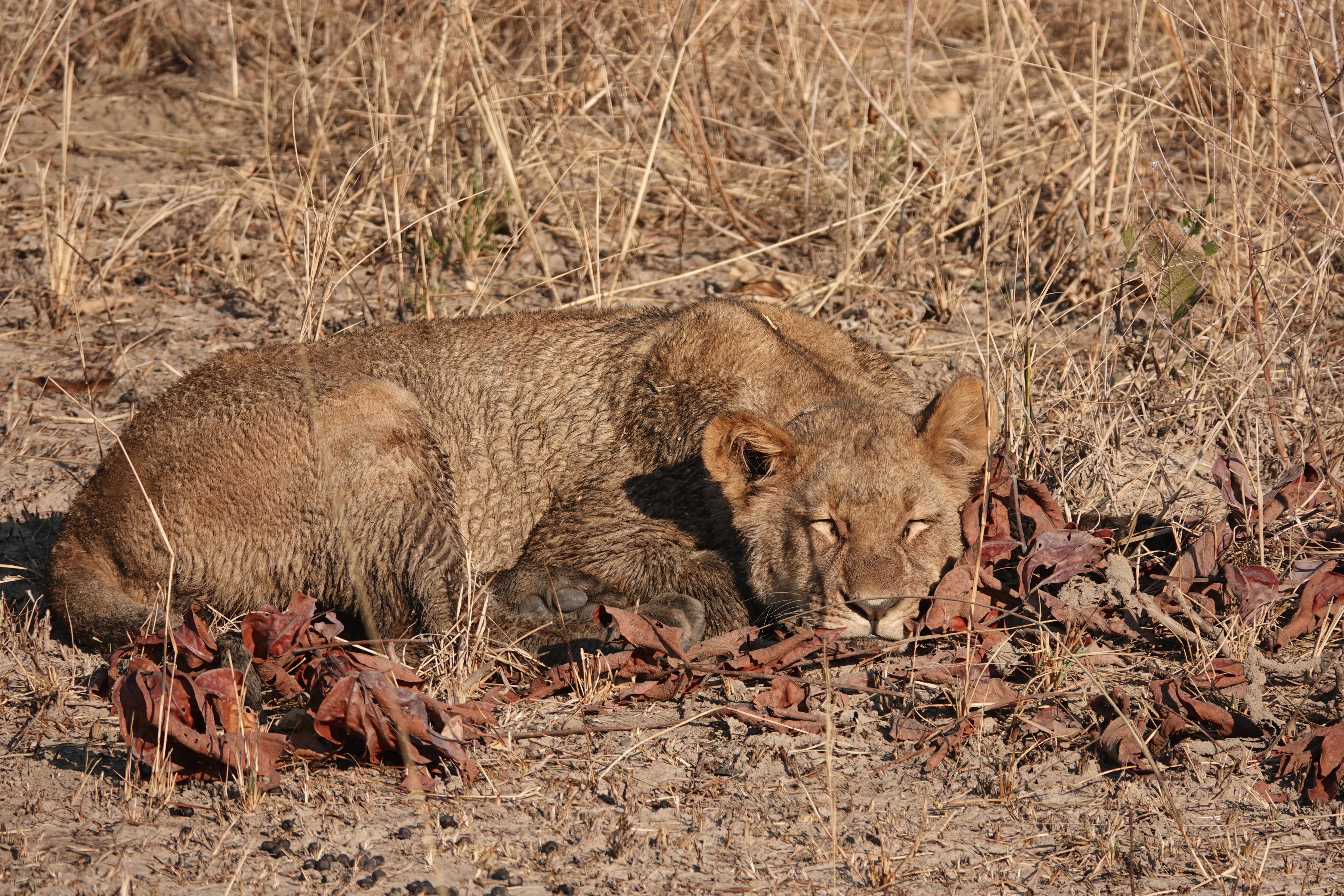
The following morning, Mark and Miles pursued the same lion cubs they saw the previous evening. Lucky for them, they all came out to greet them – or more likely, the cranky male lion who joined them the previous night!
But as the sun and temperature rose higher, all of them settled down for a nice, snug mid-morning nap. Off to explore the rest of Busanga Plains!


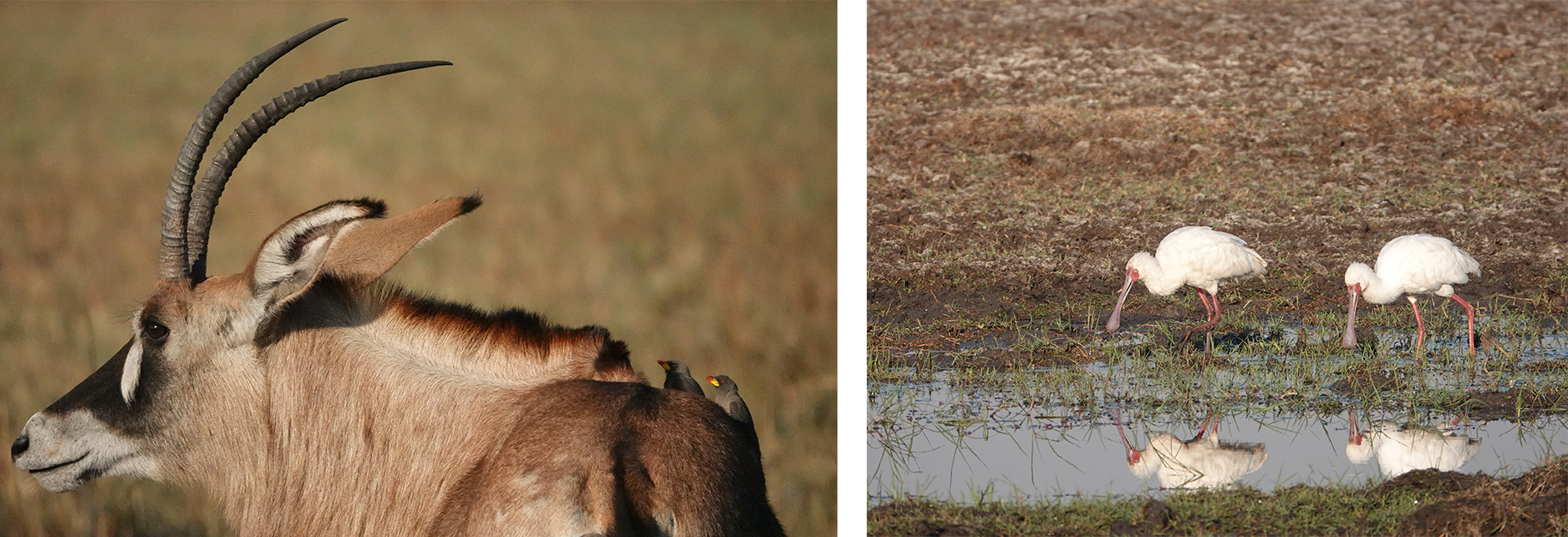
What Mark and Miles found was a fascinating collection of antelopes, birdlife, and especially hippos. Despite the low water levels, the Busanga Plains is full of hippos – as long as there is water and enough grass to graze, a hippo is content!
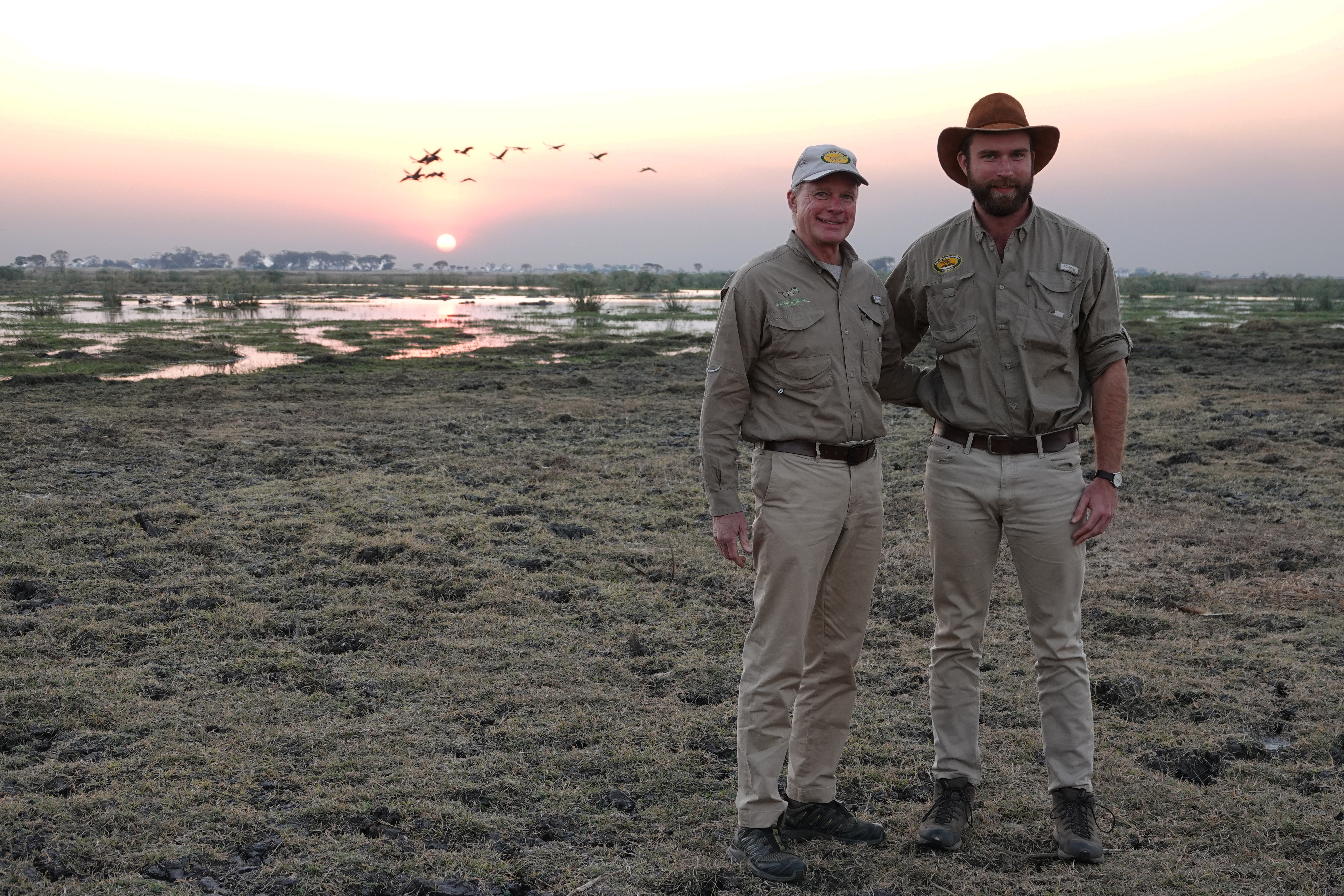
The day culminated with a celebratory sundowner: today was Miles’ birthday. “This trip has been surreal – I don’t know if I quite believe I experienced the things I did and the animals I saw. What a way to celebrate a birthday.” Miles said during dinner later that evening.
July 27th-28th: Shumba – Kafue

July 27th: Shumba – Kafue
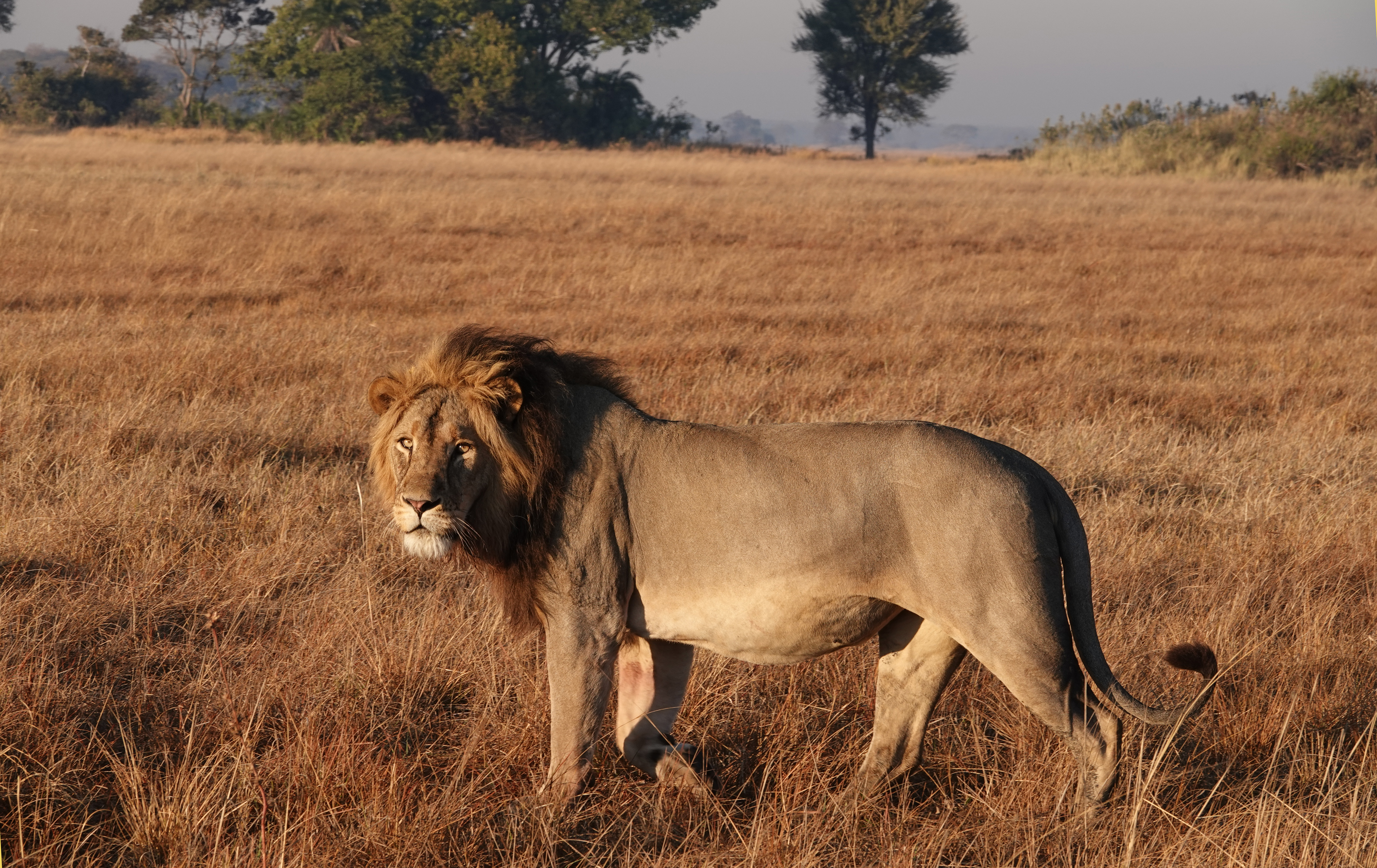
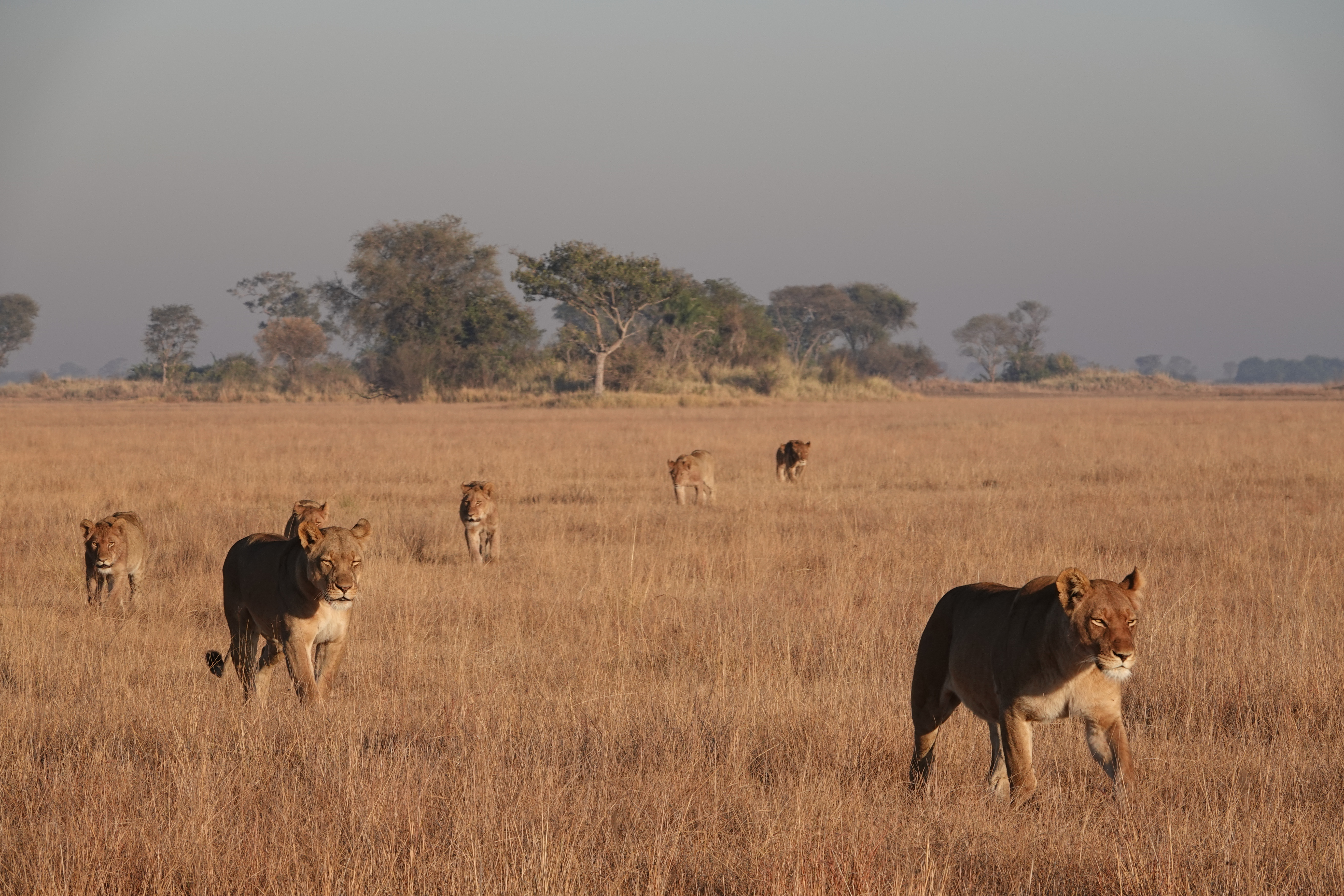
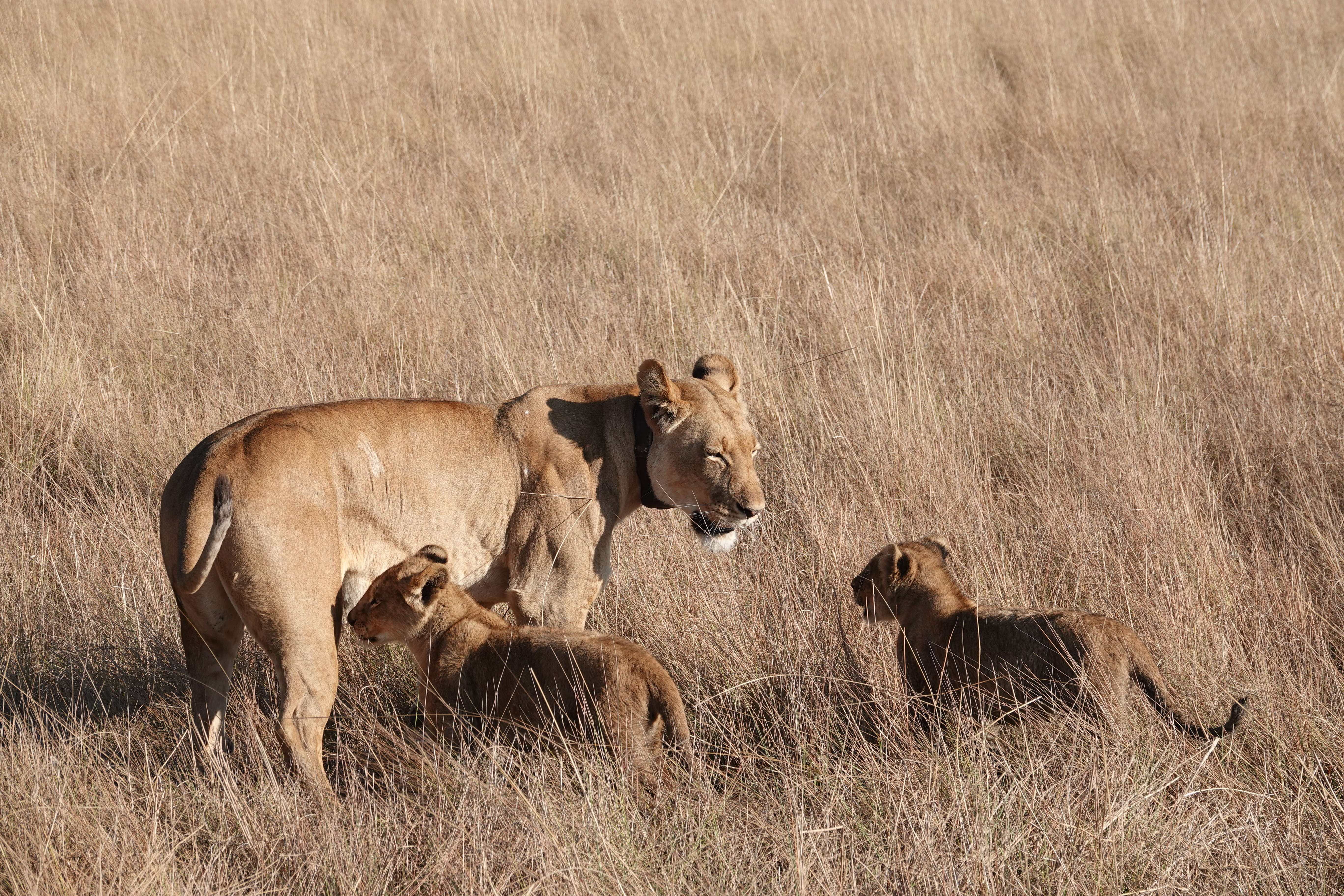
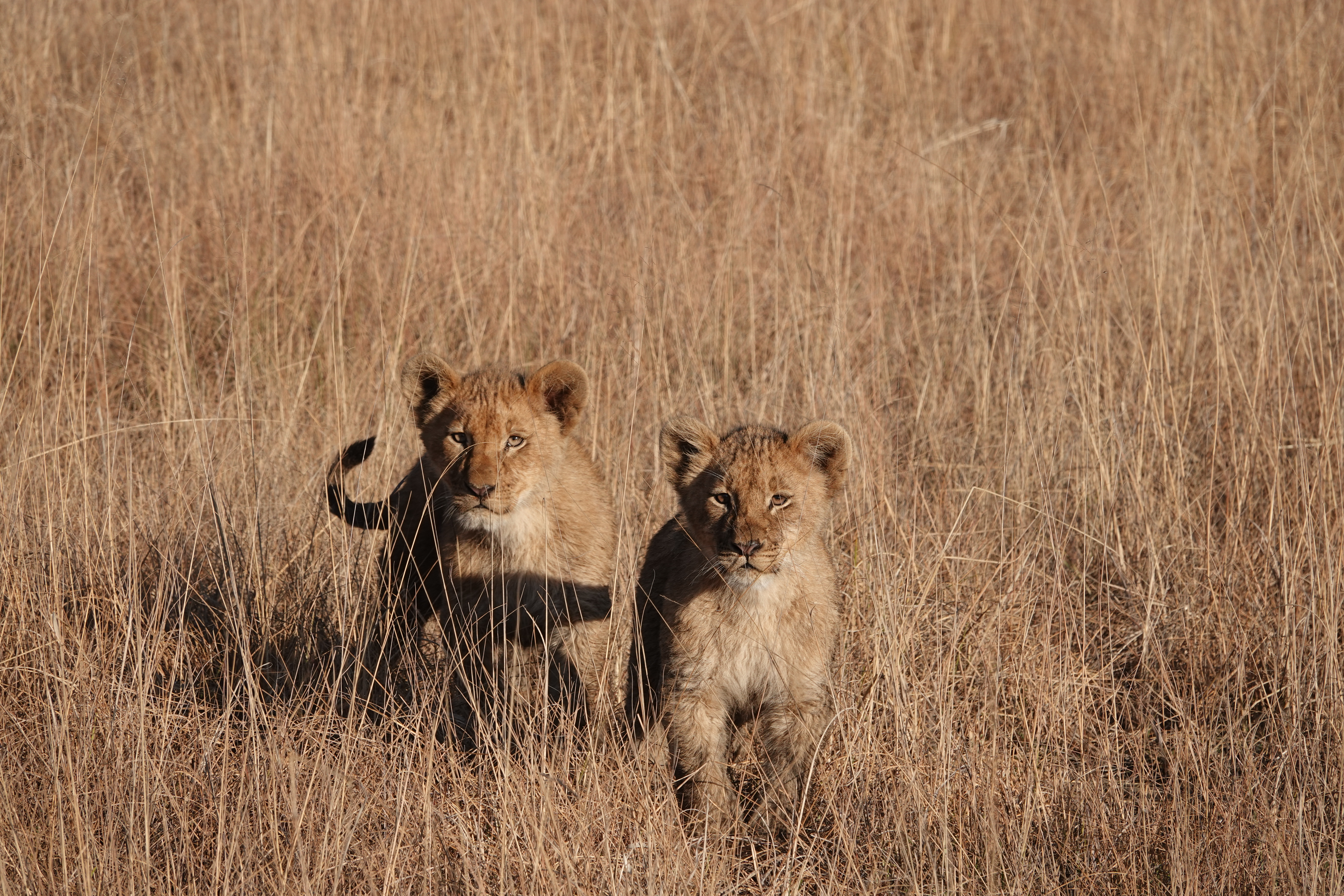
Before transfering to the nearby Shumba Camp, Mark and Miles went on one more game drive. They got word that guests had spotted cheetah yesterday. In pursuit of them, they once again stumbled upon the lions they had seen the previous two days. Only this time, they were joined by two adorable, curious cubs!
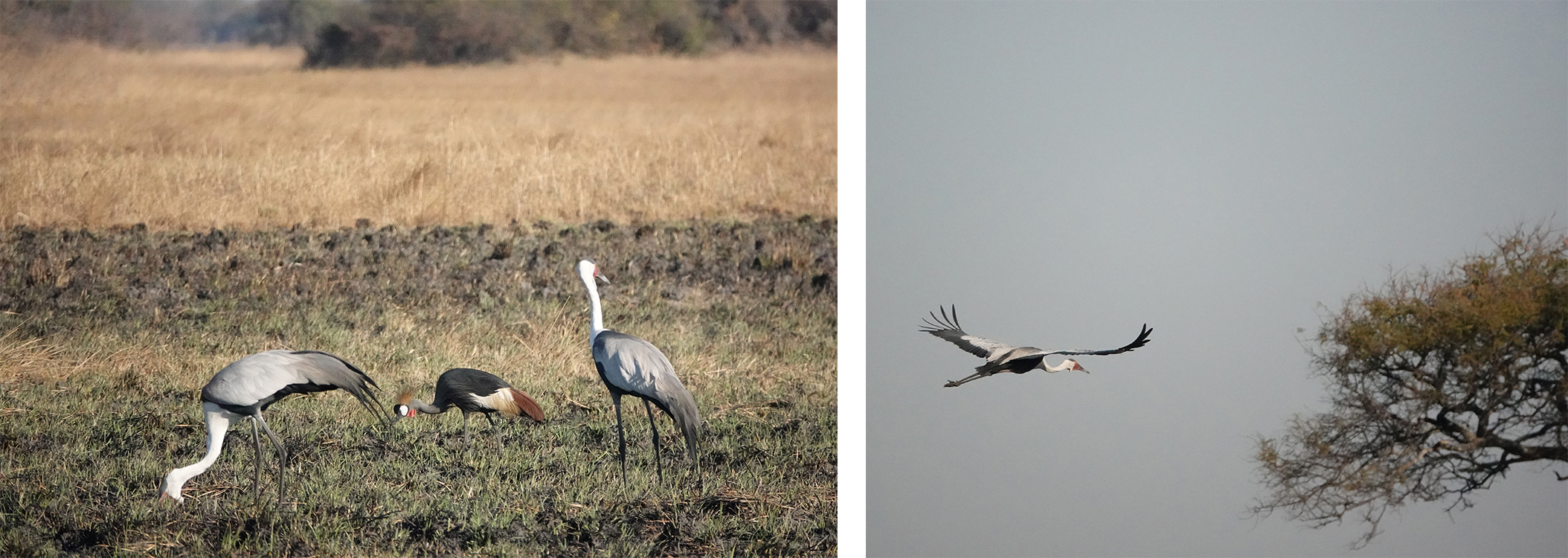
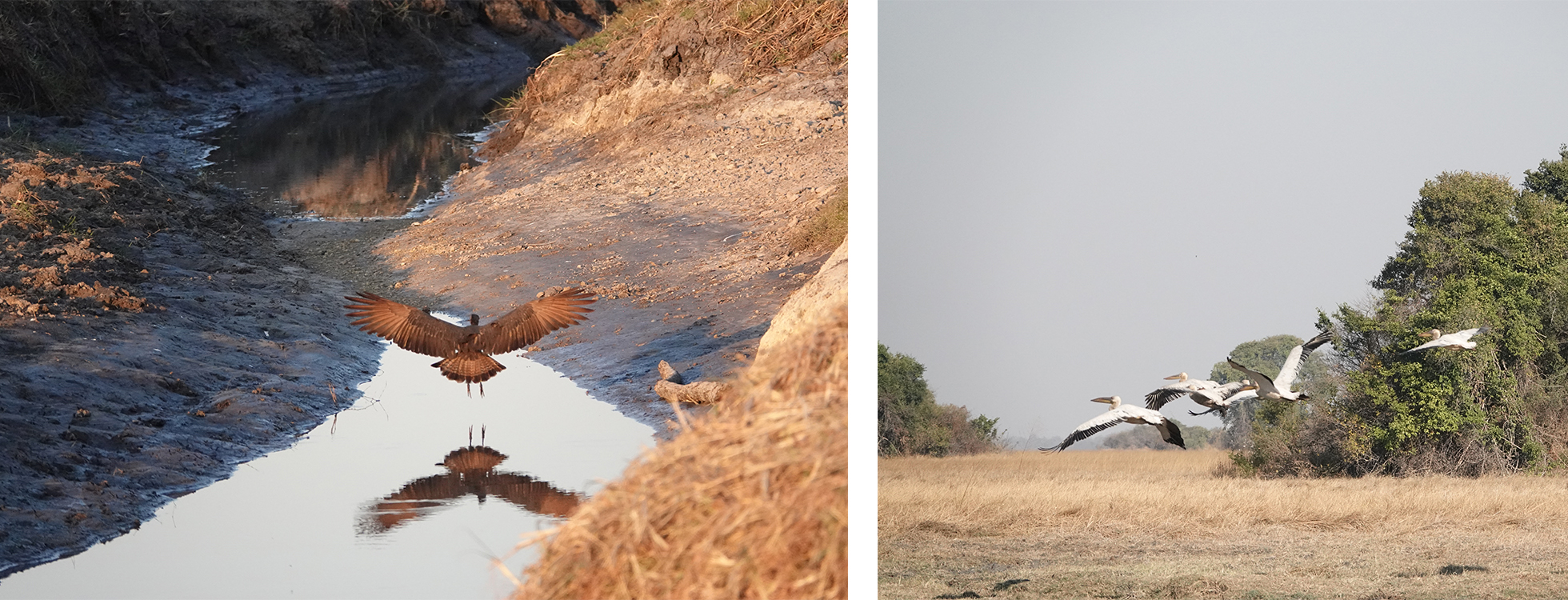
Kafue is also an excellent area for birdlife – particularly the Wattled Crane. The Wattled Crane is an increasingly vulnerable bird species due to habitat loss – Kafue happens to be arguably the best place in the world to see them.
Mark and Miles settled into their new, and final camp, quite nicely. Shumba Camp features six luxurious tents on raised platforms. From both the tents and common area, guests have stupendous views of the surrounding Busanga Plains. Just like Busanga Bush Camp, the staff at Shumba were cordial, and the kitchen staff very creative with their delicious meals!
July 28th: Shumba – Kafue
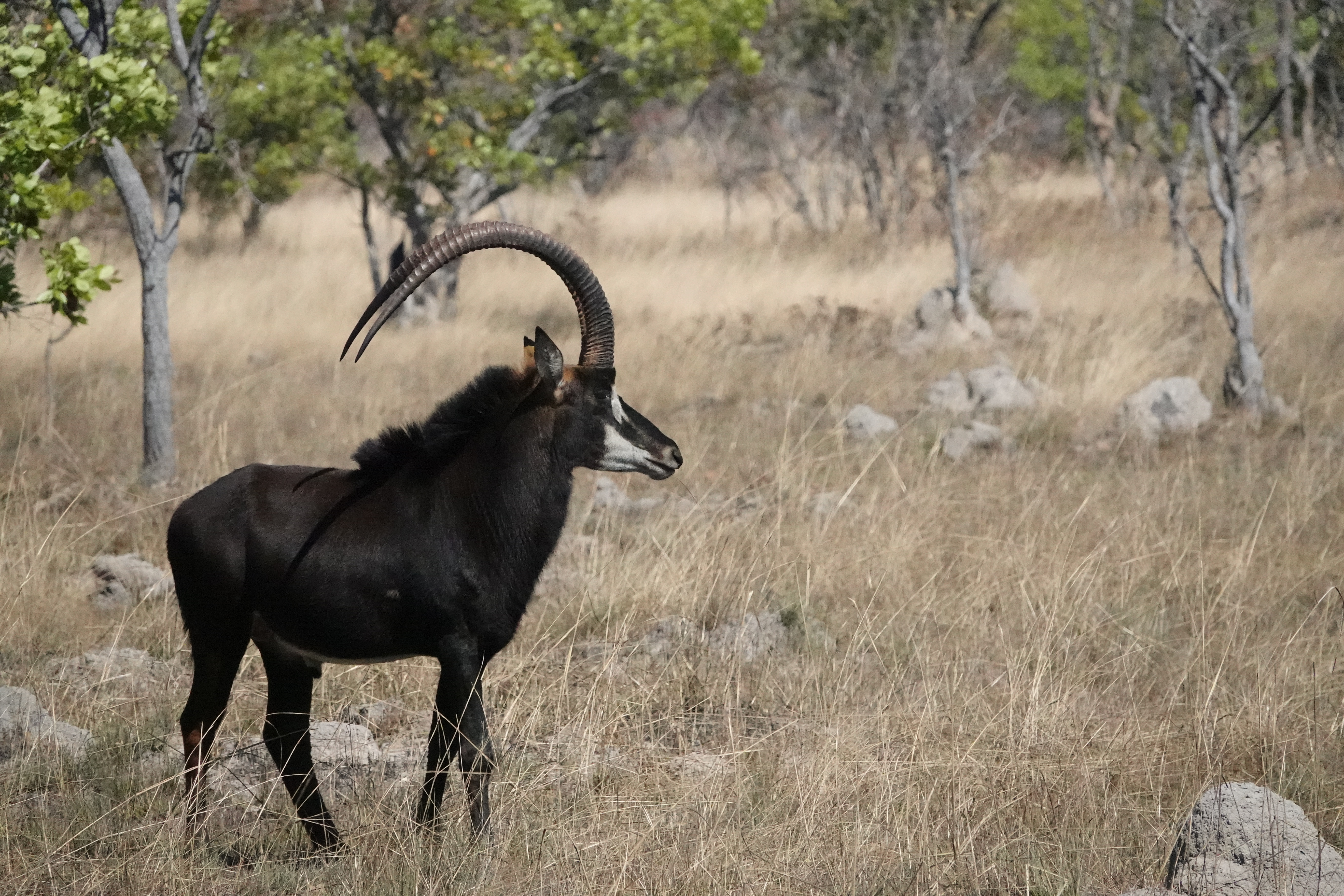
Mark and Miles decided to dedicated their final day in Kafue to either find a cheetah or a sitatunga. Unfortunately, they did not find either. But what they did find was undoubtedly stunning: a mature sable. If you compare the above photo to the one from Hwange, you’ll notice that this sable’s coat is nearly uniformly jet-black. There’s a reason sable are considered the most photogenic antelope in Africa!
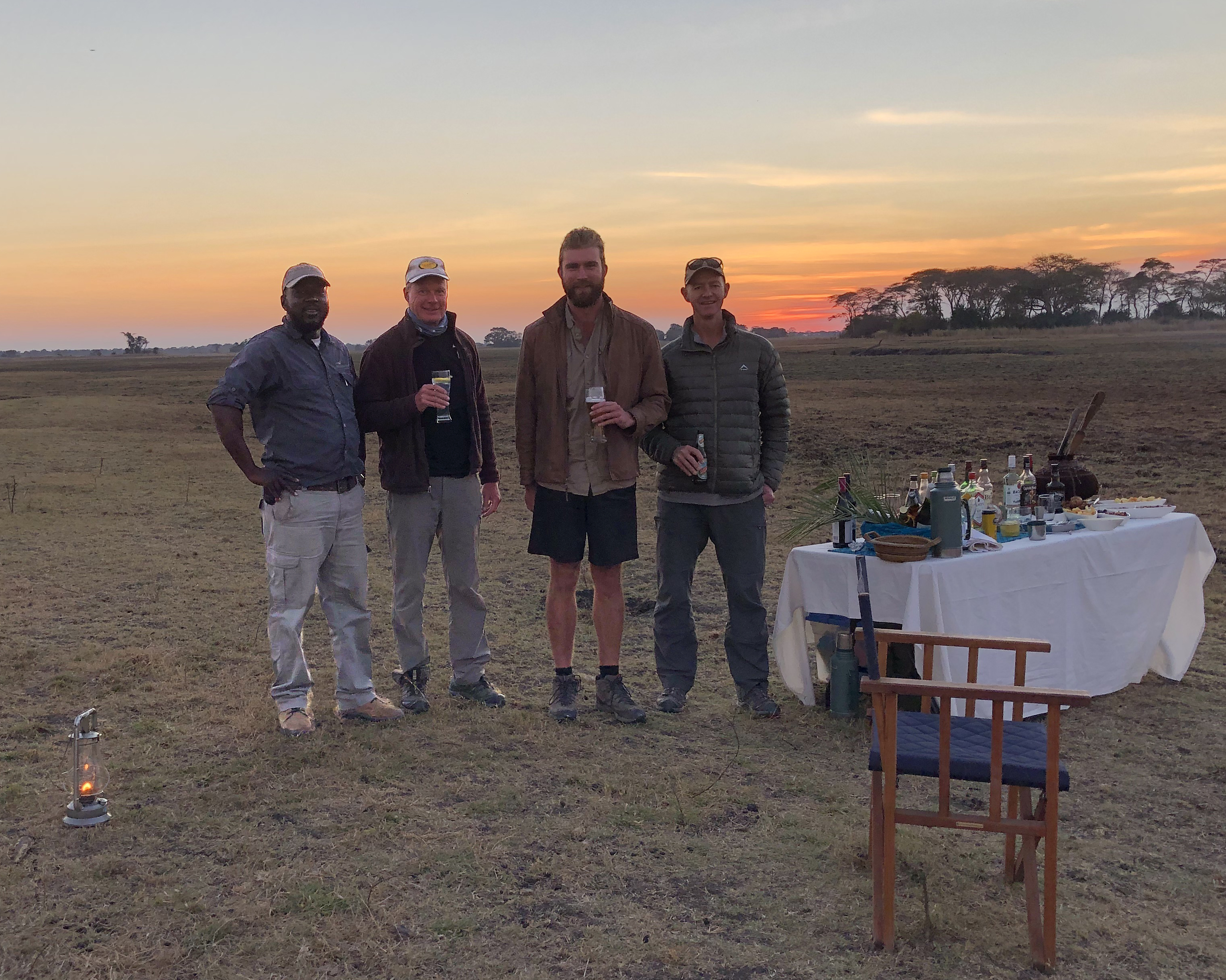
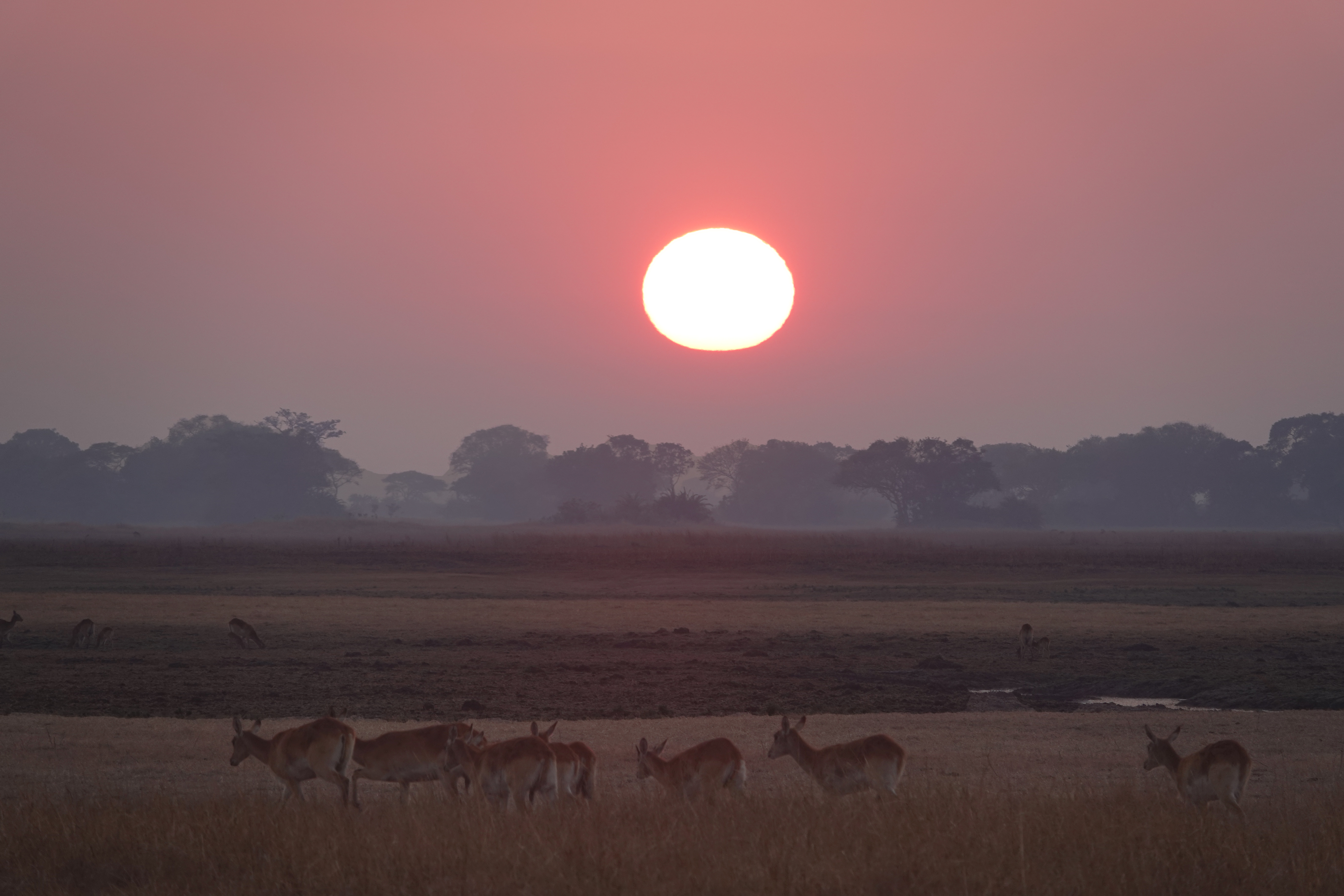
As the day and trip came to an end, Mark and Miles spent their last sundowner discussing their trip. Both have been on many trips to Africa in their lifetime, but the both agreed: this was, no doubt, one of their most favorite.
Safari Planning Questionnaire
To learn more about any of itineraries, destinations and/or accommodations discussed above, please fill out and submit the following questionnaire.

